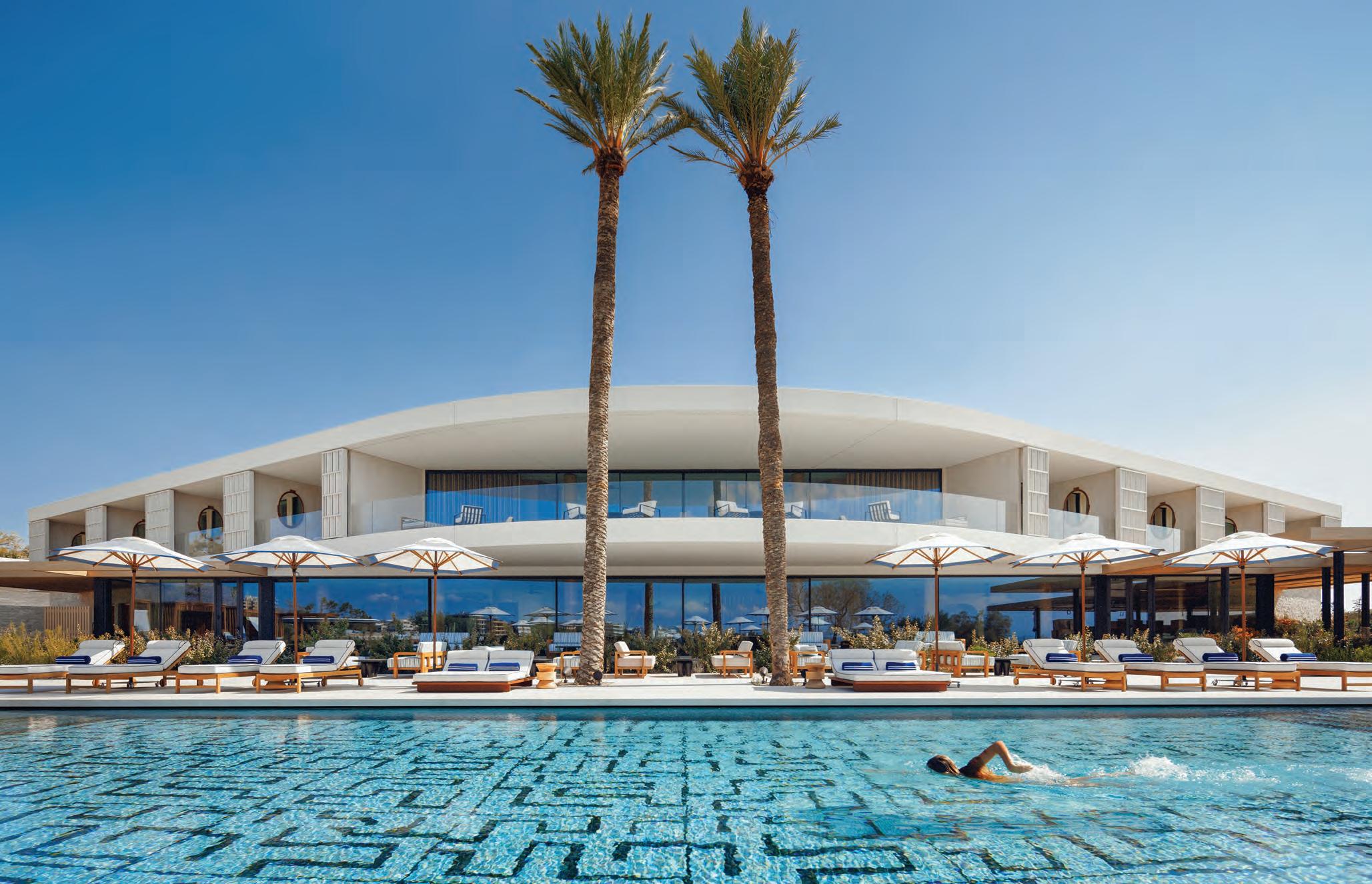TR AVEL, CULTU R E, GASTRONOMY & MO RE
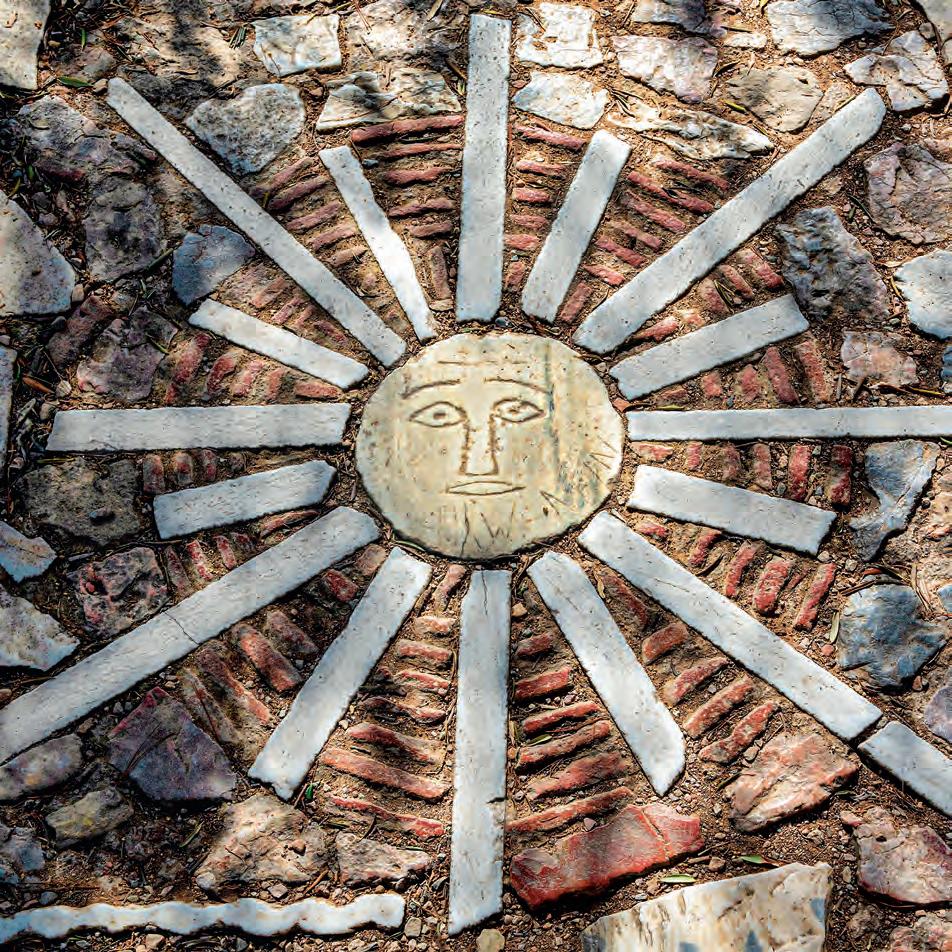
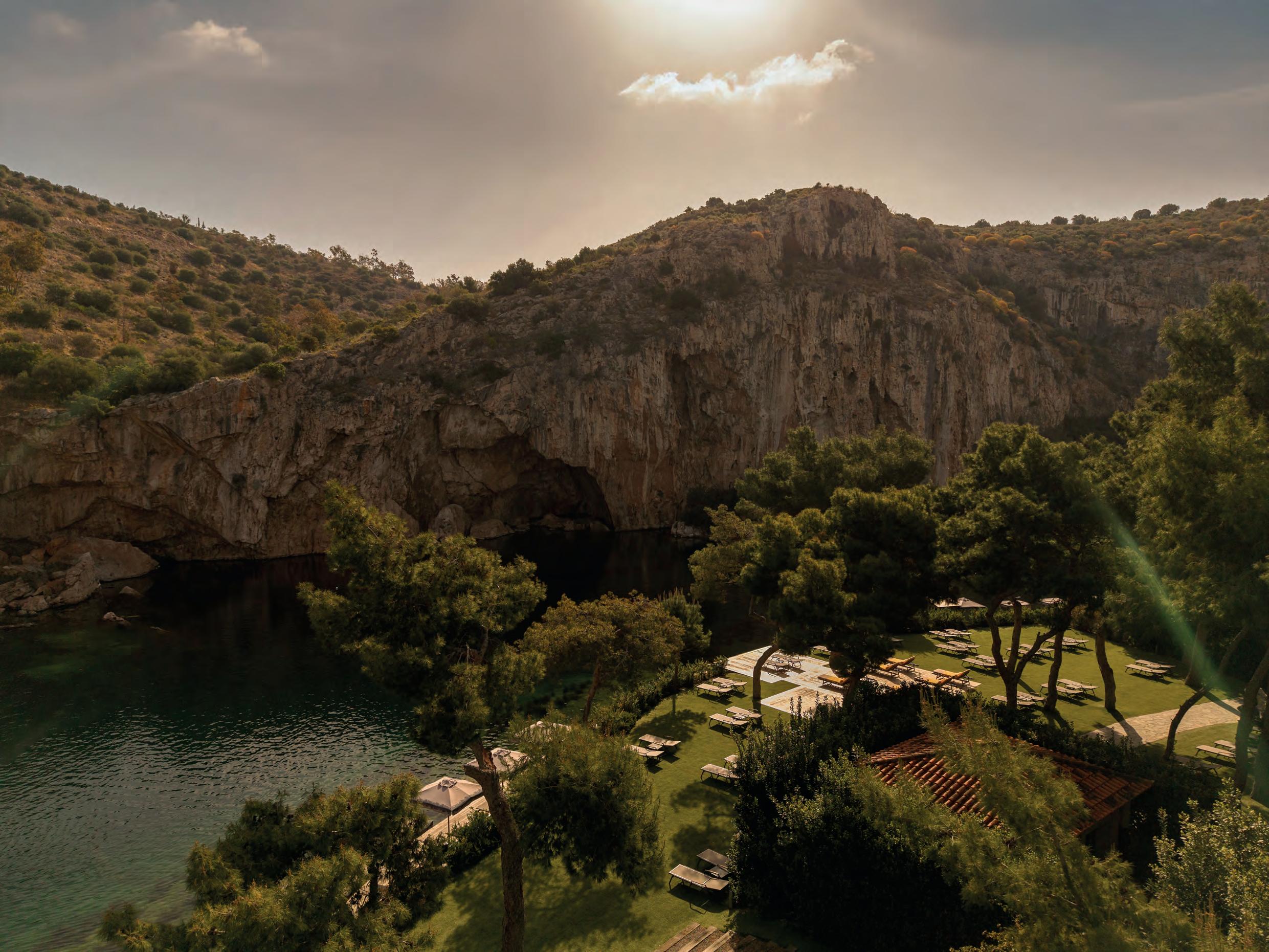

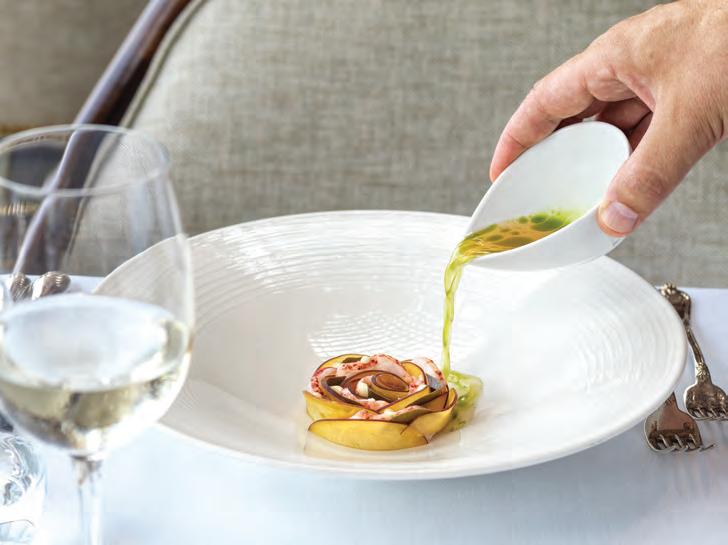
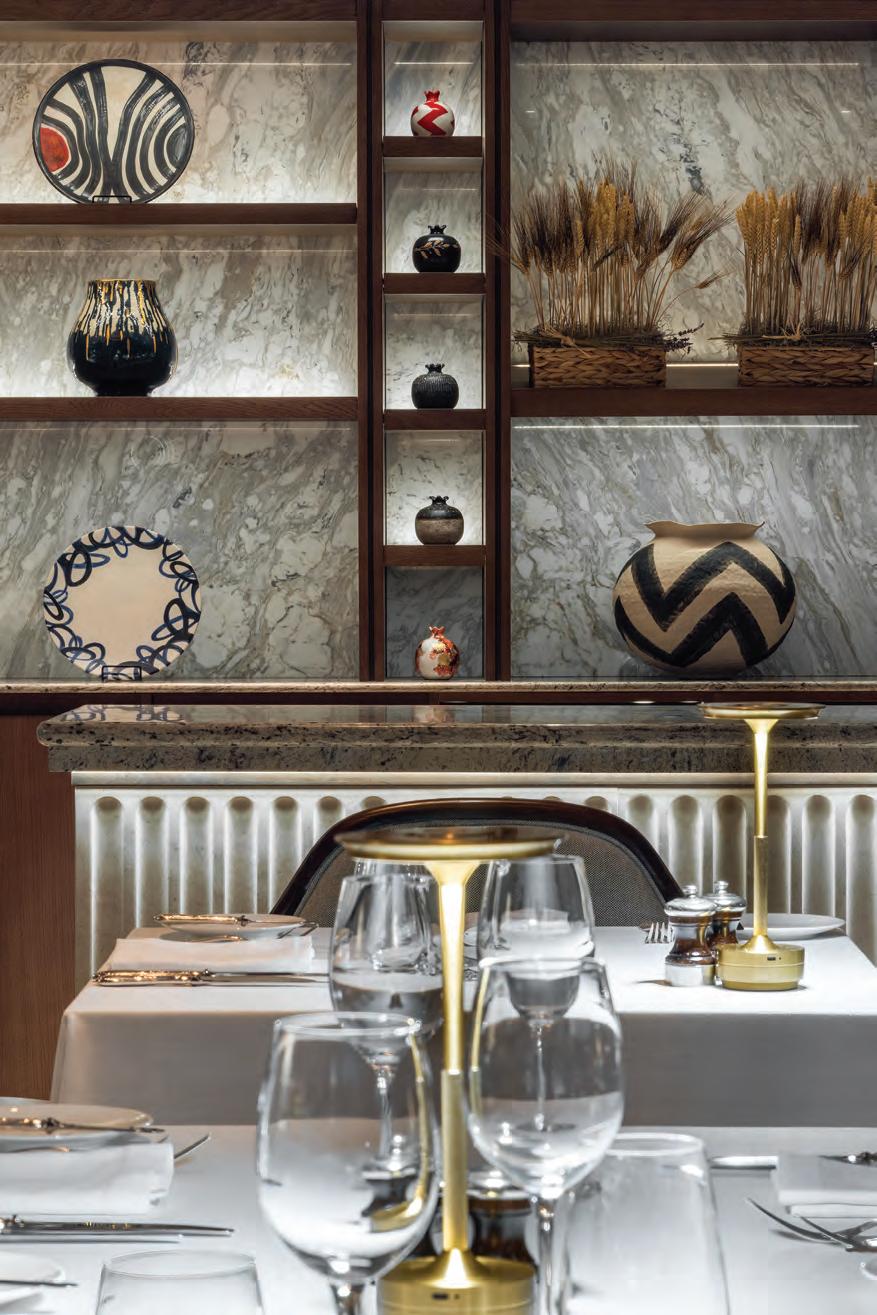
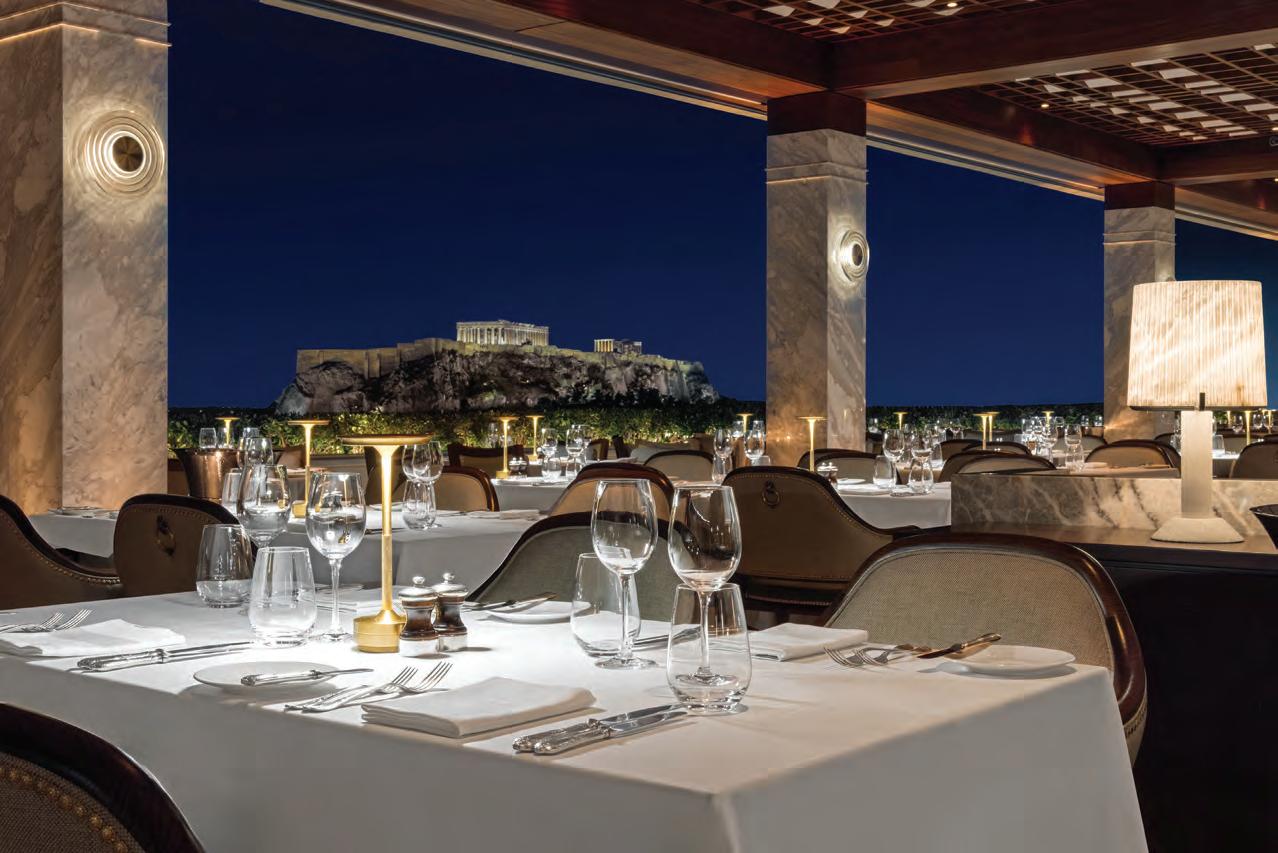


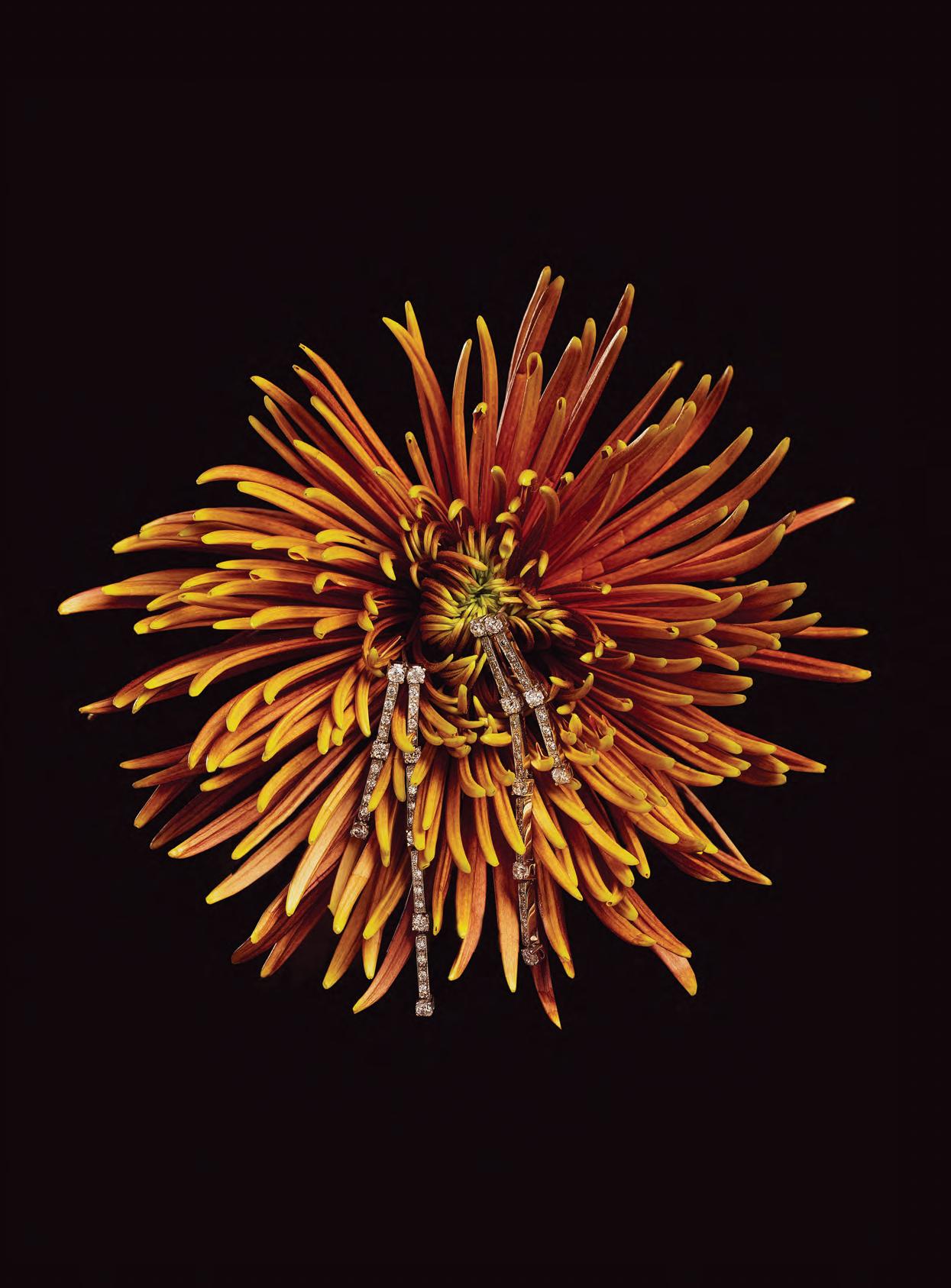










BY GIORGOS TSIROS
WHEN GREECE IS LAUNCHED IN 2015 , it was, in many ways, a form of therapy for ourselves. Greece was in crisis – economically, socially, symbolically. Unemployment was soaring. Athens bore the marks of unrest; it was a city of shuttered storefronts and an uncertain future. The international media painted a bleak picture.
We felt an urgent need to tell a different story. In English. For others, yes, but for ourselves as well. We wanted to rediscover and reframe what makes this country remarkable: its natural wealth and ancient heritage, its food and wine, its everyday creativity, and its global legacy – from democracy and the Olympic Games to the quiet, enduring virtues of Greek hospitality.
What began as a series of thematic print editions quickly found its audience. People responded to the content, the aesthetics and the tone. We still remember the joy of spotting our magazines in the hands of foreign visitors who had chosen, despite the dire headlines, to spend their vacations in Greece. Tourism was one of the few pillars holding up the economy at the time, but their presence was as much an emotional boost as it was a financial one. It reminded us that belief in Greece hadn’t disappeared.
A decade later, Greece is a country transformed. Athens, in particular, is unrecognizable from those early years. Visitor arrivals are breaking records. International hotel brands have flocked to the city. The capital has become a cultural destination in its own right. The challenges, however, haven’t disappeared; they’ve just shifted.
The center of Athens is grappling with its own success: the steady disappearance of traditional commerce in favor of cafés, boutiques and short-term rentals; pressures on infrastructure; and the ambivalence of residents caught between the Greek instinct to welcome visitors and the knowledge of the real impact those visitors have on their daily life.
According to the Annual Visitor Satisfaction Survey conducted by the Athens-Attica & Argosaronic Hotel Association in collaboration with the Athens International Airport and GBR Consulting, tourist satisfaction remains
high, with an average score of 8.3 out of 10, buoyed by the friendliness of locals and the city’s vast cultural wealth. Yet concerns are mounting. Cleanliness, accessibility, safety and housing affordability are becoming flashpoints. Some neighborhoods are thriving. Others are being hollowed out. It’s a moment of celebration, but also of reflection. As the city evolves, so must the conversations we have about it, but they must remain honest, open and informed as well. And so Greece Is enters its second decade. Still curious. Still committed. We’re here to observe, to highlight what deserves attention, and to share the joy of discovery, whether it’s a remote island taverna, a new museum in the city center, or a quiet street where jasmine still blooms at dusk.•
P.S.1 Our website, greece-is.com, just got a fresh new look. Come explore! P.S.2 A heartfelt thank you to all our distribution partners – especially to the Acropolis Museum – for helping bring Greece Is into the hands of readers around the world.
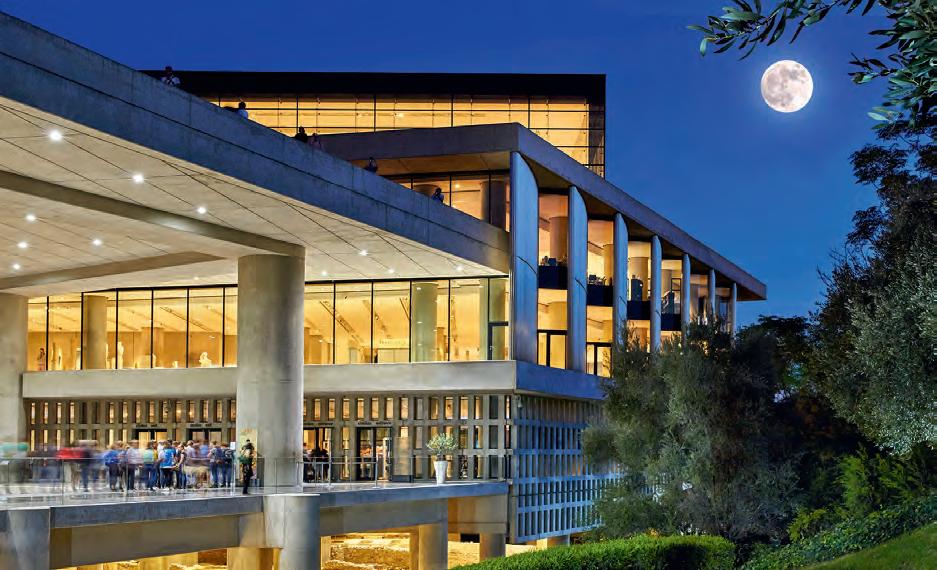
Every August full moon is a celebration at the Acropolis Museum –and this year, it’s happening on August 9. If you find yourself nearby, don’t miss it!

Moda Bagno Kitchen
Attica, Vrilissia
50 Anapafseos Street
Tel. 210 8036700
Moda Bagno Kitchen
Attica, Halandri 192 Kifisia Avenue
Tel. 210 6775080-4
Moda Bagno Kitchen
Attica, Alimos 81 Alimou Avenue
Tel. 210 9886333 / 210 9652680
Moda Bagno Kitchen
Thessaloniki, Pylaia 2 Kranidioti Giannou Street
Tel. 2310 431000
16 | C ITY NOTES
Where to go and what to see – your cultural compass for the capital.
46 | F AVORITE THINGS
Six Athenians, five picks each – no wrong turns.
52 | C ULTURE WALKS
Through itineraries both on and off the well-beaten tourist path, the city reveals its cultural secrets.
68 | N EW ON THE MENU
The city’s tastiest newcomers are here, and they’re already making noise.
78 | D INING BENEATH THE TREES
These spots offer a welcome reprieve from the heat of an Athenian summer.
88 | H EAD FOR THE HILLS
Ancient paths, shaded climbs and the best views in town, from Filopappou to Lybabettus.
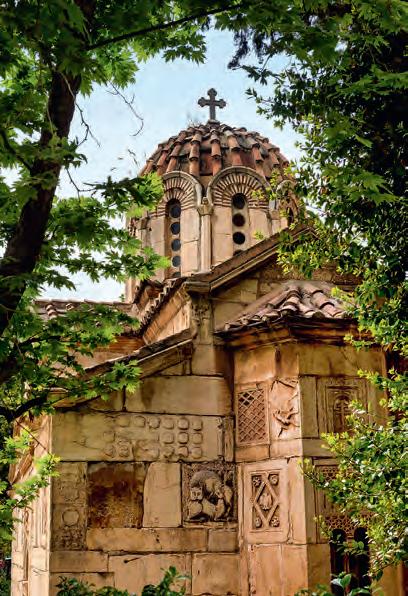

100 |
A weekend on the Saronic Gulf’s best-kept secret, where summer still feels like it did when we were children.
112 | VO ICES OF NOW
Across all genres, these musicians are reshaping tradition with bold sounds and fresh identities.
124 | N EOCLASSICAL ARCHITECTURE
From Greece to the World.



134 | S ACRED SPOLIA
Many of the city’s most beautiful churches were built in part with material from earlier structures.
144 | O MG (OH MY GODS!)
From temples to dinner tables, the deities were part of everyday life in ancient Greece.
154 | M T PARNITHA, THE GREAT REFUGE
Just 40 minutes from the heart of Athens lies the city’s beloved mountain.
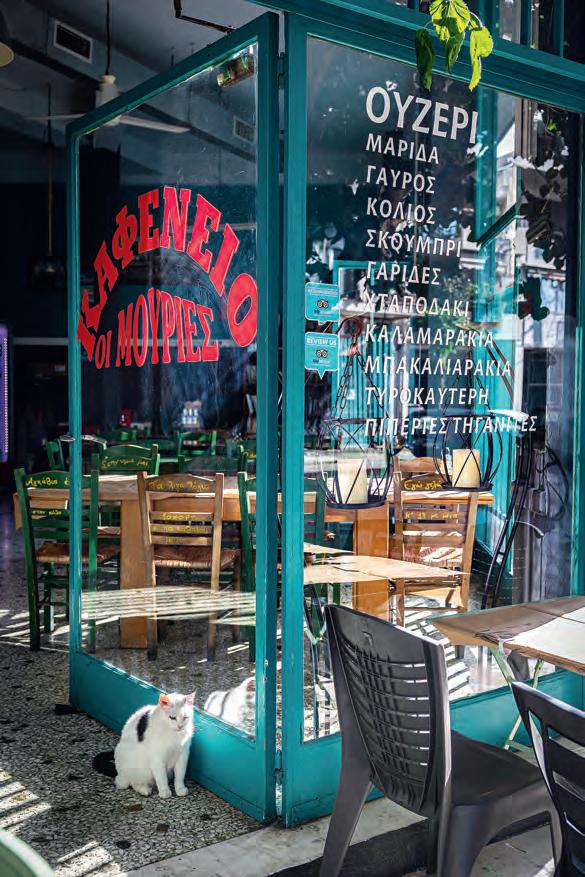
EXECUTIVE EDITOR
Alexis Papahelas
PUBLISHED BY:
Nees Kathimerines Ekdoseis
Single Member S.A. Ethnarhou Makariou & 2 Dimitriou Falireos, Neo Faliro, 185 47
Piraeus Greece
EDITOR-IN-CHIEF
Giorgos Tsiros tsiros@kathimerini.gr
DEPUTY EDITOR
Nena Dimitriou nenadim@kathimerini.gr
EDITORIAL COORDINATOR
Niki Agrafioti
ADVERTISING MANAGER
Kelly Lorentzou klorentzou@kathimerini.gr
COMMERCIAL INQUIRIES
Tel. (+30) 210.480.8227
Fax (+30) 210.480.8228 sales@greece-is.com emporiko@kathimerini.gr
PUBLIC RELATIONS welcome@greece-is.com
GREECE IS - ATHENS is a biannual publication, distributed free of charge. It is illegal to reproduce any part of this publication without the written permission of the publisher.
ON THE COVER
Detail from a path laid by famed architect Dimitris Pikionis on Filopappou Hill circa 1954, using salvaged materials. (Photo: PERIKLES MERAKOS)


8.,99€
4,99€
Fine wines for connoisseurs. Discover high quality wines full of aroma and taste at our stores and at Lidl prices

5.,99€
5,99€


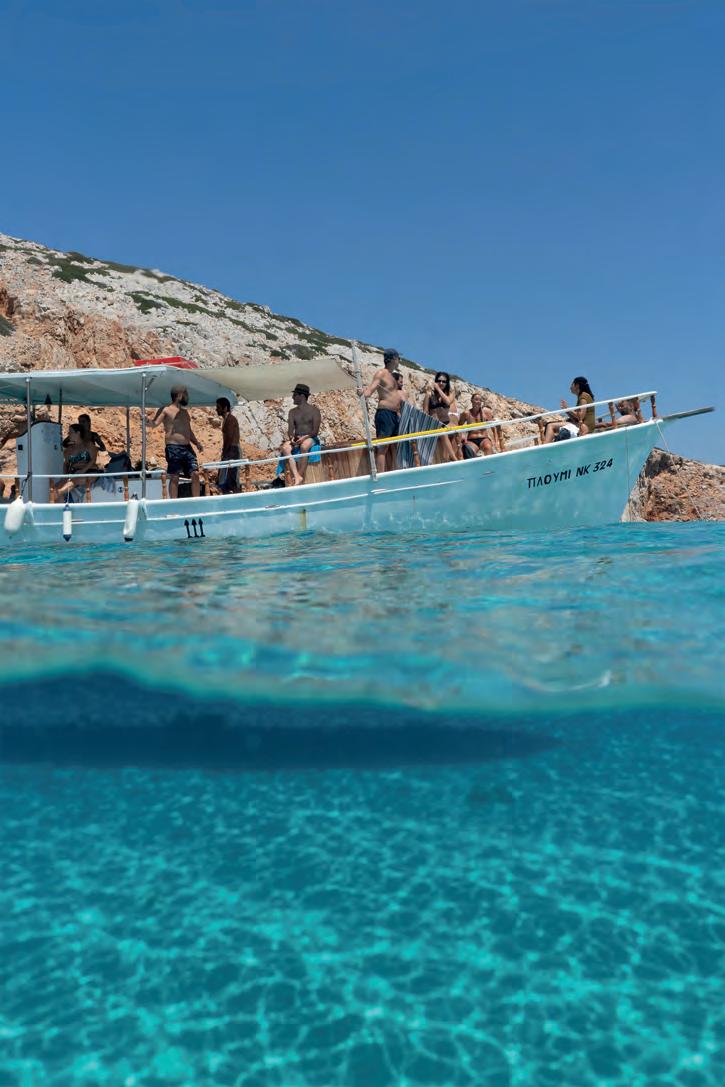


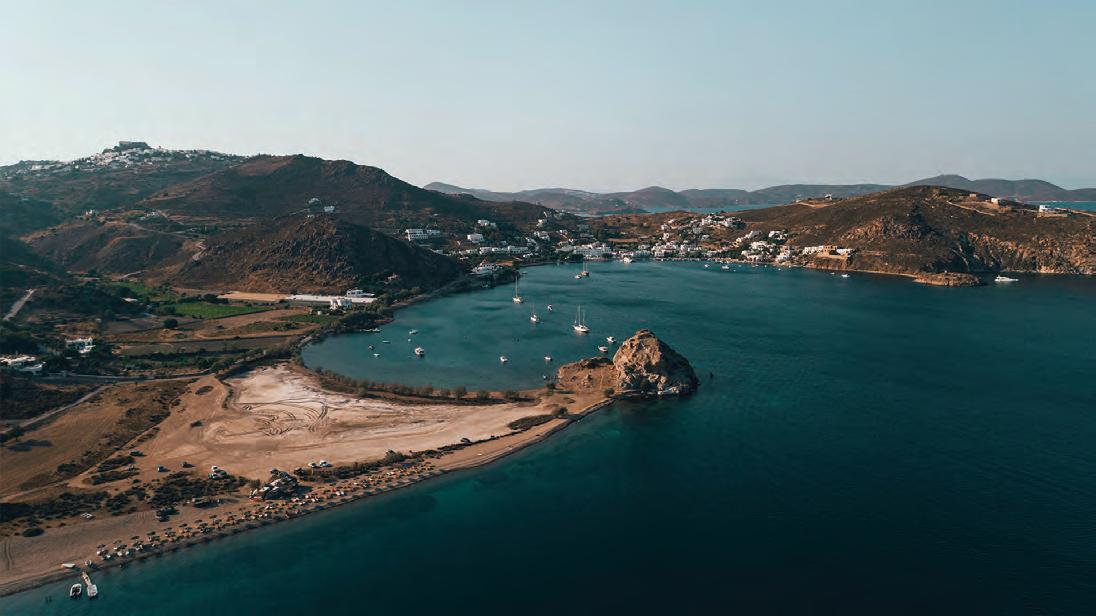
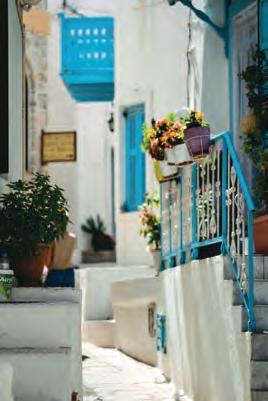
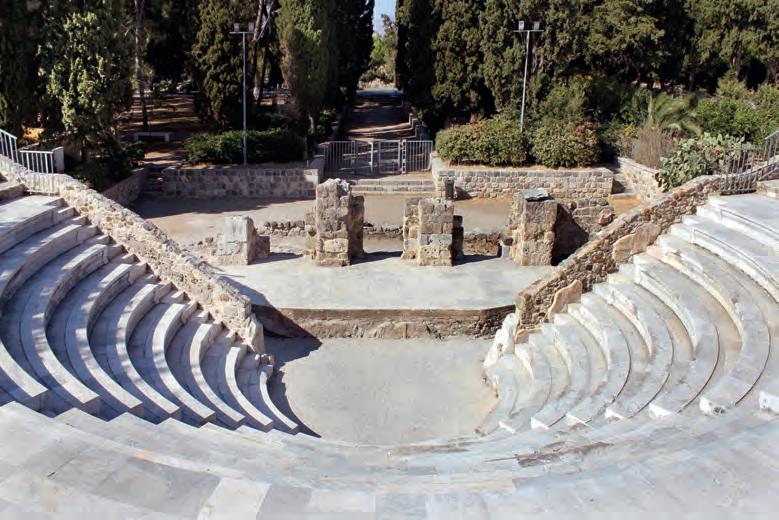


Where to go and what to see – your cultural compass for the capital.
BY THE GREECE-IS TEAM

IN THE SHADOW of the Sacred Rock stands the Acropolis Museum, inaugurated in 2009 and now one of the most visited museums in the world. Before ascending to the thirdfloor gallery – home to the remaining sections of the Parthenon frieze – visitors journey through centuries of history, exploring artifacts uncovered on the Acropolis slopes and dating from the Mycenaean era to early Christianity, including five of the six original Caryatids from the Erechtheion. Before leaving, return to the ground floor to explore the museum’s temporary exhibitions. Until October 31st, the space hosts “Allspice: Michael Rakowitz & Ancient Cultures,” a striking dialogue between the colorful, politically charged work of the Iraqi-American artist and ancient objects from the southeastern Mediterranean and the Middle East.
panagiotis koustas → theacropolismuseum.gr


RENOWNED FOR ITS permanent collection of minimalist marble figurines from the 3rd millennium BC, the Museum of Cycladic Art is at present also hosting a singular encounter between ancient artifacts and contemporary painting. On view until November 2, “Marlene Dumas: Cycladic Blues” unfolds across two floors of the Stathatos Mansion, one of Athens’ most iconic neoclassical buildings. The celebrated South African artist has put her paintings and drawings in dialogue with fourteen ancient objects, forming a meditation on the body, vulnerability and cultural memory. The short video shown on the ground floor, which features Dumas reflecting on the works and the ideas behind the show, serves as an intimate introduction to a quietly powerful exhibition. panagiotis koustas → cycladic.gr


SET ASIDE AT LEAST three hours; you’ll need that long to absorb this monumental exhibition, but it is time you won’t regret spending here. Taking over nearly the entire National Museum of Contemporary Art (EMST), from level -1 to the third floor, “Why Look at Animals?” has become the talk of the town, prompting visitors to reconsider how the idea of justice applies beyond the human realm. The works on view explore the complex co-existence between humans and animals, ranging from the bronze cats of Greek sculptor Euripides

Vavouris (1911-1987) to large-scale installations by Emma Talbot. A particular highlight is Janis Rafa’s thirdfloor solo show “We Betrayed the Horses,” a haunting, poetic installation investigating the relationship between humans and horses. panagiotis koustas → Until February 15, 2026. emst.gr


AT ONE OF TAKIS’ early exhibitions, a young John Lennon met Yoko Ono for the first time. A century after his birth, the visionary sculptor – whose works are housed in institutions from MoMA to the Pompidou, and whose magnetic signal sculptures greet commuters at Athens’ Syngrou-Fix metro station – is being honored with a major retrospective. Organized by the Basil & Elise Goulandris Foundation, the exhibition spans its museums in Andros and Athens. At the latter, located in the city’s lively Pangrati neighborhood, the focus is exclusively on his iconic magnetic works. The show runs through November 2. panagiotis koustas → goulandris.gr

At Alpha Bank, we believe that major tourism projects bring progress to all.
That’s why we have always stood by tourism businesses.
Stella Island Luxury Resort & Spa welcomes guests to a new world of luxury, offering a hospitality experience that exceeds the ordinary on every level. But this project is not only about tourism. It actively supports the local community and contributes to sustainable development, with deep respect for the area’s unique natural environment, a shared heritage that belongs to us all.
STELLA ISLAND
LUXURY RESORT & SPA Crete

PROGRESS HAS ITS OWN BANK
EXACTLY SIXTY YEARS AGO, an open-air theater opened atop Lycabettus Hill, quickly becoming a cultural landmark famed for unforgettable performances set against the sweeping skyline of Athens. Perched 277 meters above sea level in a natural hollow left behind by a quarry that operated until 1919, the theater reopened last year after a decade-long renovation. This season’s eclectic lineup includes Beth Gibbons, Jethro Tull (September 20), and Cretan music star Giannis Haroulis (October 4), among others. The easiest way to get there is by taxi, which will drop you right at the entrance. For the return trip, we recommend walking down the forested path to the ring road. From there, it’s a scenic 15-minute stroll to Kolonaki. panagiotis koustas
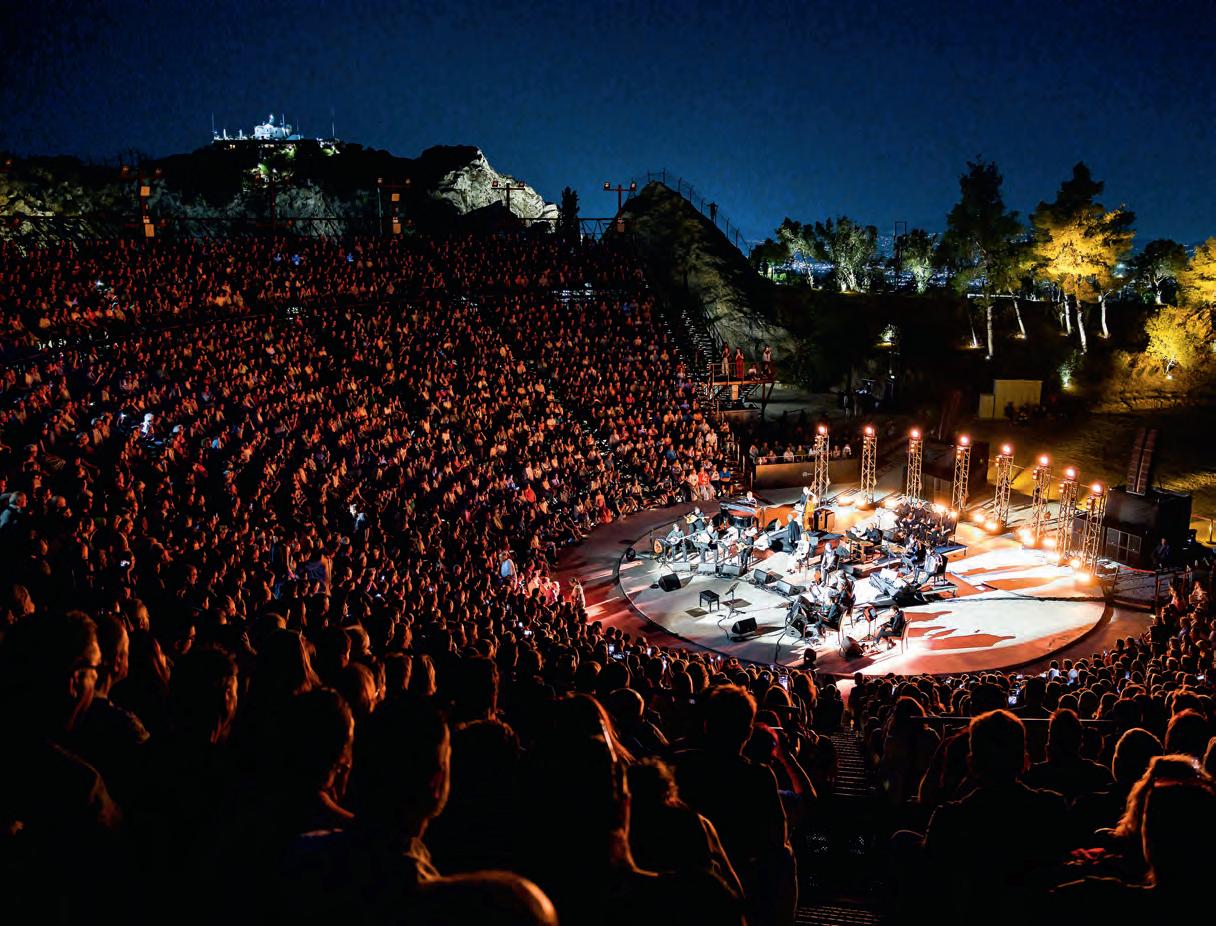


THE ELEGANT neoclassical townhouse – crisp white lines with bay windows and a soft flood of natural light – at 22 Anapiron Polemou, a quiet steep street in Kolonaki, has served as Gagosian Athens’ home for the past five years. The space, part of the global constellation of galleries founded by powerhouse art dealer Larry Gagosian, regularly hosts some of the city’s most compelling exhibitions. Until August 30, the gallery is presenting “A Telegram to my Dear Suki,” a solo show by Oscar Murillo,

featuring drawings, paintings and video from ongoing projects by the Colombian artist, who famously shared the 2019 Turner Prize with his co-nominees in a gesture of solidarity. panagiotis koustas → gagosian.com

TUCKED INTO the pine-covered slope behind Filopappou Hill – just across from the Acropolis and hidden among ruins and secret city paths – lies a littleknown open-air theater. Built in 1963 to host performances by the Dora Stratou Dance Theatre, this historic venue has now found fresh life through a new music festival. The Hill Sessions offer ten nights of live music by Greek and international artists, including a performance by Lena Platonos, a legendary figure of 1970s Greek avant-garde music.
giorgos psomiadis
→ grdance.org


IT’S HARD TO CAPTURE in a few lines everything that’s on offer at the Stavros Niarchos Foundation Cultural Center (SNFCC) for the casual visitor. Home to the National Library of Greece, the Greek National Opera, and one of the city’s most impressive parks, it has become one of Athens’ most vital hubs for culture, leisure and civic life, and it’s a landmark of sustainable design and public access as well. On Wednesdays until September 10, top Greek DJs take over the decks at the Lighthouse Terrace and the Canal. Expect global sounds, fresh vibes, and unforgettable sunsets. giorgos psomiadis
→ snfcc.org

Discover the Essence at Patmos Aktis, a Luxury Collection Resort & Spa, Greece, joining The Luxury Collection, part of Marriott Bonvoy’s portfolio of over 30 extraordinary hotel brands, in June 2025. Nestled in the serene Grikos Bay, Patmos Aktis invites you to immerse yourself in luxury with sophisticated beachfront accommodations and refined dining experiences at Cielo e Mare and Plefsis Tavern just steps from the Aegean. Step into the tranquil Anasa Spa and indulge in relaxation, where expert therapists await to rejuvenate your body and spirit. From memorable personalized events to guided island adventures, every moment at Patmos Aktis is meticulously curated to celebrate the extraordinary with grace.
EXPLORE THE DESTINATION AT WWW.PATMOSAKTIS.GR
IMAGINE, IF YOU WILL, watching the classic Western “For a Few Dollars More” on a basketball court under the stars. That’s just one of the unexpected moments you might experience at the Athens Open Air Film Festival. Since 2011, the festival has been transforming the entire city into an open-air cinema, offering free screenings of popular films in some of its most iconic –and some of its most unlikely – locations. From archaeological sites and neighborhood squares to basketball courts and industrial buildings, each screening takes place somewhere different, inviting you to see Athens anew, one frame at a time. Expect everything from silent films with live musical accompaniment to restored classics, world premieres, and new gems from the Greek indie scene. Whether it’s your first time in the city or your hundredth, the AOAFF is a rare opportunity to fall in love with both cinema and Athens in the most unexpected corners. pandelis tsompanis → aoaff.gr


BOU-ZOU-KI
IF YOU TRAVELED TO Athens by airplane this summer, chances are you were greeted by the unmistakable sound of a bouzouki as you stepped into the arrivals hall at Eleftherios Venizelos Airport. This subtle, musical welcome to Greece is part of a project that rethinks some well-known works.
“Bou-zou-ki” is the latest release by Ermis, a talented Greek neoclassical composer and pop producer, who reimagines seven iconic classical pieces – from Debussy and Schubert to Chopin, Mozart, Barber and Saint-Saëns – through the unmistakable voice of Greece’s most emblematic instrument, the bouzouki.
Far from parody or pastiche, the result is a dreamy experience that’s part cinematic, part folkloric and entirely sincere. The album asks, “What would the music of Debussy and Schubert sound like if they had met composers like Xarhakos or Zambetas and fallen in love with Greece?”

It took two full years to complete just 16 minutes of music. During that time, Ermis listened exclusively to classical works and traditional Greek recordings, deconstructing and reassembling, until he found the ideal soloist for his compositions: bouzouki virtuoso Thodoris Xintaris.
“The release coincided with my 30th birthday,” Ermis says, “marking the beginning of a new chapter. After years of exploring different paths in music, I now feel more grounded than ever: choosing the essential over the excessive, starting each morning with a swim, splitting my time between Athens and Chios. Still learning. Still dreaming. Still devoted to scoring the modern Greek experience.” vlasis kostouros


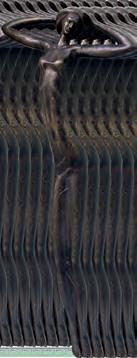

13, Mitropoleos Str., 105 57 Athens - Greece. Tel.: +30 210 323 3534 info@kori.gr / www.kori.gr


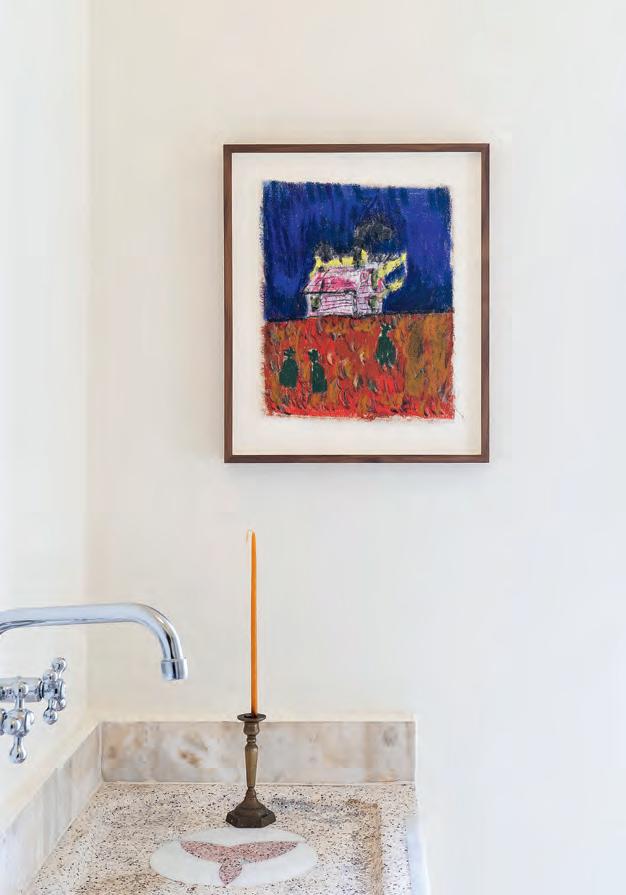
ONCE A LIVELY downtown neighborhood that slowly faded into residential quietitude, Kypseli is once again bursting with cultural and culinary energy. Housed in a 1920 neoclassical residence beside the Pedion tou Areos Park, Ninetto Gallery, which takes its name from Ninetto Davoli, the lover and muse of Italian director Pier Paolo Pasolini, is a new star on Athens’ contemporary art scene. Founded by Romain Bitton and Fred de Schonen, the space hosts exhibitions, residencies and international collaborations that favor storytelling, wit and subversion.
On pedestrianized Fokionos Negri Street, Topa is a spirited newcomer that blends the feel of a Cretan kafeneio with that of Basque country eateries. The menu items, drawn from the culinary tradition of both regions, are made for sharing and come paired with excellent wine, vermouth or spirits. “Topa” means “cheers” in Basque, and that’s the energy here: honest food, good music and a room full of strangers becoming friends.
At 40 Ithakis Street, a former pastry shop is now one of the city’s most atmospheric cocktail bars. Teleion has old fridges repurposed as countertops, lovingly crafted drinks, soft lighting and entrancing music, all working together to charm you.


WITH RETRO VIBES, 1950s flair, and a vinyl-only soundtrack spinning soul, jazz, rock, and experimental house, Bar Ideal (8 Kiafas) – also known as Not in Athens – is all about the art of listening. Tables spill out onto the sidewalk where patrons share stories, drink in hand. The newest addition to the ever-lively Exarchia neighborhood, it’s already been embraced by local music lovers as if it had been there forever. More than just a bar, it channels the spirit of the classic European listening room: come for the music, stay for the signature cocktails, good street energy, and soon, delicious finger food. georgia fekou



Created softly by hand, in the sacred lands of Thessaly, where myths breathe life, each piece from the Archangel Collection is infused with soul, intention, and the quiet magic of human touch.
At Olor, we believe handmade jewelry carries more than beauty; it carries a heartbeat, a story, a bond between creator and wearer. Wearing these wings isn't just adornment; it's a personal ritual. A gentle reminder of your strength, your authenticity, and your freedom. Handcrafted with soul in Greece, worn by those who carry their own light.
Awaken your inner guardian and feel connected to something beautifully human yet deeply divine.




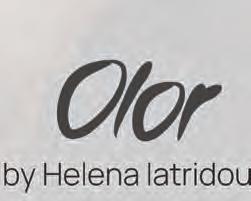





BEHIND BUSY Michalakopoulou Avenue, in the low-key Ilisia neighborhood, Maiandrou Street has quietly emerged as one of Athens’ most promising micro-scenes, with three venues that together create an unexpected party atmosphere. At number 5, Junior Does Wine redefines wine culture with an accessible, relaxed and unpretentious approach. A younger crowd gathers here, sampling glasses from both Old and New World vineyards, chatting on the sidewalk or leaning against the counter inside. Next door, at number 7, Quinn’s invites you into a space dominated by a large reproduction of

Hieronymus Bosch’s Garden of Earthly Delights that hangs behind the elegant wooden bar as a visual hint at what’s to come. The cocktail list is thoughtfully curated; from the sharply executed Dry Martini to the smoky Timorous Beasties and the heady, tropical Venus in Furs, each drink feels like a small but deliberate transgression. Finally, a few steps further, Tsimpouri at number 9 sets an intimate and effortlessly warm tone with a marble bar, friendly faces, and signature drinks such as the Ginger Pergamondo and the Sherry Mule. It’s the kind of place that is destined to become your go-to bar.
An unforgettable dining experience at Milos featuring the freshest ingredients and the renown fish direct from our islands. Simple, healthy and authentic cuisine in an elegant, sophisticated and yet comfortable and relaxed environment.
Greek hospitality at its best!
3-5 Kolokotroni Str. 105 62 Athens Greece T +30 216 600 3320 | athens@estiatoriomilos.com
Sail with us in the blue waters of the Greek seas. Our chef Nikos Kontogiannis and long time captain Sifis Kontorinis together with our the eight crew member of Milos yacht promisses you an unforgettable taste of the Greek islands in the Aegean or Ionian Sea.
Let us pamper you!
For more information please call at +30 6937 114 180 or asotiriou@estiatoriomilos.com






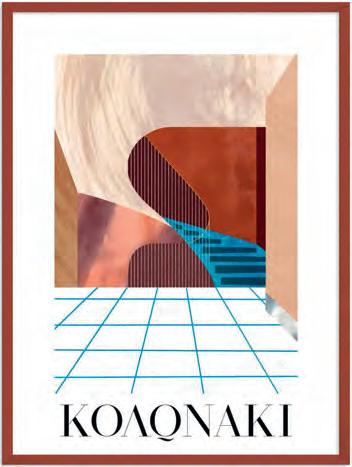


NEXT TIME YOU find yourself waiting at a crosswalk in Athens, take a moment to look up. That’s exactly what illustrator Yiannis Tsionis did, and from that simple act of observation came “Ktismata,” a series of prints capturing the city through its often-overlooked facades.
Rather than focus on landmarks, Tsionis turns his gaze to the unnoticed: an apartment block bathed in warm light, a washed-out pink exterior, a geometric balcony casting perfect shadows. “These are corners of the city we often pass by,” he says. “Buildings that carry memory, atmosphere, and the real, everyday identity of Athens.”
Across seven drawings, Ktismata distills quintessential elements of Athenian architecture: the symmetry of the former Hilton Hotel, the soft curves and polished details of midcentury apartment buildings, and the high-rises that have quietly shaped the city’s visual language. pandelis tsompanis → The collection is available via Instagram @ktismata and at etsy.com
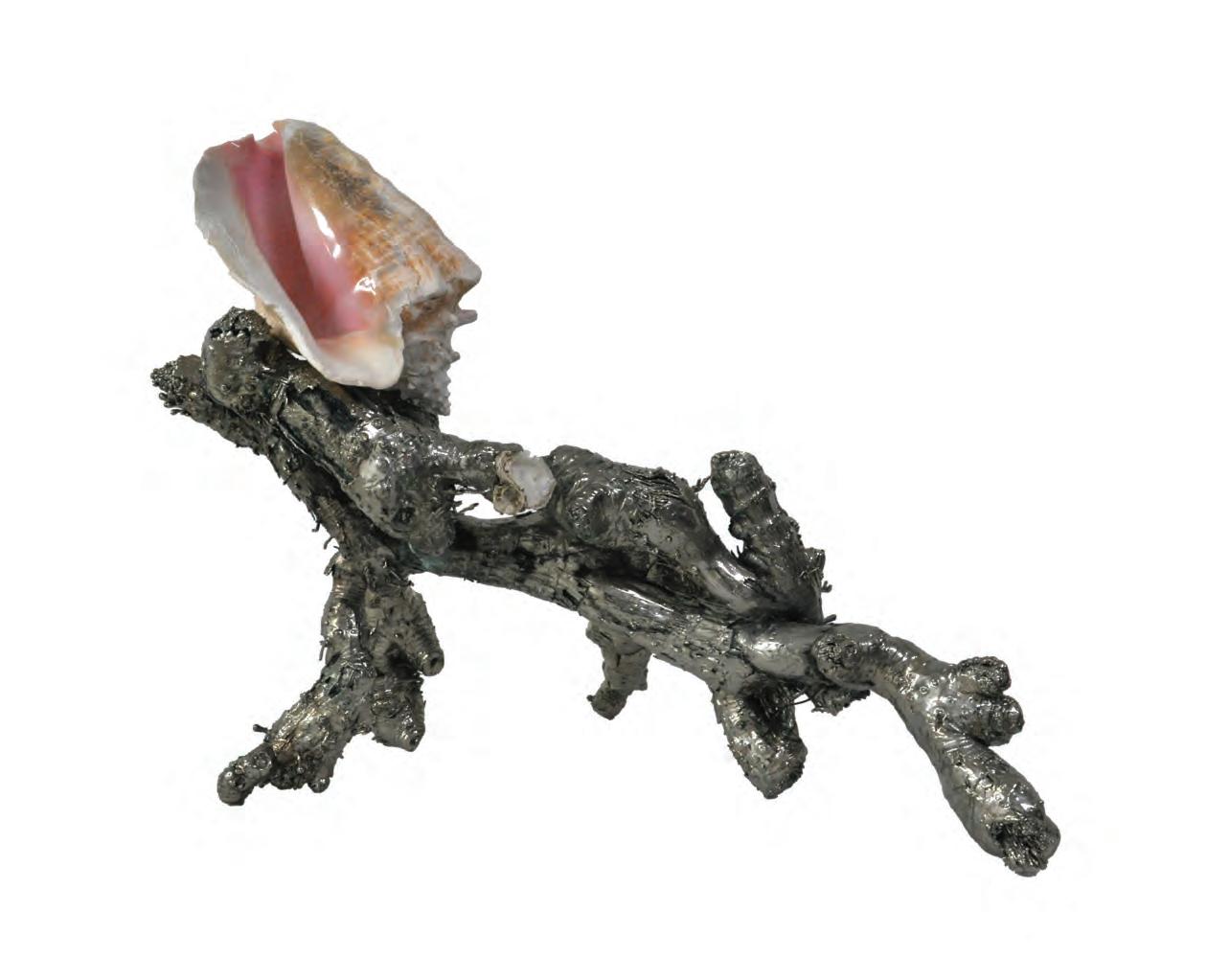
A CAR FAN RIGGED above an engine to cool it down, a classical column reimagined as a public ashtray, a DIY washing machine made from plastic tubs on the beach in Gavdos: these aren’t art installations, they’re snapshots of everyday ingenuity, captured in “Travelogue Vol. 2: Greek Everyday Solutions to Common Problems,” the second volume of a photographic project by Papairlines (Vasso Asfi, Kostas Bisas and Loukas Angelou).
With wit and warmth, the trio documents Greece’s spontaneous, often eccentric art of problem-solving. From the side streets of Athens to camping sites on remote islands, the images reveal a form of creativity born of necessity, habit or whim. There are no props and no filters, just the raw, improvisational genius of real life.
Dozens of photographers from Greece and beyond contributed to this offbeat visual travelogue, capturing a parallel, more playful dimension of Greek reality. pandelis tsompanis → The book is available at Hyper Hypo 10 Vorreou, hyperhypo.gr




www.ammos-athens.com
The iconic Athenian Riviera retreat is back, offering effortless elegance and a world of curated pleasures.
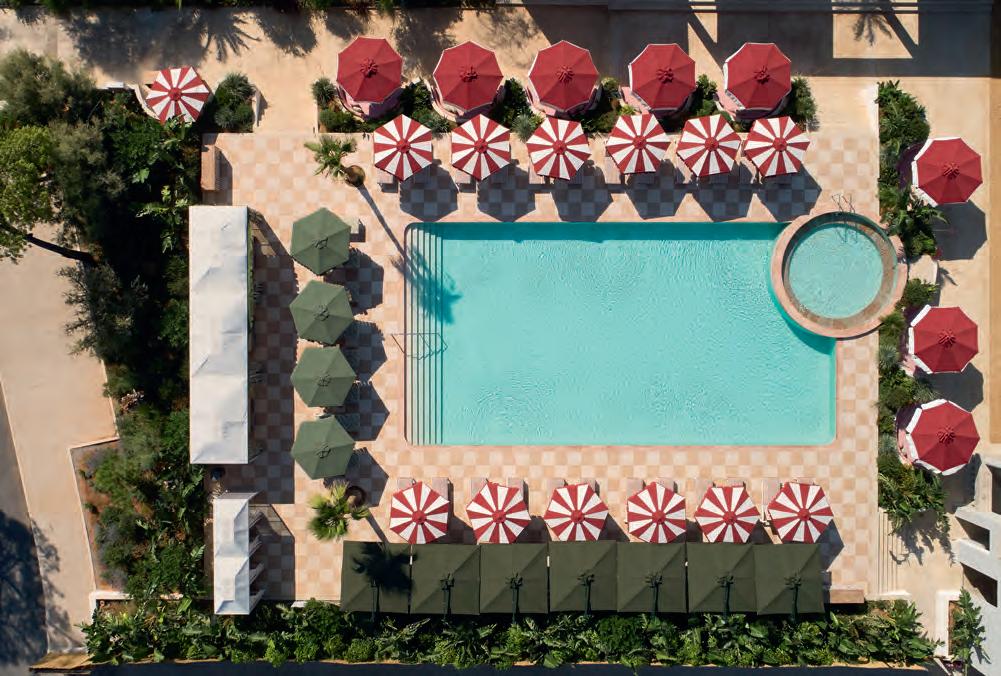
SINCE ITS GOLDEN-ERA DEBUT IN THE 1950 s , Asteria has stood as a shimmering emblem of Athenian glamour – a gathering place for international jet-setters, cultural tastemakers and luminaries drawn to its seaside allure. More than a destination, it became a way of life: refined, radiant and endlessly captivating. Today, that legacy is reborn.
Nestled along the storied shores of Glyfada, the newly refreshed Asteria invites a new generation of travelers into a world where timeless elegance meets contemporary sophistication. Every aspect, from the architecture to the atmosphere, echoes its illustrious past while embracing the desires of the modern wanderer.
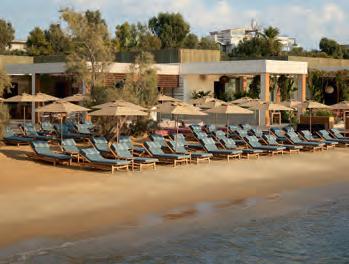
Here, sun-drenched days unfold beneath burgundy-striped umbrellas that ripple in the breeze. Gentle waves kiss the shore as guests lounge by an immaculate pool with uninterrupted views of the Saronic Gulf. At Bungalow 7, global flavors come alive in a vibrant dialogue with the sea, while Ark offers a relaxed yet refined allday escape for lovers of Greek and Mediterranean cuisine.
As dusk descends, head up to the Rooftop Bar for a glass of wine and some artfully crafted bites, or sip a signature cocktail as the horizon melts into a palette of blues and golds. This is Asteria – where every moment feels unforgettably blissful, and the Athenian Riviera is once again in full bloom. n
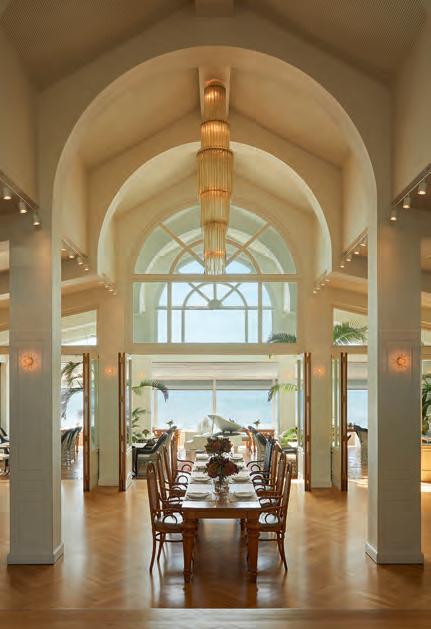






Creative Head Baker, 72H Artisanal Bakery
1. Athens is teeming with art galleries, but my current favorite is the Alekos Fassianos Museum in Metaxourgio (15 Neofitou Metaxa), housed in a beautifully restored building and offering a rare glimpse into the visionary world of Fassianos.
2. The island of Spetses is just two hours from Piraeus by hydrofoil, and it’s always worth the trip. Its crystalclear waters, pine forests and timeless architecture make it an ideal escape.
3. For a relaxed evening under the stars, head to +2H, a rooftop retreat above Ergon Bakehouse (27 Mitropoleos & Patroou). The menu is a love letter to carbohydrates: slow-fermented pizzas, hand-crafted pasta and creative comfort food.
4. Tucked away in one of Athens’ still-ungentrified neighborhoods, Petek Pastry Shop (81 3is Septemvriou) is a nostalgic haven of traditional and ’90s-inspired sweets. I never leave without their plant-based dark chocolate gaufrette.
5. I always make time to support local fashion wherever I travel. Para Todos (50 Perikleous) and Mohxa Clothing (59 Zoodochou Pigis) in Exarcheia are two standout brands in Athens that blend streetwise style with thoughtful design.
BY GEORGIA FEKOU
Contemporary Curator
Artistic Director, B&M Theocharakis Foundation for the Fine Arts & Music
1. The Yannis Tsarouchis Foundation (28 Ploutarchou), once the artist’s own home and studio, is my favorite cultural spot in Athens. It feels as if Tsarouchis has just stepped out for a moment, and his paintings and everyday objects have been left to tell his story.
1. Cultural experience
2. For a swim nearby
3. Night out
4. Guilty (edible) pleasure
5. Shopping tips
2. Each rocky cove in Vouliagmeni has its own appeal. I first discovered them through my grandmother, who still swims there almost daily in the summer.
3. A great night out begins with art, whether it’s a new exhibition opening or a visit to a gallery. Dinner at FITA (1 Ntourm) in Neos Kosmos is always a good idea. After that, you’ll either find me at Odeon (19 Markou Mousourou), my favorite bar, or at Abstract (10 Arktinou).
4. There are two things I adore: ice cream and my rescued chihuahuas. Maraboo (17 Archelaou) combines both with their decadent flavors and special doggy ice cream bites!
5. I love discovering unique things. Nouveaux Vieux, an online vintage store curated by Greek musician Olina, is a goldmine. I also adore ABLOOM (32 Archelaou), a stylish flower shop with incredible aesthetics.



«Greek Roots is a family-run jewelry house, founded in 1975 by Vasilis and Marianna Nikolaidis in Athens. Inspired by the timeless beauty of ancient Greece, our creations reflect symbols of mythology, heritage, and artistry—handcrafted in 925 sterling silver and gold. From Meanders and olive wreaths to goddess coins and rosettes, every piece tells a story. Now led by their son George, designer and craftsman, Greek Roots continues its legacy with a workshop open to the public and a global e-shop, sharing the magic of Greek culture with the world.»

1. One of the oldest live music venues in the city, Gagarin 205 (205 Liosion) consistently delivers. Its energy is unmatched, and the lineups are always razor-sharp. The last time I was there, Fu Manchu and Warmduscher brought the house down.
2. Just about an hour’s drive from Athens, Alepohori is home to a gorgeous bay and one of the best beach bars I’ve come across: Cariocas. The vibe is lowkey magic – sandy feet, strong drinks and guest DJs who know what they’re doing. Get there early to grab a spot and settle in.
3. Kick off the night at Radar (22 Kotzia) with some of the best vinyl DJs in the city and cocktails that hit the right note. Then head to Lulu (57 Ippokratous) for more drinks. Hungry? Grab a slice of American-style pizza at its finest at Giant (21 Georgiou Olympiou) or go upscale with a table at ParkBench (10 Pramanton)
4. The American cheesecake at Portatif (21 Sina) is pure decadence. I always eat one there and grab two more to go. No regrets.
5. For streetwear, the Ministry of Concrete (3 Athanasiou Axarlian) always delivers. But to be honest, most of my budget goes to vinyl. My go-to spots: Kasseta Records (5 Sofokleous), Dum Dum Records (3 Proklou) and Entropia Records (68 Ithakis). Each one’s got its own groove.


Creative Director, Founder of Hydra Edition
1. Cultural experience
2. For a swim nearby
3. Night out
4. Guilty (edible) pleasure
5. Shopping tips
1. The former home and studio of Panayiotis Vassilakis (aka Takis) (Dervanakion Terma) is now a foundation devoted to his visionary work in kinetic art. This year marks the centenary of his birth, making it the perfect occasion to explore his world of magnets, motion, and sound.
2. Only a short ferry ride from Athens, Hydra is timeless. No cars, no noise –just cliffside dives, long seaside lunches, and hours that pass by unnoticed. When I stay in the city, I love Lemos Vouliagmeni. The waters are crystalclear and the pines reach the shore; it feels like nature’s nudged the city aside.
3. Once a garage, Voulkanizater (17 Odissea Androutsou) is now a hidden urban sanctuary with relaxed energy, fresh faces, and great food and drink. For a touch of old Athens, I head to Rantevou (8 Arkadon) – part kafeneio, part mezedopoleio, and entirely steeped in nostalgic charm.
4. There’s something innocent and joyful about hot loukoumades topped with cold soft-serve ice cream and drizzling with honey. Krinos (87 Aiolou) downtown always delivers the goods.
5. The Museum of Cycladic Art Shop (4 Neofitou Douka) is a haven of design, with items that blend modern aesthetics and timeless craftsmanship. I also adore Athinas Street, a patchwork of spice shops, hardware stores and humble everyday treasures.


Sommelier at Oinoscent, Wine Importer
1. My favorite cultural venue is the Greek National Opera, which has been housed at the Stavros Niarchos Foundation Cultural Center since 2017. With its grand hall and the more intimate alternative stage, it offers a program of opera and ballet that’s visually and emotionally captivating – an ever-evolving tribute to timeless classics.
2. For me, nothing compares to the “Rock” at Kavouri: no sand, no beach –just the rocks, the sea and the endless sunsets. It feels like a well-kept secret, even though it isn’t.
3. The perfect evening starts with a glass – or bottle – of wine at Oinoscent (45-47 Voulis) and usually ends at 7 Jokers (7 Voulis), a bar that’s iconic in all the right ways.
4. I’ve got a sweet tooth, so Anastasia’s éclairs (23 Neftonos) are just the thing. The patisserie is only a short drive from home and always worth the visit.
5. I have a soft spot for rings – there’s really no such thing as too many. My favorite designer is Daphne P. Blots, whose creations can be found at Marianna Petridi Jewelry (34 Haritos) in Kolonaki. Elegant, sculptural and just the right kind of bold.
1. Cultural experience
2. For a swim nearby
3. Night out
4.
Guilty (edible) pleasure
5. Shopping tips
Co-owner, Foyer Espresso Bar
1. These days, I always catch the exhibitions at Gagosian (22 Anapiron Polemou). The gallery is housed in a neoclassical mansion that is a destination in itself, and the quality is consistently exceptional.
2. The pier at the Nautical Club of Vouliagmeni Residents (4 Poseidonos), which is located directly in front of Bluefish Restaurant, is one of my favourite hidden spots. Locals and water sports lovers gather here for a quick dip. It’s ideal for a midday swim or a refreshing pause before lunch.
3. I like to begin with a dry martini and a Cretan borek at the elegant bar inside the eatery Pharaoh (54 Solomou). From there, it’s a short walk to Au Revoir (136 28is Oktovriou), a true Athenian classic dating back to 1958. Step inside, order a classic cocktail and gaze at the night traffic on the broad avenue outside.
4. It’s got to be a pork gyro pita – or two – from Achilleas (18 Spintharou) in Neos Kosmos. I always eat it standing by the window, soaking up the street buzz. It’s my first stop whenever I get back from a trip. Trust me: once you’ve tried it, there’s no turning back.
5. Visit my friend Christina's boutique, It's a Shirt (67 Asklipiou). She sells mostly shirts, expertly made in her family's Athens workshop. With its carefully chosen furnishings, calming music and subtly flawless taste, the store itself is a treasure.


Founded in 1987 in Greece, Kalliope is a company that designs and markets handmade fine contemporary jewelry. Inspired by fashion and traditional Greek art, we handcraft unique accessories. The name of the brand comes from the ancient times as Kalliope was the name of the muse of music and the arts. Of course, it’s also the name of one of the founders and designers, George & Kalliope, who have been together in both personal and professional life since 1984. Passionate about finding the contemporary between the traditional and the alternative, the couple mixes classic techniques with unconventional materials and innovative ideas, putting their signature in each and every one of their designs. Nowadays, a lot has changed since the opening of the first Kalliope store as one can find all Kalliope items in more than 52 countries and more than 180 boutiques worldwide. Discover all of their new collections as well as a broad selection of fashion jewelry pieces in their store located in Perikleous 58 street in the heart of Athens in Syntagma.

Screenshot from Annika
single-channel video “Playing


Through itineraries both on and off the well-beaten tourist path, the city reveals its cultural secrets in inspiring walks filled with ancient and contemporary treasures.
BY PANAGIOTIS KOUSTAS
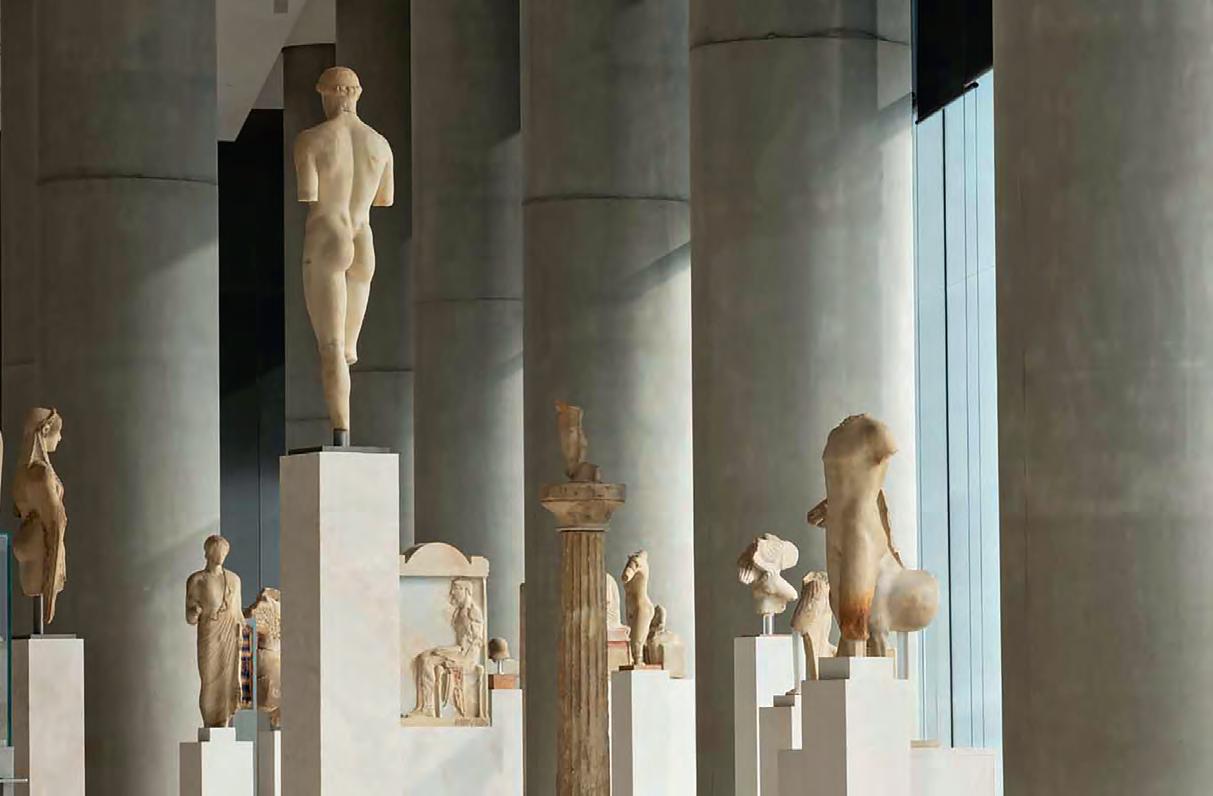
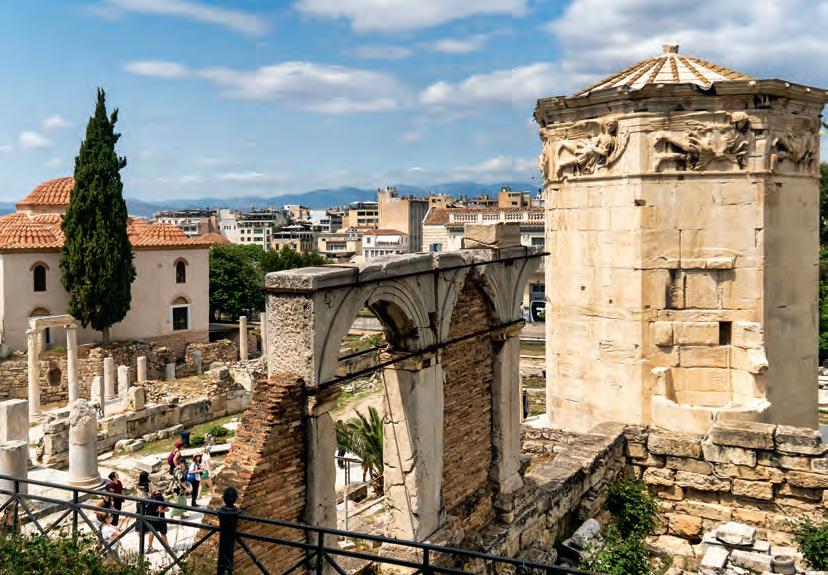

Above: A stop on the way up Filopappou Hill.

Ten unmissable cultural stops – all within easy walking distance of Syntagma Square.
One of the many neoclassical buildings on pedestrianized Dionysiou

1. Climb the Acropolis
The Parthenon, the Erechtheion with its Caryatids, and the panoramic views of Athens from the city’s ancient spiritual heart are reason enough to brave the lines. No one should come to Athens and skip seeing its most impressive ancient site. (Generaladmission:€30)
2. Visit the Acropolis Museum
Just 400 metres from the Sacred Rock is this beautiful structure; head straight to the museum’s top floor where the surviving Parthenon sculptures are displayed in direct visual alignment with the ancient monument itself. Then make your way down to the excavation site beneath the building. (15DionysiouAreopagitou, generaladmission:€20)
3. Attend a performance at the Odeon of Herodes Atticus
Whatever you happen to see at this Roman-era amphitheater on the southwest slope of the Acropolis will be unforgettable. Try to go at least once – the Odeon will close this autumn for restoration work lasting a minimum of three years. (DionysiouAreopagitou)
4. Stroll through Plaka
Athens’ oldest neighbourhood lies just beneath the Acropolis, wrapping around the north and east sides of the hill. If you’ve already experienced its more touristy side, read the section that follows for a different perspective on this area.


5. Explore the Ancient and Roman Agoras
The Ancient Agora in the Thiseio area is worth a visit for the reconstructed Stoa of Attalos and the well-preserved Temple of Hephaestus. The Roman Agora, only a few streets away, is home to the iconic Tower of the Winds. (Generaladmission: €20fortheAncientAgora,€10fortheRomanAgora)
6. A hike up Filopappou Hill
Also known as the Hill of the Muses, this green oasis that lies opposite the Acropolis will reward your ascent with an up-close look at the Filopappos Monument on its summit – dedicated to the grandson of Antiochus IV, the last king of Commagene. The views from the top are amazing, too.
7. Snap a selfie in front of the Athenian Trilogy
On Panepistimiou Avenue stand three iconic neoclassical buildings: the University of Athens, the National Library and the Academy of Athens – all designed and built in the 19th century. It’s the ideal backdrop for an impressive self-portrait.
8. An afternoon at the National Archaeological Museum
The country’s largest museum – and one of the most significant in the world – houses over 11,000 artifacts. Among them are the Antikythera Youth, the Artemision Bronze and the golden Mask of Agamemnon, all ancient masterpieces. (44Patission,generaladmission:€12)
9. A visit to the National Gallery
The work of outstanding modern Greek painters, from Theophilos and Gyzis to Parthenis and Tsarouchis, can be found here, all under one roof. For information on temporary exhibitions, please see the section that follows. (50Vasileos Konstantinou,generaladmission:€10)
10. Climb Lycabettus Hill
A steady uphill walk through pine trees and prickly pears will bring you, after a good bit of effort, to the whitewashed chapel of Saint George. In the morning, the views stretch across the whole city; in the evening, the sunset will steal the show.
BONUS A Day Trip to Cape Sounio
(approx. 90 minutes by car from downtown)
Marvel at the Temple of Poseidon (general admission:€20) and let your thoughts drift into the sunset at the southernmost tip of Attica. Combine your visit with a nature walk, a swim at the nearby beaches and a seaside lunch of fresh fish or shellfish.
AATHENS HOLDS countless secrets for culture lovers eager to explore the city on foot. Whether you’re visiting for the first time – in which case we suggest following the guide on the previous pages – or returning for the umpteenth time, there’s a walking itinerary here to inspire you.
We’ve divided the city into three key areas where there’s plenty of cultural sights to see, each waiting to be explored at your own pace. And as a bonus, we’ve included its fabled port of Piraeus. Ready for an artwalking experience that spans everything from Cycladic figurines and Mesopotamian relics to early Jean-Michel Basquiat works, powerful Marlene Dumas canvases and iconic Athenian graffiti?
Why not begin at the very center of the city, in Syntagma Square – a space that feels (without officially being) like a natural extension of the marble-paved forecourt of the Hellenic Parliament? Surrounding the square or just a short stroll away, you’ll find some of the city’s most historic hotels, as well as iconic buildings, embassies, flagship boutiques and cultural landmarks.
Syntagma is also adjacent to the National Gardens – a refreshing green interlude worth exploring, not only for its towering Washingtonia palms and picturesque duck pond but also for the statues that punctuate its shaded paths and the human presence that makes this space so welcoming.




Above: A reconstruction of the workspace of sculptress Alex Mylona.
Left: The artifact known as the Golden Mask of Agamemnon, one of the most famous items in the National Archaeological Museum.
Below: The Stoa of Attalos in the Ancient Agora.
The greater area surrounding the Acropolis, its museum, Plaka and the Ancient and Roman Agoras may be a well-trodden tourist hub – but each year, it still manages to come up with new surprises.
Until 31 October, the Acropolis Museum is hosting the temporary exhibition “Allspice: Michael Rakowitz & Ancient Cultures” (free admission with a zero-value ticket). Here, works by the Iranian-American artist Michael Rakowitz enter into dialogue with artifacts from ancient Middle Eastern and southeastern Mediterranean cultures.
Just 300 metres away, a sidestreet off pedestrianized Dionysiou Areopagitou is home to the Cavafy Archive (16B Frinichou, free admission). Inside, you’ll find personal belongings of the great Alexandrian poet – including his iconic round spectacles.
Only three minutes away on foot from the Cavafy Archive, the Arch gallery (5 Goura) is showing “Exploding Plastic Inevitable,” an exhibition by German sculptor Lena Henke, on view through 6 November.
While in Plaka, it’s worth making a short stop at the Elytis House Museum (4 Dioskouron & Polygnotou, general admission: €7), where the office of the Nobel-winning Greek poet has been carefully reconstructed to reflect the original working environment of this exceptional writer.
Roughly 300 metres from the Ancient Agora, in the neighbourhood of Thiseio, stands the Alex Mylona Museum (5 Aghion Asomaton Square, general admission: €6). Alongside works by the late Greek sculptress Alex Mylona (1920-2016) and other artists, the museum is hosting “A Cabinet of Curiosities,” an exhibition of intriguing, unconventional artworks on view through 31 August.
Finally, a slight detour on the L-shaped route connecting the Athenian Trilogy to the National Archaeological
Museum leads you to Omonia Square, where “Pentakyklo” (“Five Cycles”) – a kinetic steel installation by Greek sculptor George Zongolopoulos – makes a bold statement. Once a popular hub and more recently associated with latenight unease, the square is a safe if lively space in daylight hours and well worth a visit.
At the top of Deligiorgi Street, look for one of the city’s most striking murals, a piece by street artist INO created to raise awareness around hepatitis C. You may spot other examples of his thought-provoking work in other parts of the city as well.
These two neighborhoods, which border the city center, are known for their vibrant blend of retail shopping, dining, nightlife and culture.
Kolonaki, the more upscale of the two, is famous for its many art galleries. If you’re going to visit just one, make it Gagosian Athens at 22 Anapirou Polemou, which is currently presenting “A Telegram to My Dear Suki” by Oscar Murillo (through 30 August). On your way, expect to pass elegant boutiques and stylish haunts favored by the city’s elite.
If you’re short on time for leisurely flânerie, head directly to the Museum of Cycladic Art. Its permanent collection is world-renowned for its Cycladic figurines, although it also covers broader areas and periods of antiquity (4 Neofytou Douka, general admission: €12).
Until 2 November, the museum is hosting “Marlene Dumas: Cycladic Blues” – a solo show featuring over thirty slightly unsettling works by the celebrated contemporary artist who recently broke the auction record for a living female painter.
Frozen mid-stride on a patch of greenery between Kolonaki and Pangrati, “The Runner” by sculptor Costas Varotsos is one of the city’s most beloved public artworks. Made of layered glass with a steel skeleton, the

JUST A SHORT STROLL FROM SYNTAGMA SQUARE, YOU’LL FIND SOME OF THE CITY’S MOST HISTORIC HOTELS, AS WELL AS ICONIC BUILDINGS, EMBASSIES, FLAGSHIP
sculpture is just a ten-minute walk from the Museum of Cycladic Art.
Before settling into its current home, this piece stood in Omonia Square from 1988 to 1993. Although now cherished by locals and visitors alike, its imposing presence initially sparked heated controversy among Athenians.
Directly across from “The Runner” is the National Gallery. (Its permanent collection of modern Greek painting is included in our First-Time Essentials guide.) But if you’re already familiar with those works – or if you’re not particularly interested in such –you might still consider devoting time to either or both of its two remarkable


temporary exhibitions: “The Allure of the Uncanny,” presented in the Intermediate Space, and “Los Caprichos,” exhibited in the museum’s basement, work well together as a thought-provoking dialogue between contemporary works characterized by unusual aesthetics and Francisco Goya’s iconic series of eighty etchings. (On view through 30 September.)
As you leave, consider looping towards Pangrati from the rear side of the National Gallery. A 15-minute walk will bring you to the Basil & Elise Goulandris Foundation (13 Eratosthenous, general admission: €12). On the way, you’ll pass through a dense urban grid of apartment buildings that went up in the 1960s and ’70s – the concrete DNA
The installation “Embrace your Empathy (2016/2025),” a work by the artistic duo of Gustafsson and Haapoja from Finland, consists of 20 flags and extends over several floors of the EMST.
of postwar Athens, and an essential part of the city’s visual identity.
Once a quintessential middle-class neighbourhood – where filmmaker Yorgos Lanthimos and this writer both grew up – Pangrati has, over the past decade, evolved into a hotspot for hipsters and urban creatives.
At the Goulandris Foundation, the permanent collection, assembled from one of the world’s most important private art holdings, features major works by 19th-century and 20th-century masters, including Picasso, Cézanne, Chagall and Lichtenstein.
Until 2 November, the museum is hosting an exhibition honoring the centenary of the birth of the pioneering Greek artist Takis.
IN THE HEART OF ATHENS at the “City Link” shopping center, the Museum Shop offers a select collection of exquisite creations inspired by Greece’s rich cultural heritage.
Using materials such as marble, silver, silk and clay, Greek designers have crafted unique pieces exclusively for the Museum Shop. Each item reflects the spirit and the stories behind the Foundation’s nine distinguished museums across the country.
Art objects, handcrafted jewelry, gifts for your loved ones, memorabilia and many more unique items wait to be discovered. n

Marble and silver ring “Solitaire”, Museum of Marble Crafts, Tinos

Set of coasters with a unique glass-brick design, Rooftile and Brickworks Museum N. & S. Tsalapatas, Volos

Paperweight with filigree decoration, Silversmithing Museum, Ioannina

Silver earrings encasing a drop of natural Chios mastic, Chios Mastic Museum

Silver cufflinks “Olive”, Museum of Industrial OliveOil Production of Lesvos

Pendant “Cocoon”, Silk Museum, Soufli


Silk scarf “Waterdrops”, Open-Air Water Power Museum, Dimitsana

Silver brooch “Feather”, Environment Museum of Stymphalia
Limited edition plexiglass art object replicating the original work “Kotinos” by famed artist Alekos Fassianos, Museum of Olive and Greek Olive Oil, Sparta
MUSEUM SHOP
• Spyromiliou Arcade, Ground Floor, City Link, Tel. (+30) 210.322.4923
• Online: eshop.piop.gr
Starting back at Syntagma Square again, an alternative walk down Amalias Avenue, which runs in front of the Parliament, in the direction of Syngrou Avenue will take you past those same charming National Gardens, as well as a number of neoclassical mansions, the ornate St. Paul’s Anglican Church, the equestrian statue of Alexander the Great by sculptor Yannis Pappas (1913-2005), the Temple of Olympian Zeus, and, once you turn onto Syngrou Avenue, a stretch of unapologetically urban scenery, complete with sex shops, before you reach Neos Kosmos.
Some Athenians now call this neighborhood “the new Pangrati” –and they may not be wrong. Once a working-class neighborhood with little in the way of shopping or nightlife, it has recently acquired a different tone, thanks largely to the presence of key cultural institutions.
Your first stop here should be the National Museum of Contemporary Art, or EMST, housed in the former FIX brewery (Kallirrois & Amvrosiou Frantzi, general admission: €10). While you can reach it by metro (two stops from the Syntagma station, one from the Acropolis station), we suggest taking the 20-minute walk from Syntagma Square instead.
Currently on view at EMST is a series of exhibitions under the umbrella title “Why Look at Animals? A Case for the Rights of Non-Human Lives,” running through 2 February of next year.
On the museum’s ground floor is its inviting shop, where you’ll find everything from fans inspired by the work of South African artist Penny Siopis to baseball caps decorated with images from the visual universe of pioneering Greek performance artist Leda Papaconstantinou.
A “micro-neighborhood” within Neos Kosmos worth exploring is Dourgouti. To reach it from EMST, allow for a ten-minute walk past modest apartment blocks and inelegant car repair shops. Dourgouti

ONCE A WORKING-CLASS
NEIGHBORHOOD ... NEOS KOSMOS HAS RECENTLY ACQUIRED A DIFFERENT TONE.

is architecturally distinctive for its near-identical ochre-coloured refugee housing units, built in the 1930s to accommodate displaced Greeks from Asia Minor and Armenian refugees. Today, these buildings are home to migrant families from the Global South.
Not far from Dourgouti stands the Onassis Stegi, a major cultural institution usually closed during the summer months. However, one of its off-site commissions has become a neighbourhood landmark: a large-scale mural by artist Eleni Psyllaki, depicting a woman in a flowing red and purple dress. The figure stretches across the entirety of an exterior wall of the apartment building at 42 Lagoumitzi Street, adding an impactful poetic presence to the urban skyline.
Let’s be clear: Piraeus is a different city. The port lies some 10 kilometers southwest of the center of Athens, of which it is technically an extension. If you’re catching a ferry from there to one of the islands, it’s certainly worth taking in some of the area’s cultural life and architecture. If you’re not boarding a ship, a trip to this engaging port is still rewarding in itself.
By public transport, Piraeus is accessible via Metro Line 3 (the Blue Line) from Syntagma Square; get off at the Dimotiko Theatro, the last station on the line. If you’re traveling with luggage, consider storing it at a luggage locker – several operate in the Piraeus area, including those belonging to radicalstorage.com.
As soon as you step out of the station, you’ll find yourself in front of the Municipal Theater of Piraeus –a splendid 19th-century neoclassical landmark. About ten minutes on foot from the theater is the Archaeological Museum of Piraeus (31 Harilaou Trikoupi, general admission: €10). Though smaller than its Athenian counterparts, it is home to four extraordinary bronze statues dating from the 6th to the 4th century BC – including notable


depictions of the goddesses Athena and Artemis.
Further afield – about a 25-minute walk, or a quick €5 taxi ride – is The Intermission gallery (37A Polidefkous). It is currently hosting “Untitled,” an exhibition of early works by Jean-Michel Basquiat, in collaboration with Galerie Enrico Navarra. On view until 2 August, the show explores the formative years of Basquiat’s rise within the explosive New York art scene of the early 1980s.
Should you indeed be boarding a vessel here, I wish you bon voyage! If you’re simply looking around, I wish you happy discoveries! •






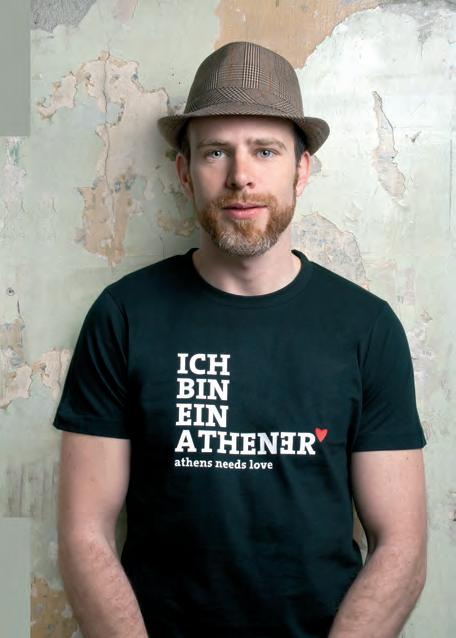





BY GEORGIA PAPASTAMOU AND MARINA PETRIDOU
The city’s tastiest newcomers are here, and they’re already making noise.
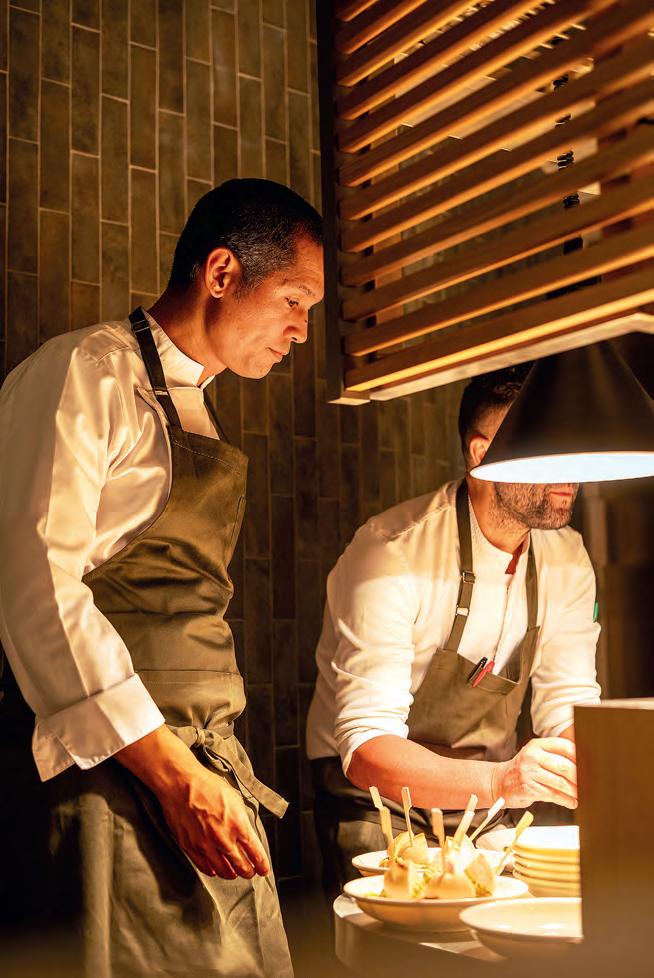
Located at the entrance of the Dragatsaniou Arcade, right across from Aghion Theodoron Square – now a full-blown dining hub – Hafu is the new restaurant of Greek-Japanese chef Sotiris Kontizas, known to many as a judge on the Greek edition of “Master Chef.” Just a stone’s throw from his already-beloved ramen joint Tanpopo, Kontizas returns with the kind of fusion flair that made his name: clean, precise and surprisingly comforting. The menu blends Greek and Japanese ideas with ease and confidence. Οptions include soba noodles; sashimistyle bonito with cold plaki sauce; squid with fennel root; fried chicken; a superb cod burger; and more seasonal pairings that feel effortless and right. The name “Hafu,” by the way, is Japanese slang for “half-Japanese” – just like the chef.

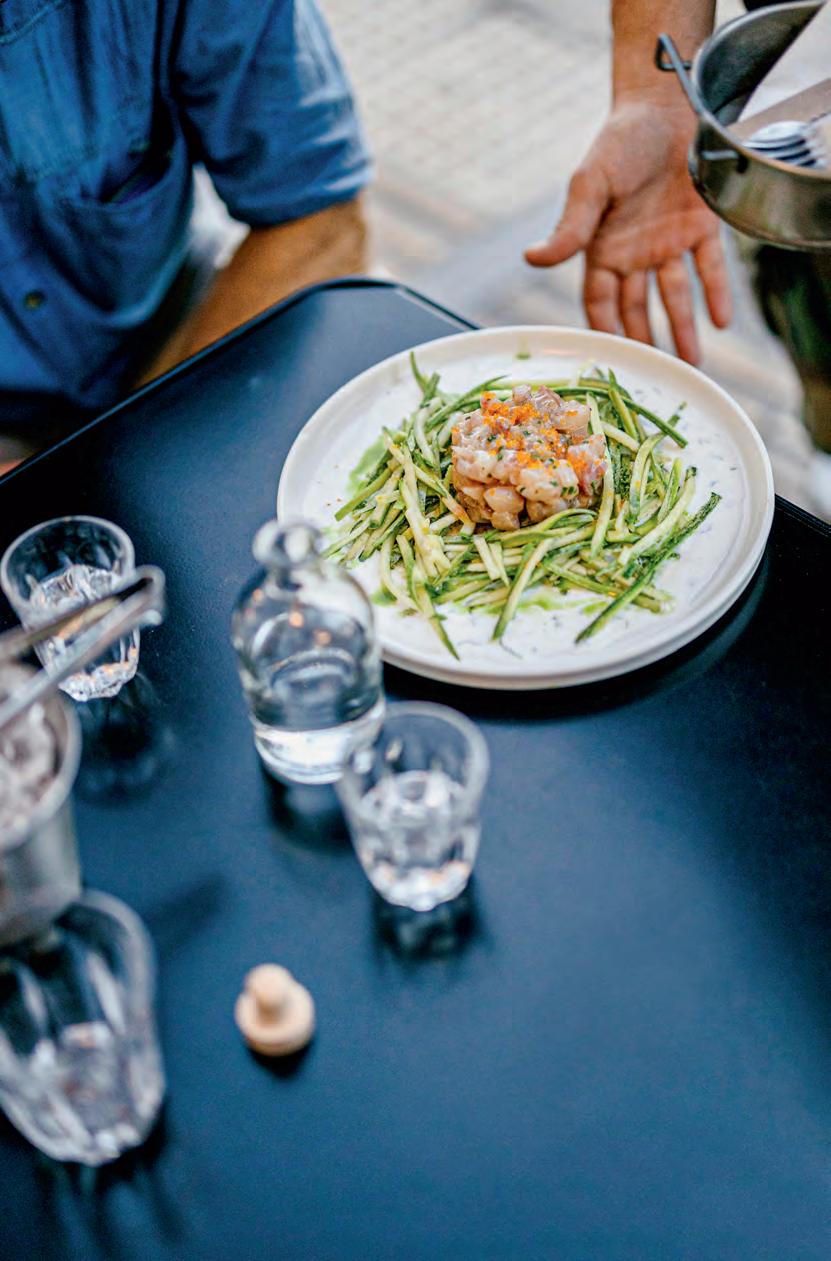

Set on a breezy corner beside the historic Poulopoulos hat factory in Thiseio, Aphaia feels like the kind of place made for unhurried catch-ups and sun-drenched lounging. Grab a seat on the wide sidewalk, watch the trains rattle by on the overpass across the street, and order either a full meal or a round of shareable meze – whatever the moment calls for.
From the revamped menu, standouts include spaghetti with ground meat; a vegetarian “kontosouvli” made with mushrooms and sweet potatoes; and a rich, homemade peinirli, or pizza boat, filled with kavourmas (beef confit). Summer specials are bright and inventive: a salad of green beans, Tinos cheese, and pickled nectarine; charred melon with almond cream and sardinella; and a marinated fish dish with zucchini, fennel, and a tangy kefir-herb dressing. ➢ 1 Aithras, Thiseio, Tel. (+30) 697.714.8019



ONE OF THE MOST timeless summer pleasures in Athens is dining beneath the trees, in the hush of a leafy garden, as the day fades and the air fills with scent. That’s exactly the kind of experience that awaits at zohόs—a serene culinary retreat where Greek tradition flourishes in every plate.
Named after a wild herb that grows across the country’s diverse landscapes, zohόs is rooted in the flavours of the land and sea, drawing inspiration from ancestral
recipes and the slow art of cooking. The kitchen reimagines rustic classics with elegance and depth, using seasonal ingredients sourced from small-scale farmers, fishermen, and foragers who share a reverence for balance and authenticity.
This is food designed to be shared, savoured, and remembered. Taking cues from the Greek meze tradition, the table becomes a space for connection—over sun-warmed vegetables, tender braised meats, or simply a crisp glass of wine
and something grilled to perfection. Every dish honours the richness of local produce while embracing a modern, nose-to-tail approach that minimises waste and amplifies taste. It’s honest food—layered, generous, and deeply satisfying.
Whether you're a curious explorer or a devoted seeker of true flavour, zohόs offers a place to pause, taste, and feel at home. Here, every evening carries the joy of a long Sunday lunch. n
For more information: zohόs | Electra Palace Athens → Navarchou Nikodimou 18-20, Plaka 10557 • Greece Website | https://zohosathens.com/

Chef Marina Chrona first won us over with Rini, her cozy spot near the Archaeological Museum, where inventive Greek cooking was served with genuine warmth. At Meigma, her new meze restaurant in Kerameikos, she continues to draw inspiration from local ingredients and traditions, although this time with a more relaxed take.
The summer menu is full of clever, flavor-forward surprises: watermelon dakos with tomato and galeni cheese; grilled green beans with Pontic cheese, almond, and apricot; and a tuna carpaccio with roasted tomato and amaranth greens. For something heartier, go for the juicy seftalia served with tabbouleh, tahini yogurt, and handmade pitas, or the golden potatoes topped with staka butter, Greek pork belly, and a fried egg.
A bonus: the extensive drinks list includes select Greek spirits and over seventy wine labels sourced exclusively from Greece’s vineyards.
➢114 Megalou Alexandrou, Kerameikos, Tel. (+30) 210.345.2094






Locals say it was just what the neighborhood needed; visitors from further afield end up loving it so much, they come back. Evlalia is a meze-focused hangout in Pangrati, set on a broad sidewalk and housed in a renovated neoclassical home with vintage flair. The building is painted a cheerful dusty pink, which contrasts playfully with their bright red chairs, while the old sign above the door – “Evlalia Accounting and Other Bits” – is a remnant of the tax office that once operated here.
It’s the kind of place you head to after work and stay longer than planned if, that is, you’re lucky enough to snag a table. Expect well-executed dishes, local spirits and Greek beers. Start with the dakos, topped with sweet tomato and creamy myzithra, then move on to marinated red mullet, an ideal pairing with tsipouro. The pork chops are juicy and perfectly grilled, and the cheeseboard features rarities such as smoked volaki from Syros.
➢10 Frynonos, Pangrati, Tel. (+30) 210.756.5871

Looking for an authentic taste of Greece? At Cinque, we pair award-winning Greek wines with artisanal cheeses, cured meats, and warm local hospitality — all in the heart of Athens.
Join a guided wine tasting, share a Greek deli platter, or just sip and unwind like a local.
Three cozy wine bars. Countless unforgettable moments.
Cinque Wine & Deli. Taste Greece, one glass at a time!


Cinque Wine & Deli Monastiraki
Voreou 10, 105 51, Monastiraki, Athens
Cinque Wine & Deli Psirri Agatharchou 15, 105 54, Psirri, Athens
Cinque Wine & Deli Acropolis
Drakou 3-5, 11742, Koukaki, Athens
www.cinque.gr

In Koulouri Square, far from the commotion of Gazi’s busiest streets, Mirlo uses the flavors of the East with quiet authenticity. The menu is shaped by the roots of its culinary trio: Andreas Kiltsiksis, of the beloved eatery Feyrouz and a native of Antioch, Syria; GreekPalestinian chef Vassilis Hamam (Estet Café); and cook Andreas Nikolopoulos. Together, they’ve created a fire-forward eatery where kebab means anything grilled directly over flame.
It’s a tiny space – just a counter with a few stools and a handful of tables spilling into the square – but the food is big in personality. The menu is constantly evolving, but current standouts include lamb giaourtlou with kefir-whipped yogurt, charred tomato, and handmade flatbread; chicken over coals with fattoush and coriander sauce; veal liver with yogurt and burnt lemon; and beef tongue served with pickled vegetables and toum, a Lebanese garlic sauce. On the side come twice-cooked potatoes, smoky onions in olive oil, silky baba ghanoush, and a tart-sweet pomegranate molasses made by Kiltsiksis’ family in Antioch.
➢ 5 Elassidon, Gazi, Tel. (+30) 216.100.4220






Perched atop Amalia Hotel Athens, WHISPERS offers panoramic views of the city, the Acropolis, the Parliament and the National Garden setting the stage for moments of pure relaxation and indulgence. As you settle into its stylish ambiance, the city’s rhythm gently fades, allowing your senses to wander across the Athenian skyline while experiencing authentic and fresh gastronomy, blending Greek tradition with modern culinary artistry and comforting flavours.
Under the creative direction of Chef Angelos Kondes, the menu showcases the richness of Greek ingredients and carefully curated seasonal produce. Signature starters include aubergine tart with Lefkada salami, seabass ceviche with citrus dressing, sea fennel, purple potato chips, and lightly charred corn and vegan zucchini fritters with smoked almond cream, paired with Florina pepper & harissa sauce.
Highlights from the menu feature shi drum fillet with Aegina pistachio crust, to slow-cooked lamb with rosemary sauce and potatoes, and the flavourful orzo with sautéed shrimp and chorizo—each dish a tribute to summer nights infused with distinctive taste and elegance.
End your meal on a sweet note with elegant desserts such as the caramel semifreddo with Greek coffee cream or the Valrhona chocolate mousse on a crispy praline disc, layered with milk chocolate cream and finished with a vibrant passion fruit sauce. It is the perfect finale to an unforgettable dining experience, beautifully complemented by your favourite wine or cocktail.
10 Amalias Avenue 10557 Athens, Greece T: +30 210 331 8662 W: whispersathens.gr E: whispers@amaliahotels.com IS: whispers.athens FB: Whispers Athens

MIMOSA SHRUBS AND SWEET ACACIA AND MULBERRY TREES OFFER A WELCOME REPRIEVE FROM THE HEAT OF AN ATHENIAN SUMMER.
BY MARINA PETRIDOU

TTOGETHER WITH Tasos Chalkiopoulos – the voice behind Athensville, one of the city’s most insightful urban blogs – I set out to explore leafy pedestrian streets, sun-dappled courtyards and quiet squares, in search of the city’s coolest culinary refuges: the places where bougainvillea climbs above your head, the jacarandas bloom, and the mulberry trees are thick enough to ward off the strong sun.
“Get out there – Athens is blooming!” That was the blogger’s rallying cry on the Athensville Instagram feed, with a video so lush with trees and flowers you could practically smell the blossoms through the screen. From the bitter orange trees lining the city’s streets to
unexpected pockets of bougainvillea, Bauhinia, bottlebrush, flowering plum, Judas trees, and sweet-scented needle bush, Tasos sees Athens not just as a city, but as a living, blooming organism – on the edge of overheating.
That video sparked an idea: why not invite him to take a walk with me and share his favorite places to eat under the trees? Because once the city is drenched in sunlight and heat, shade becomes more than a comfort – it becomes a way to survive. Chalkiopoulos happily agreed, with one small condition: every stop had to be one of his own haunts. These are laid-back, unpretentious places – some wellknown, others hidden in plain sight, a few with decades of stories etched into their tabletops, others new and quietly confident. But all of them are rich in character – and dappled in green.
“It was in 2009 that I really started to notice the city,” my guide tells me as we begin our walk. “That was when blogs were thriving, and I wanted to create my own. I wanted to show a different side of Athens, not the one everyone knew: the rough, neglected side. Because even then, there was so
much richness here: the architecture, the history, the beauty. Amid the decay, a city was emerging – one that deserved attention and care.” At first, Chalkiopoulos explored the streets with a focus on buildings, drawn to hidden details and small joys that most people overlook. But gradually, the city began to reveal something else: a softer, greener side that breathes through leaves and blossoms.
“It might sound odd, but Athens actually has a lot of trees,” he says. “We may not have vast parks or thick woodlands, but there are trees everywhere – lining sidewalks, filling squares, shading alleyways. The jacarandas were the first to catch my eye. Their color, their seasonality, the way they can completely transform a street. When they bloom – on Athinas, around Zappeion, along Vasilissis Sofias – the whole city feels different. They’re beautiful and low maintenance, but in 2019 they were pruned brutally. I posted about it, and it caused a stir. I never set out to be an environmentalist, exactly. But when something you spotlight leads to real change, that’s a powerful feeling,” he adds.


On Odysseos Street, a quiet stretch that still carries the faded charm of the 1980s, we find Morgan All Jeans (16 Odysseos, Tel. (+30) 697.808.1309)
Opened in 2018 by Spyros Kapodistrias, the space retains the original signage of the old denim shop that once occupied the site.
“It was a dream of mine,” Kapodistrias says. “I wanted something off the beaten path, but still close to the center – and I wanted it to be on a pedestrianized street.” Back then, the area was nearly abandoned, the plants dry and lifeless. Spyros revived it, tending to the flowers and preserving a striking palm tree that now towers above the tables, casting much-needed shade and character.
The food is unpretentious but full of soul: slow-cooked goat with pappardelle; chickpeas with eggplant; stuffed vine leaves; Cretan dakos; and homemade pastourma pie. They are meze that taste like Sunday lunch at home, as he puts it. Around us sit students, artists, tourists and locals, all gathered under the gentle watch of the marble fountain at Metaxourgeio Square.
JUST A FEW STEPS AWAY, TUCKED BEHIND CITY HALL ON LIOSION STREET, LIES TRAIMPER SQUARE, A QUIET SHADED REFUGE FILLED WITH BLOOMING SWEET ACACIA TREES WHOSE INTENSE FRAGRANCE FILLS THE AIR IN SPRING.
Just a few steps away, tucked behind City Hall on Liosion Street, lies Traimper Square, a quiet, shaded refuge filled with blooming sweet acacia trees whose intense fragrance fills the air in spring. These trees, Chalkiopoulos says, help you slow down, sharpen your senses, and truly absorb the beauty around you. Hidden here is a tiny, nameless Bulgarian eatery – no sign, no fanfare. Just a humble spot serving home-style dishes to a steady stream of regulars. You’d likely walk right past it unless you knew to look. But it’s one of the blogger’s favorites – for the simplicity, the quietude, and the warm familiarity of its patrons.
A little further up, toward Aghios Pavlos Square near the Larissa train station, we pause – not for food, but for the aroma. The air is filled with the scent of angelica, a Mediterranean herb that infuses the neighborhood with a scent of citrusy sweetness. Hardy and resilient, it thrives even in the polluted city air. There’s no eatery here to add to the list, but Chalkiopoulos reminds me that, sometimes, all it takes to reset your day is taking the time to sit beneath a tree.
We continue toward Akadimia Platonos and arrive at Mouries (15 Keratsiniou, Metaxourgeio, Tel. (+30) 210.522.6805), a family-run taverna named after the mulberry trees that have shaded this corner for decades.
“Even when it hits 40 degrees in Athens, there’s always a breeze under here,” says owner Giorgos. Originally a neighborhood café, the place has since evolved into a proper meze spot. In the kitchen, Stella and her daughter Eirini prepare crisp hand-cut fries; fried meatballs; fresh anchovies and whitebait from the fish market; and warm Sfakian pies with myzithra and honey. Groups of locals sip tsipouro at tables set out on the asphalt beneath a lush canopy of leaves.
“There’s something paradoxical about how Athenians treat mulberry trees,” Chalkiopoulos muses. “Some prune them heavily to avoid the mess from the fallen fruit – fruit that’s

Above: Flavor is king at Seychelles on Avdi Square, filled with Peruvian pepper trees. Right: To Palio Podilato is located on a shady square in a quiet corner of Rouf.


delicious, sweet and tangy, but is only good for a few moments after you pick it. But mulberry trees give the best kind of shade. In summer, they’re lifesavers.”
Beneath a soft canopy of Peruvian pepper trees on Avdi Square lies Seychelles (49 Kerameikou & Akadimou, Tel. (+30) 211.183.4789). One of the early pioneers of Athens’ gastrotaverna movement, this popular spot has built its reputation on top-quality ingredients, a relaxed energy, and a menu that always feels perfectly in tune with the season.
The beef confit used in the pappardelle is now prepared in-house, and the dishes change with the seasons: grilled liver with pickled cucumber, potato gnocchi with shiitake mushrooms, and natural wines from small producers. You’ll always find something worth coming back for.
Our next stop takes us to Votanikos. Syntrimmi (53 Chalkidikis, Tel. (+30) 213.044.6962), a cooperative café, appears where you’d least expect it – in the open courtyard of a demolished building. Blooming plumbago (also known as blue jasmine or leadwort) and bougainvillea soften the rough edges of exposed concrete, adding beauty and shade. As the sun sets, the courtyard hums with life, filling almost to the point of overflow.
Just a few blocks away is Thessalos (2 Melenikou, Tel. (+30) 213.022.2335), a neighborhood favorite with a shaded courtyard under more flowering bougainvillea. The vibe here is relaxed and resolutely unpretentious, the kind of place people return to week after week for no-frills dishes that deliver on flavor. There’s nothing showy – just food done right, with heart.
In nearby Rouf, just behind the Benaki Museum Pireos 138, we stop at Palio Podilato (11 Andronikou, Tel. (+30) 213.030.6784). The setting is humble, and the story behind it speaks volumes about the resilience of the area.
THE VIBE HERE IS RELAXED AND RESOLUTELY UNPRETENTIOUS, THE KIND OF PLACE PEOPLE RETURN TO WEEK AFTER WEEK FOR NOFRILLS DISHES THAT DELIVER ON FLAVOR. THERE’S NOTHING SHOWY – JUST FOOD DONE RIGHT, WITH HEART.
“Before the Petrou Ralli overpass was built, this area was full of life,” says owner Tasos Papadatos. “There were cinemas, fabric shops, and people everywhere. Then the overpass came, and the neighborhood emptied out. When I first opened, there was no one here. But in recent years, things have started to pick up again. Shops are opening, and people are rediscovering the area.”
There are only a handful of tables and a short, seasonal menu. The dishes are prepared by the owner. “The problem I always had eating out was that everything tasted the same. Frozen, prefab, soulless. I thought, if I can’t find the food I want to eat, I’ll make it myself.”
Crisply fried fish, golden hand-cut fries and seasonal meze, accompanied by over 15 Greek craft beers, are served under a tall chestnut tree and sweetly fragrant angelicas.
“What I love most about this place is the shade,” Papadatos says. “We’ve got plants, we’ve got greenery. That’s not something you can take for granted in the city center.”
In Thiseio, we make a stop at a longtime neighborhood classic, To Steki tou Ilia (5 Eptachalkou, Tel. (+30) 210.345.8052). Its spacious courtyard is shaded by a vigorous Virginia creeper (also known as five-leaved ivy), and rosemary and lavender perfume the air. Weekends are busy but come on a weekday evening and you’ll find a tranquil retreat just as the light begins to fade. The menu is simple and straightforward: perfectly grilled lamb chops, hand-cut fries, tender zucchini and wild greens.
From there we head toward Kypseli. The pedestrianized stretch of Aghias Zonis Street is dotted with trees and oleanders, their blooms spilling color all around. Here we find Arizona Dream (42 Aghias Zonis), Stella’s small, soulful mezedopoleio. The food, inspired by her roots in Apeiranthos on the island of Naxos, is humble, hearty,
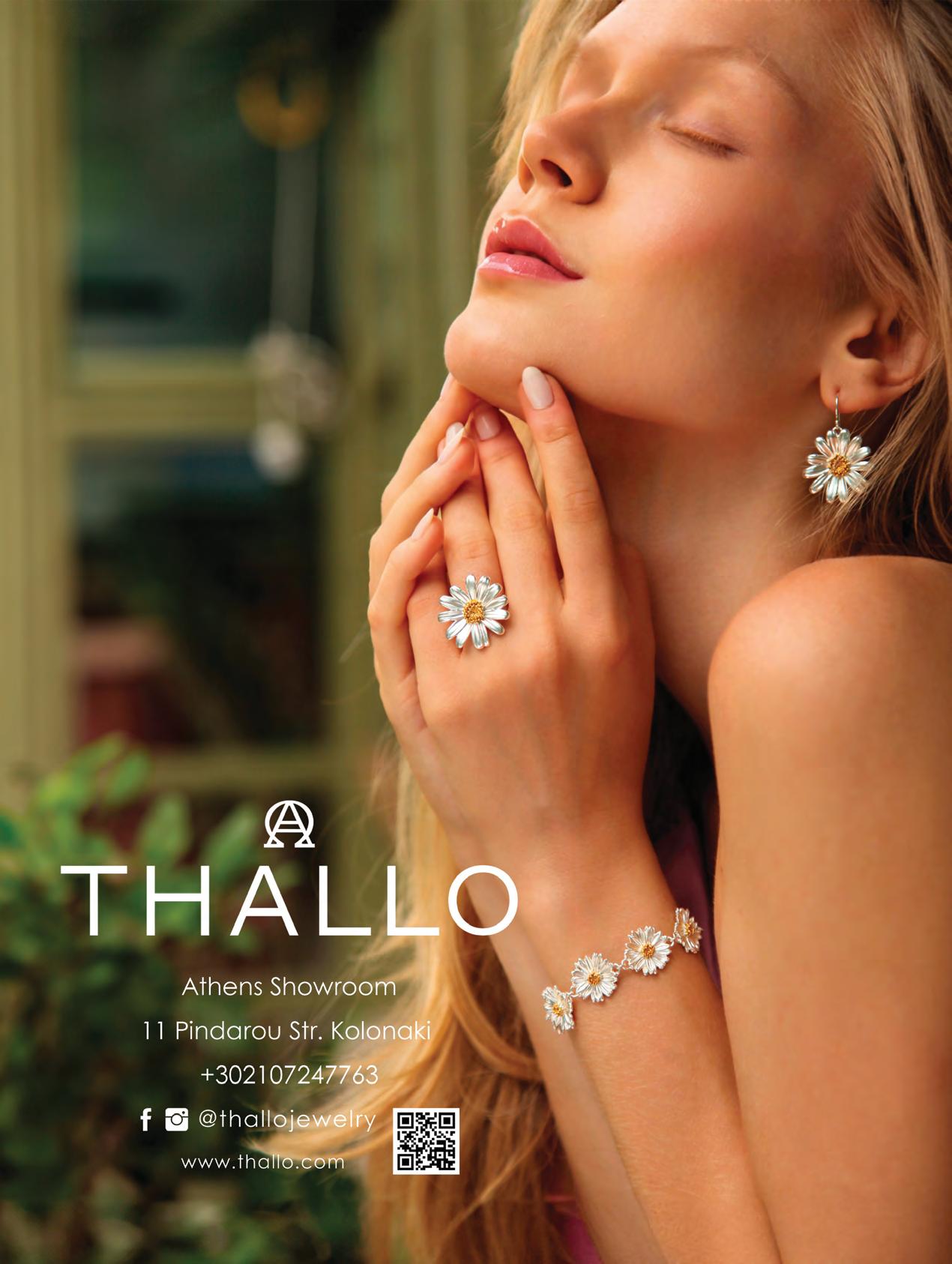
and full of island soul: meatballs with eggplant and tomato sauce, barley rusk with tomato and xynomyzithra cheese, and zucchini pastitsio.
In the uphill lanes of Ano Kypseli, we find Ypsala (1 Ostrovou, Tel. (+30) 210.881.3175), an oasis of calm on a wide, leafy street – a welcome contrast to the neighborhood’s typically tight, busy blocks. Founded by three friends, Ypsala makes the most of a tiny 3-square-meter kitchen by focusing on quality ingredients, most sourced directly from Crete.
Standout dishes include roast potatoes with PDO xygalo cheese from Sitia, Cretan mizithropita with xynomyzithra from Rethymno, and fried eggs topped with a rich béchamel
made from stakovoutyro (clarified sheep butter), a dish that’s flavorsome and ideal for bread-dipping. Apaki and vinegar-cured sausages from Crete are available, too, as is a refreshing summer salad of bulgur with homemade peach dressing, cucumbers, tomatoes, fresh peach slices and pumpkin seeds.
To drink, there are craft beers, bottled tsipouro and a small list of Greek wines. For dessert lovers, there are preserves from a small, family-run workshop in Gytheio. It’s everything you need for a cool, quiet pause in one of the most relaxed corners of the city.
“Look at how beautiful the trees are here,” Chalkiopoulos says. “But how many people actually notice them?” He
tells me about the time he was filming on Athinas Street and a woman came up and asked, “Why are you filming that? The flowers fall and make a mess.” He was stunned: a tree in bloom and she was upset about a few fallen petals. The city is alive – full of roots and trunks and trees that need care in order to give back shade, scent and color. If the municipality won’t tend to them, maybe we can. And in doing so, we might begin to experience the city differently. “That’s why I say ‘Get out there – Athens is blooming,’” Chalkiopoulos tells me as we wrap up. And he’s right. You just have to know where to look – and who to walk with.•
Instagram: @athensville

At Ypsala for beer and meze next to the oleanders.
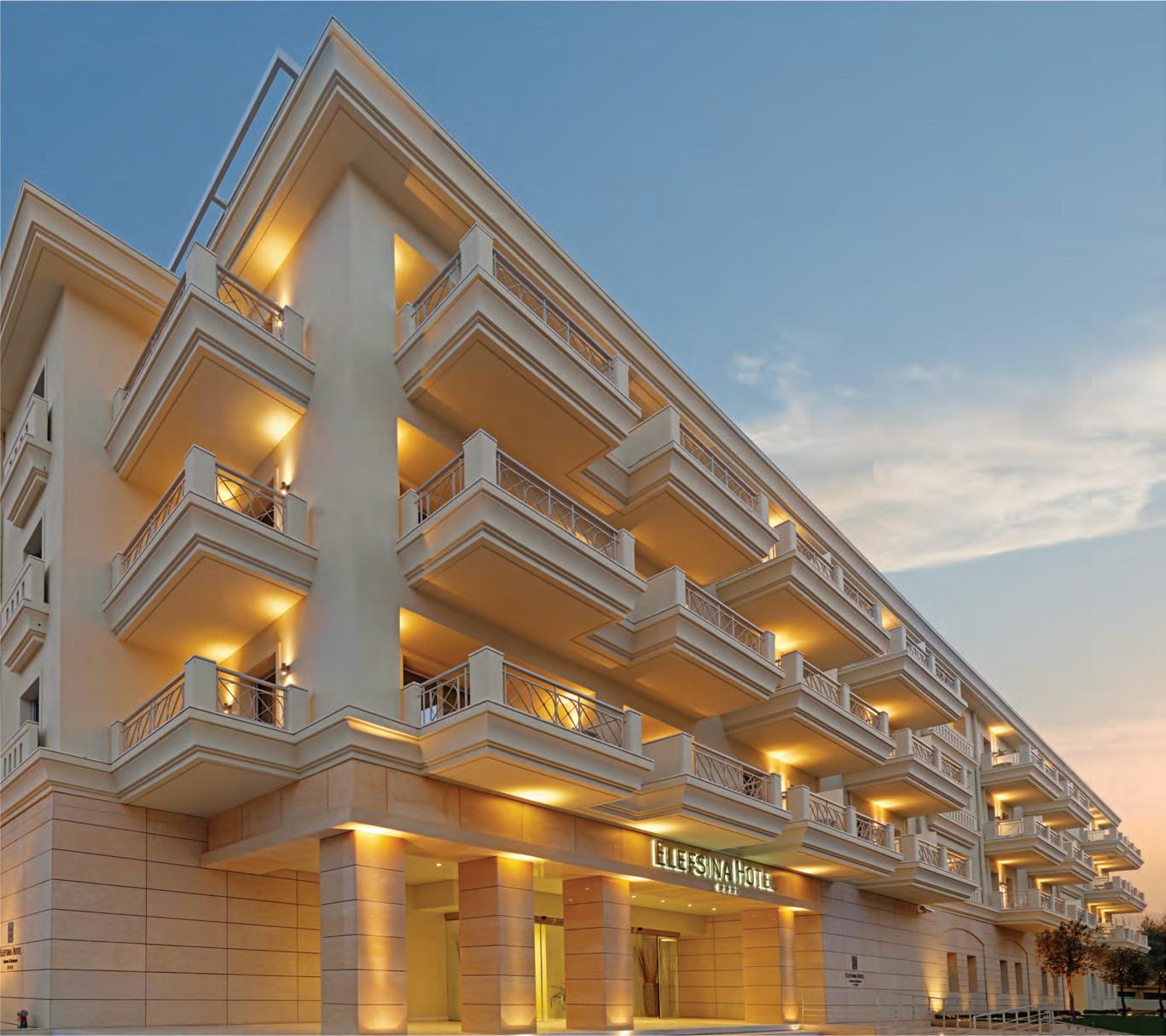


In the shadow of the Parthenon.
Left: A carved sun is part of Pikionis’ stone pathways on Filopappou Hill.

Ancient paths, shaded climbs, and the best views in town, from Filopappou to Lybabettus.
BY GIORGOS PSOMIADIS
IIT MAY WELL be the most beautiful walk in all of Greece – and that’s no exaggeration. How else could one describe a four-hour trail that links the most storied hills of Athens? From Filopappou Hill, also known as the Hill of the Muses, to the Pnyx, the Hill of the Nymphs, the peaceful neighborhoods beneath the Acropolis, and finally to Lycabettus Hill, every stop along the Hills of Athens route feels in sync with the city’s eternal pulse.
After all, the secrets of Athens are hidden in these hills, tucked into green pockets of stillness, whispered from shaded footpaths, and revealed at each summit. To lear them is our goal as we gather at 12 Parthenonos Street in Koukaki, ready to set out on what felt less like a guided walk and more like a ceremonial initiation: a quest for the city’s inner essence.
We begin at the headquarters of Trekking Hellas, where we meet Yiannis Frydakis, the organization’s program coordinator and our guide for the day. “Beneath our feet runs the ancient wall of Athens, built some 2,500 years ago,” he tells us, before leading us toward Dionysiou Areopagitou Street, the pedestrianized promenade unveiled at the dawn of the new millennium and now one of the most beautiful thoroughfares in the city.
To the sounds of street musicians, we set off on a route that blends panoramic views, ancient monuments, and glimpses of authentic contemporary Athenian life. A quick right turn brings us onto the Hill of the Muses – also known as Filopappou Hill – the first stage of our journey.
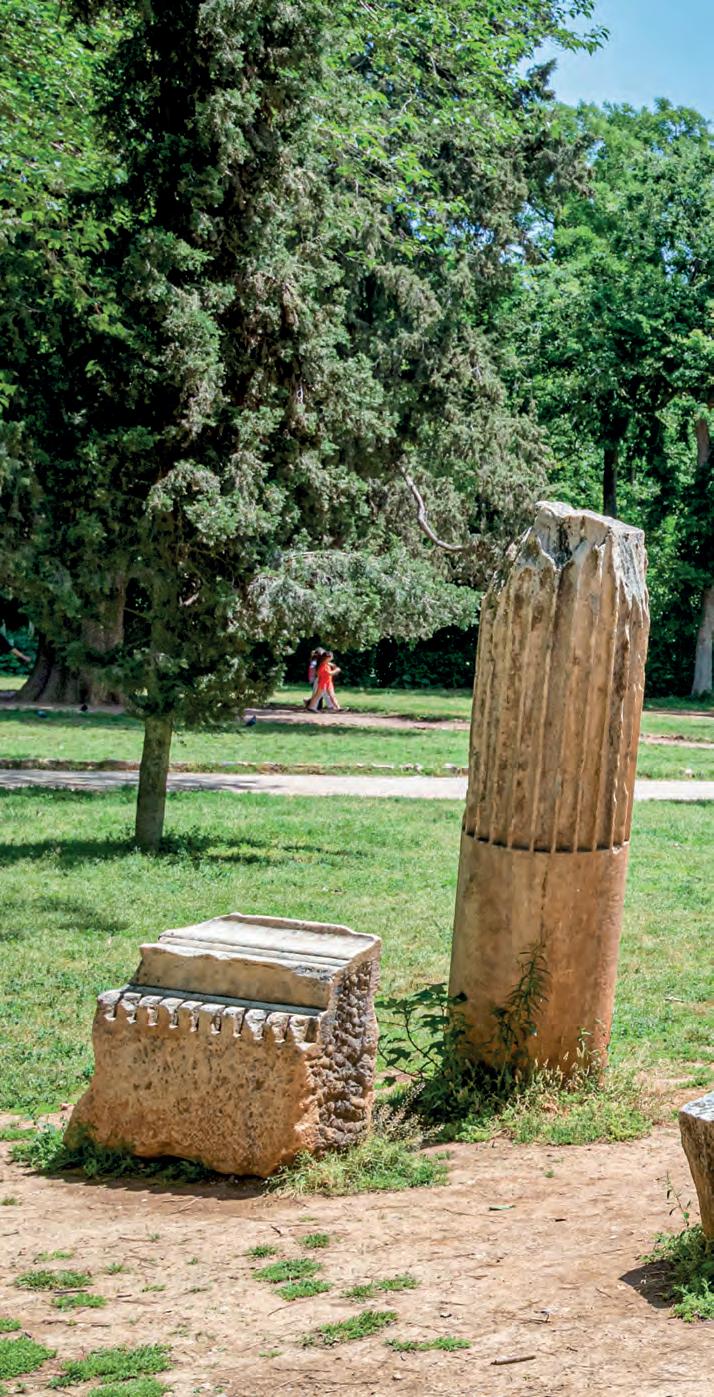
Stopping at the remnants of some columns in the National Gardens, Yiannis Frydakis (standing) of Trekking Hellas shares some local knowledge.


Perhaps overshadowed by the nearby Acropolis, Filopappou Hill is often underestimated. Yet here, in the most important green sanctuary of central Athens, is where – as Yiannis tells us – the first Athenians once lived. Today, you’ll see a few scattered picnickers, morning runners, and the occasional curious tourist. Pine trees and wild olive groves, planted in the 1950s during a postwar effort to breathe new life into the hill, now frame the path we follow toward our first stop: the so-called “Prison of Socrates.” Legend has it that the ancient philosopher drank hemlock in one of these stone-hewn cells. Millennia later, on the eve of the Nazi occupation during WWII, the Greek Archaeological Service chose this same site to conceal precious artifacts, walling them in with concrete to protect them from destruction or theft. The chamber remained sealed until the war ended.
WE NOTICE A SERIES OF STRIKING PATTERNS UNDERFOOT, AN ARTFUL COLLAGE OF STONES, MARBLE FRAGMENTS AND CERAMIC SHARDS LAID IN THE 1950S BY THE RENOWNED ARCHITECT
One of the many busts scattered throughout the National Gardens.
As we climb, we notice a series of striking patterns underfoot, an artful collage of stones, marble fragments and ceramic shards. These were laid in the 1950s by the renowned architect Dimitris Pikionis, who reused salvaged materials from demolished neoclassical buildings in the area. Yiannis pauses beside a carob tree. He explains that these hardy plants, once used by Athenians in times of hardship to make carob flour, have been growing on this hill since antiquity.
It isn’t long before we reach the top, where the grand monument built between 114 and 119 AD comes into view – a tribute to Gaius Julius Antiochus Philopappos, from whom the hill takes its modern name. The structure is made from two types of marble: one brought here in ancient times from Mt Penteli, the other from Mt Hymettus, on the city’s eastern edge.
From here, Athens stretches out in every direction. To the south, the deep
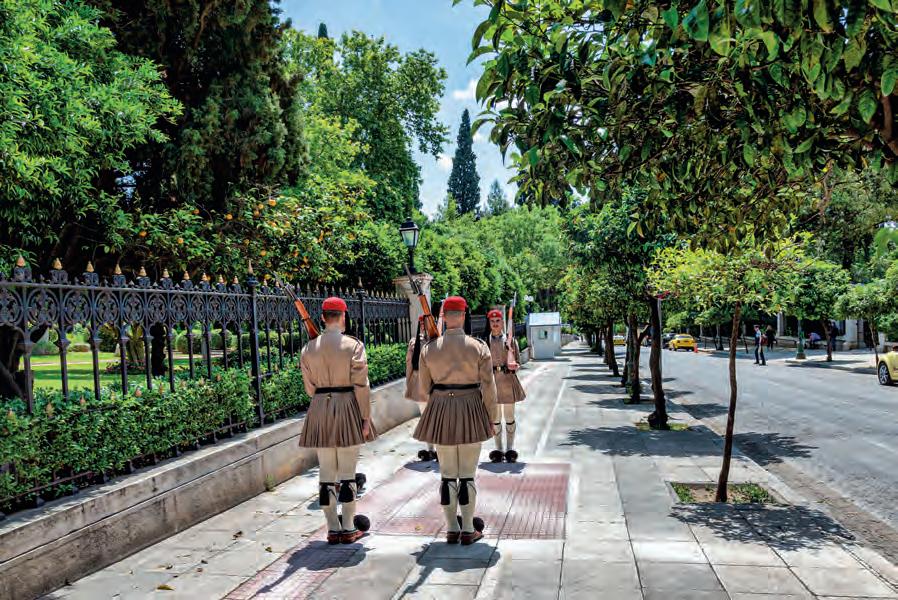

blue of the Saronic Gulf shimmers, with Aegina and Salamina on the horizon. It’s Saturday, and sailboats from local yacht clubs glide across the water. Behind us, Mt Hymettus, the longest of Athens’s surrounding ranges, rises in quiet grandeur. Nearby, two visitors call out in delight – they’ve just spotted a tortoise. With a bit of luck, you’re likely to see a number of them along the hill’s trails.
The next stop on our route leaves us momentarily speechless: seven stonecarved seats, known as the Heptathronon, arranged in a semicircle and shrouded in mystery. Their imposing form suggests a public function, perhaps a court, a council chamber, or a space for ritual gatherings. The prevailing view links the site to the great mother of the gods (Cybele/Rhea), whose sanctuary once stood nearby.
Across the way lies the site of ancient Melite, a historic district where some of classical Athens’s most prominent figures – Themistocles, Alcibiades, Miltiades and Epicurus – once had their homes. One can almost imagine them walking these very slopes.
After a brief pause, Yiannis gestures for us to continue. We come upon the ancient road of Koile, once the city’s main artery for supplies as it traversed the district of the same name and connected Athens with the port of Piraeus. Deep grooves carved into the stone by cartwheels – still visible after centuries – capture our attention.
Not far from the Hill of the Pnyx we reach the small Church of Saint Demetrios Loumbardiaris. This vaulted single-nave basilica, dating back to the Ottoman era (some say even to the 9th century), has long held its own spiritual gravitas. Visitors step in and out quietly, a few pausing to light a candle. The atmosphere is solemn, almost liturgical – a moment of stillness on this journey through layers of time.
We arrive at the Pnyx, the very ground on which the Ekklesia tou
Dimou, the citizens’ assembly of ancient Athens, convened from the 6th to the 4th century BC. It’s impossible not to feel awe here, knowing that Pericles used to address the people from this sacred speaker’s platform. To stand at the heart of the world’s first democracy is to stand at the source of something still resonant today.
At the highest point of the hill, housed in a vaulted pavilion crafted from Aeginetan marble, stands the Doridis Telescope. Once part of the Athens Observatory, it was the largest telescope in Greece until 1959.
By the time we reach the Church of Saint Marina in Thiseio, a hush has settled over the scene. Only the voices of children echo through the courtyard as they play between trees and benches. The scent of home-cooked meals wafts through open windows, pulling us gently from the heavy weight of antiquity back into the intimate charm of everyday Athenian life.
Around us, neoclassical façades and postwar apartment buildings create a scene from earlier urban days. To many outsiders, the city’s ubiquitous apartment blocks may seem puzzling. Built rapidly between the 1950s and 1980s to address a pressing housing need, these
ACROSS THE WAY LIES THE SITE OF ANCIENT MELITE ... WHERE SOME OF CLASSICAL ATHENS’S MOST PROMINENT FIGURES – THEMISTOCLES, ALCIBIADES, MILTIADES AND EPICURUS – ONCE HAD THEIR HOMES.
concrete buildings often appear mismatched or sadly utilitarian. Yet their straightforward, functional design has proved both resilient and adaptable, securing their place in Athens’s urban identity.
“These buildings create a kind of social equilibrium,” Yiannis explains, describing how a typical Athenian apartment building brings together layers of city life: from the family-owned shop on the ground floor to the apartments housing multiple generations above.
A sudden shift in the landscape brings us to Anafiotika, a tiny, whitewashed neighborhood clinging to the slope of the Acropolis like a Cycladic mirage. Built in the mid-19th century by stonemasons from the island of Anafi, who had come to Athens to work on King Otto’s palace and other ambitious projects, the simple white houses offer a stark contrast to the imposing rock above.
Yiannis takes us through brightly colored doorways and tiny houses, explaining how a strong sense of community still binds the neighborhood together: “Here, neighbors cook for the less fortunate among them,” he tells us.
Balconies bursting with flowers, narrow stone alleys and modest windows that conceal a life of quiet simplicity – these images linger sweetly in the mind, a gentle imprint of a place where time moves differently.
To reach the National Gardens, we pass through Plaka – where restaurants and wine bars buzz with life – and stroll down Tripodon Street, the oldest thoroughfare in Athens. Before we know it, we find ourselves under a canopy of trees. It’s Saturday, and families fill the park, children darting off to explore the duck and turtle ponds with wide-eyed



wonder. This lush refuge was once the passion project of Queen Amalia (18361867), who spent long hours tending to its design and plantings.
Time seems to slow here as we wander among the soaring palms, mosaic paths, ancient columns and marble busts of historical figures.
Exiting the garden, we pass the Presidential Mansion, where a small crowd has gathered. They’ve come for the changing of the guard, a solemn, captivating ritual performed by the Evzones at two locations: the other is at Syntagma Square, in front of the Tomb of the Unknown Soldier. The crisp, deliberate steps, the focused gazes and the traditional attire – the fustanella, a pleated skirt worn by the mountain fighters and heroes of the Greek War of Independence – leave an indelible impression.
The most breathtaking view of Athens awaits at Lycabettus Hill – the ever-present peak glimpsed throughout our journey, rising above the city like a silent sentinel. It’s the final stop on the Hills of Athens walk, and a fitting finale to a day steeped in history, legend and discovery. According to legend, the goddess Athena was carrying a massive limestone rock to fortify the Acropolis when, startled by some unexpected news, she dropped it, and thus Lycabettus was born.
To reach the summit, we make our way through the upscale neighborhood of Kolonaki and then walk up the footpath beginning near Dexameni Square, pausing at the café Prasini Tenta for a sweet reward.
By the time we reach the small white Chapel of Saint George at the top, the sun is beginning to set. Below us, Athens is bathed in golden light, and the hills that had guided our journey shimmer like relics of a dream – not merely topography, but sacred thresholds, timeless crossings between myth and memory.•




















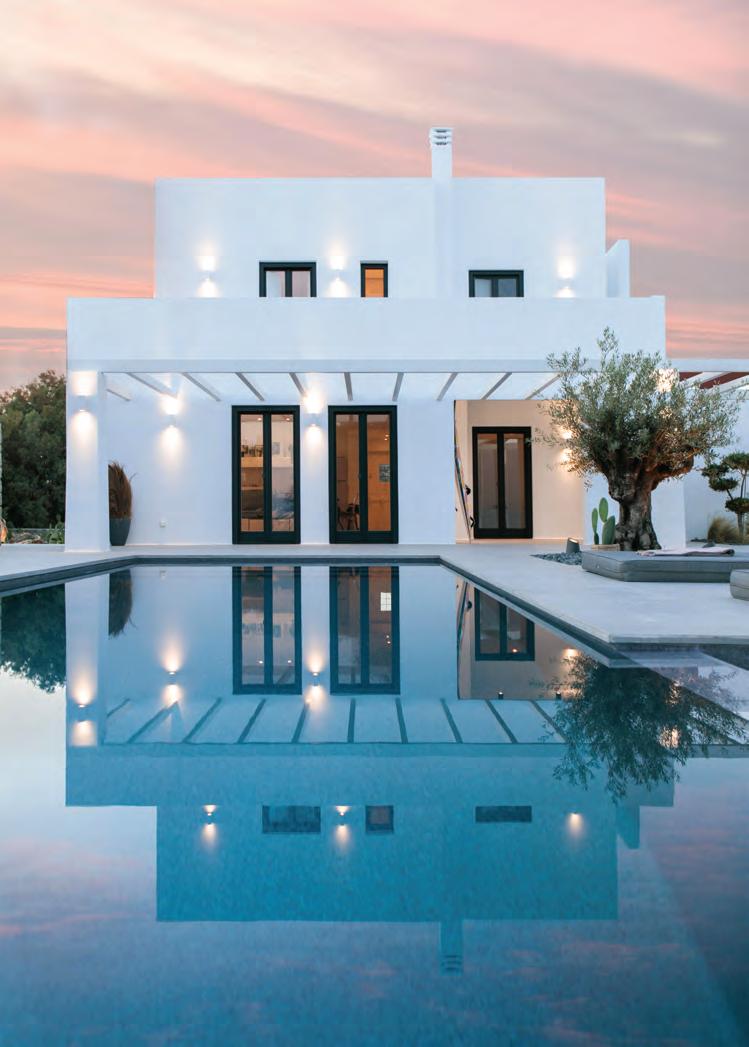

BY GEORGIA PAPASTAMOU
PHOTOS: ΑΝGELOS GIOTOPOULOS

Turquoise waters at Love Bay, which, according to tradition, got its name from the fishermen who used to gather here to share their catch with the poor.

A local resident takes a break on the doorstep of her house, in

TTWO TINY WOODEN boats, lashed tightly together. Two men rowing in unison, one grinning faintly at the absurdity of the scene, the other focused on the task at hand: to get across to Galatas, the mainland town that is visible in the distance. Perched precariously across the boats is a makeshift wooden platform, struggling under the weight of a Renault 4CV, the only car on the island at the time.
“This was Poros’ very first ferry,” laughs Dina Dagli, pointing to a black-and-white photo from the 1950s that hangs behind the counter of her family’s pastry shop, just above trays of snow-dusted almond sweets and spiced walnut confections. “Two rowboats joined together, with the local doctor’s car on top – Dr. Kounelis was his name. They’d row him across like that, car and all.” This charmingly improvised mode of transport says a lot about the nature of Poros itself, a pocket-sized island whose closeness to the mainland has always shaped its character. “C’mon, c’mon, nearly there,” you can almost hear the boatmen muttering in that old photo.
Today, while the modes of transport may differ, vacationers still arrive looking for a taste of the kind of summer they remember from childhood. Just five minutes by ferry from Galatas, Poros is also reachable from Piraeus in about an hour by hydrofoil (or two and a half hours by the slower, scenic route, which is perfect for spotting seagulls and glimpses of Aegina or the volcanic Methana peninsula).

Modest, pine-scented, and quietly nostalgic, Poros remains one of the lesser-known gems of the Saronic Gulf – and perhaps that’s exactly what keeps its charm intact.
It’s hard to walk around Poros without bumping into a memory or, if you're Greek, a familiar movie location. The island once served as the backdrop to “Alice in the Navy,” a classic ’60s Greek romantic comedy featuring the iconic Aliki Vougiouklaki, Greece’s “national star,” in a film full of capri pants, oversized hats and nautical flirts. Somewhere between the pine trees and the lapping sea, you can still imagine her bouncing a ball down the dockside.
But Poros has also drawn less flamboyant public figures. Nobel laureate George Seferis, one of Greece’s most
revered 20th-century poets, spent long stretches here with his wife, Maro, at Villa Galini, a stunning neoclassical guesthouse that once hosted everyone from Henry Miller to Greta Garbo. In his diaries, Seferis wrote of “the scent of pine and silence” he found on the island, words that still seem to hang in the air, despite the occasional beat coming from a beach bar.
That quiet still exists, just steps from Poros’ livelier spots, in shady coves where pine trees almost touch the water, casting their green reflections across the sea, on the weathered little piers and flowering patios in Neorio, or at the chapel of Aghios Athanasios, perched above the harbor.
If you look closely, you might even spot real-life doubles of the fictional characters from “Kyuka,” the dreamy, off-beat film by Greek director Kostis Charamountanis, which premiered at ACID Cannes in 2024, lingering in the alleys or sunbathing on a stone wall.

Poros is still a place of slow afternoons and sandals kicked under the table. It’s a place where tavernas welcome you straight from the beach, and cafés don’t mind if you’re still in your swimsuit when you sit down. It’s warm, unpretentious and human in scale, like the summers we thought we’d forgotten.
“This
Along the quieter stretch of sandy shoreline at Megalo Neorio, just before the romantic Love Bay and the picturesque (if occasionally boisterous) Russian Dockyard, local families paddle in the shallows under the pines. Behind them lies a strip of sand, a wooden bench, and just above, Petros Taverna (Leoforos Lambraki, Megalo Neorio, Tel. (+30) 22980.223.71).
This is where dreams of post-swim meals come true: stuffed tomatoes, moussaka, stewed green beans and slow-baked imam bayildi. It's a strictly

family-run affair: mother, daughter, grandmother and cousin all share the kitchen, still cooking with local olive oil and traditional care. Alongside homestyle stews, you’ll find grilled sardines and larger fish, served with wild greens and zucchini.
“Poros is our paradise,” says Sophia, the mother of the family, smiling as she brings over cold slices of watermelon for dessert. “I’m so happy to live here. We’re close to Athens, Nafplio, Corinth ... you can take day trips everywhere and still come back. Because Poros is so close to the mainland, it doesn’t isolate you. You never feel trapped.”
IT’S WARM, UNPRETENTIOUS AND HUMAN IN SCALE, LIKE THE SUMMERS WE THOUGHT WE’D FORGOTTEN.
Back in town, the rhythm quickens but the authenticity endures. At the traditional kafeneio Plateia (Koryzi Square, Tel. (+30) 22980.223.75), locals gather for midday ouzo in the shade. A retired sea captain, Vetas opened the place in 1975, and most regulars still call it by his name. Today it’s run by his stepson Giorgos together with Giorgos’ wife
Irini. They’ve kept it mostly as it was: a relaxed spot with a fine selection of local spirits best enjoyed while watching the boats drift in and out of the marina.
Order one of Irini’s meze plates – spicy meatballs, strong kopanisti cheese, cured sausage, crisp cucumber and sweet cherry tomatoes – and you’ll see why patrons keep coming back. In the evening, when the promenade fills with strolling visitors and the masts of the yachts bob in the harbor, they fire up the old machine by the door and serve loukoumades (Greek donut holes) the traditional way: hot, golden and irresistible.
Follow the coastal road toward Pounta, the old fishing quarter of Poros, and you’ll come across Casanova (36 Paraliaki Odos, Tel. (+30) 22980.352.94), an effortlessly
charming trattoria with whitewashed walls, red-checkered tablecloths, and a menu you wish existed in downtown Athens.
Here, Mediterranean recipes meet Italian and local ingredients, guided by inspirations from the owners’ travels. One day, you might find vitello tonnato garnished with pickled caperberries; the next, tender octopus from nearby Methana, slow-cooked in Sicilian wine. Dishes such as lobster tortelloni in prawn and sage broth or gnocchi with salsiccia showcase a cuisine that’s confident and exacting in its simplicity. With a well-made aperitivo in hand, you can nibble on pizza with smoky pancetta, gorgonzola and cracked black pepper; or dive straight into their legendary frutti di mare pasta, piled with shrimp, langoustines, mussels, clams, squid and a sauce so rich and briny you’ll want to spoon straight from the bowl. The tables fill with couples

lingering over dinner, regulars laughing under the stars, and visitors from around the world, some fresh off the boat from Epidaurus, others stepping ashore from high-end yacht charters out of Athens.
Just a few steps awayis a neoclassical building with the red door. It’s home to the Vessala Pâtisserie (Tel. (+30) 22980.258.90), where pastry chef Sotiria Aroni, a rising star of Greek confectionery, brings serious training and family tradition together in one immaculate kitchen.
After learning the craft beside her parents, Aroni studied chemical engineering with a focus on food science, mastered gelato at Carpigiani University in Bologna, explored viennoiserie in Paris, and trained in chocolate-making in the UK. Today, she continues to hone her skills while keeping her bakery strictly artisan: no ready-made mixes, no shortcuts.
She uses real eggs, milk from a cooperative near Nafplio, Aegina pistachios, and almonds from a trusted grower in Larissa. Her signature cakes, éclairs, custard pies and millefeuille with handmade puff pastry are all best-sellers, as is her ice cream: creamy kaimaki with mastic and floral notes, rich parfaits, and a bittersweet bergamot that lingers on the tongue.
From the family estate in Lemonodasos, the legendary “Lemon Forest” of Poros, she gathers the fruit for marmalades and traditional preserves. With

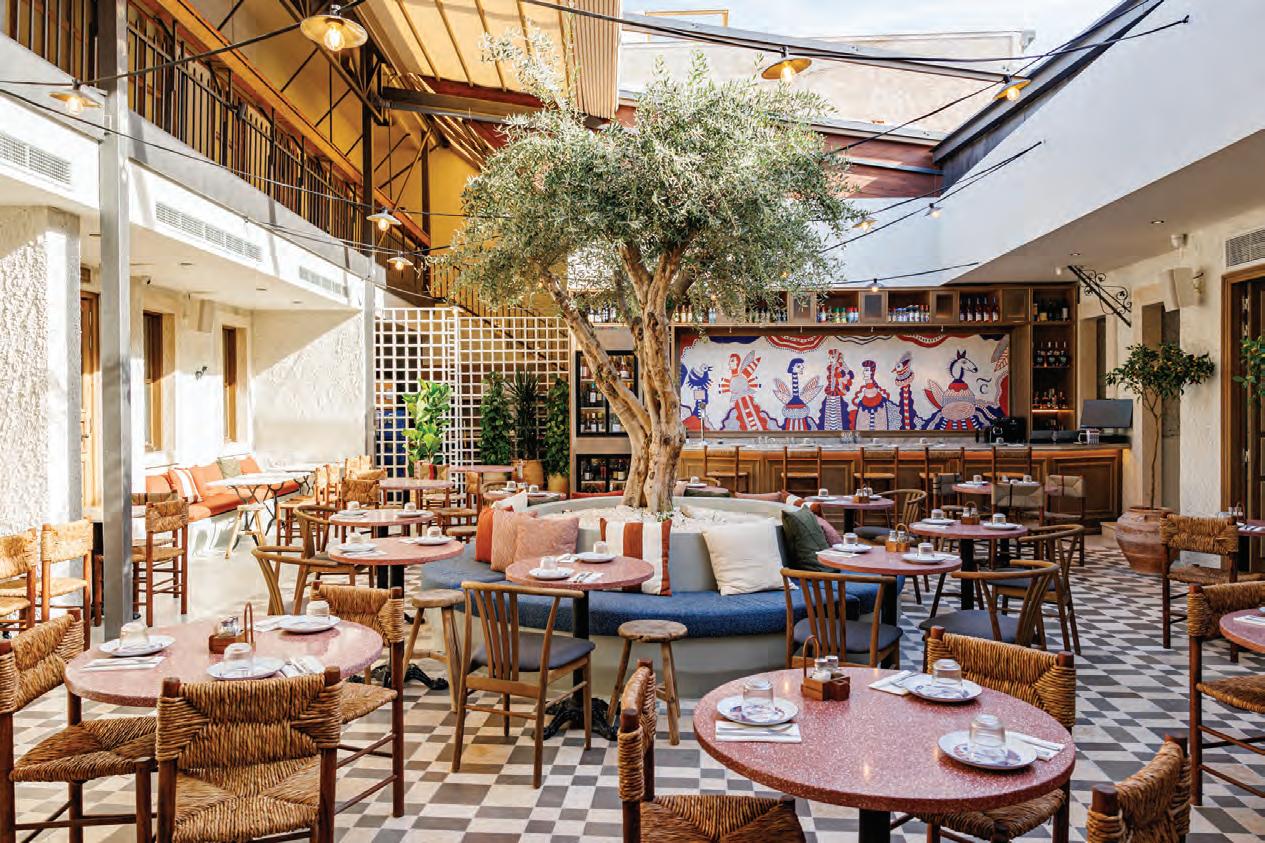

the juices, she makes vibrant sorbets – including a refreshingly tangy blood orange – and slushy granitas that taste like summer preserved in ice.
Poros might seem ideal for a weekend escape, but truthfully, the island resists being rushed. Two days aren’t nearly enough, particularly since you’ll probably spend your entire visit without ever getting in a car or on a scooter. Just walk between the neoclassical town of Poros and the pine-fringed Neorio Bay, dividing your time between swims, long lunches, and cultural detours to the Archaeological Museum (Koryzi Square, Tel. (+30) 22980.232.76) or the contemporary Citronne Gallery (Virvili Square, Tel. (+30) 697.998.9684), both small but rewarding.
You could, of course, venture farther. The island’s trails are laced with pine trees and scented by the sea breeze. Head north toward Vagionia Bay, a remote beach with crystalline waters, or to the Monastery of Zoodochos Pigi, an 18th-century landmark overlooking the coast. Walk up to the ruins of the

THE ISLAND’S TRAILS ARE LINED WITH PINE TREES
OVERLOOKING THE COAST.
Sanctuary of Poseidon, once a spiritual center of the ancient world. Each walk is short, scenic and best taken slowly, just like everything else here.
For a fitting start to the day, make a stop at Melistakto Café (Moni Zoodochou Pigis, Tel. (+30) 697.260.1190), just 200 meters from the monastery. Set on a leafy terrace under plane trees, it’s run by Meletis and his wife, Nektaria, who serve coffee with a side of local poetry and political passion. Meletis recites lines from Nobel laureate George Seferis by heart, discusses the community’s ongoing efforts to halt the expansion of fish farms in local waters, and tells stories that stretch from Demosthenes – who famously drank hemlock here – to Henry Miller, who once described walking through Poros as “floating.”
The blackboard menu is short and sweet: omelets, lemon preserves, homemade lemonade, a slice of savory pie, and a luscious galaktoboureko (a custard and semolina pie) made with locally sourced goat’s milk. There’s


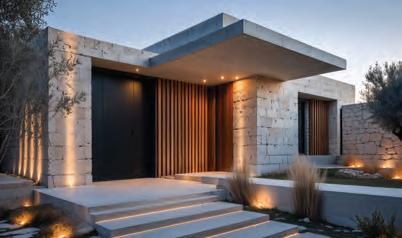
Motion. Order. Vision. Architecture

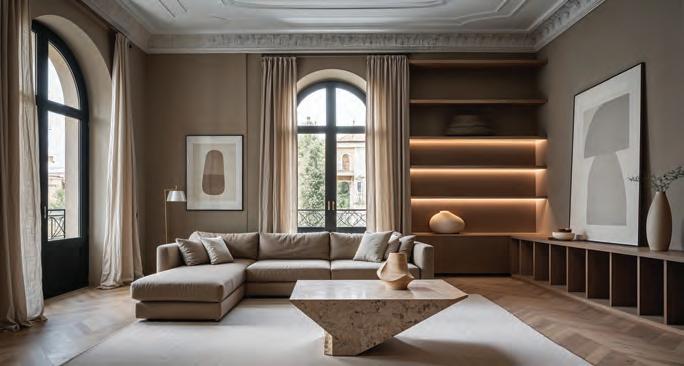
At MOVA, architecture and interior design are not separate disciplines — they are one continuous, intentional process. We don’t simply create buildings or decorate interiors. We craft spatial experiences that connect people to their environment through clarity, materiality, light, and purpose.
Our approach is strategic and interdisciplinary. We begin every project by studying real human needs: how people move, inhabit, and experience space. We consider context, orientation, natural light, scale, flow, and flexibility. From early layout concepts to the smallest crafted details, we design spaces that are intuitive, balanced, and deeply responsive.
We specialize in the full design of residences, villas, boutique hotels, workspaces, and concept stores. We provide holistic architecture and interior design services, combining structure with atmosphere, and construction with narrative. For us, interior design is not about finishes or objects — it’s about architectural thinking from the inside out.
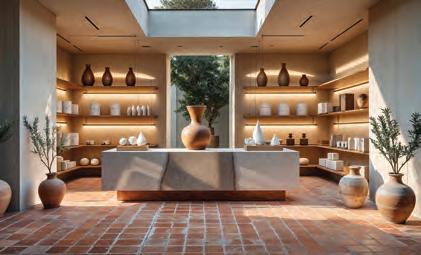
Every space we create is guided by four fundamental principles: Motion – Space must evolve with life.
Order – Harmony arises from precision, geometry, and intention.
Vision – Each project begins with a strong idea, clearly expressed.
Architecture – A well-designed space balances light, material, and structure into a meaningful whole.
MOVA represents a new creative voice in contemporary Greek design. With clarity, restraint, and substance, we shape environments that don’t just look beautiful — they feel lived in, thoughtful, and timeless. www.thisismova.gr
91 Agia Lavra Str - 11141. Τel.: (+30) 210 300 7016
53 Karolou Dil Str - 546 23. Τel.: +(30) 231 111 2722
even a spring nearby where you can splash your face with cold water before continuing toward Monastery Beach.
On the way to the Temple of Poseidon, make time for a meal at Paradeisos Taverna (Foussa, Tel. (+30) 22980.234.19), a much-loved spot in the woods. Under a canopy of grapevines and with beautiful sea views, they serve familiar classics such as lemony stews, dishes braised in red wine, and oregano-scented roasts, all perfect after a long swim or a slow afternoon hike.
Climb the alleys of Poros Town, starting from the blue-washed Clocktower, and you’ll soon come across Taverna Dimitris (12 25is Martiou, Tel. (+30) 697.450.6879), a beloved local spot that was once a butcher shop. The owner, Dimitris, is something of a character; a former seaman and radio operator, he knows a great deal about meat. Much of his expertise, he says, comes from an Irishman – descendant of a long line of butchers – who lived on the island for sixteen years and taught him the art of whole-animal butchery.
That’s why the taverna’s menu expanded beyond the usual lamb and pork chops to include robust T-bones, sirloins, and melt-in-your-mouth lamb fillet steaks. The grill still runs hot every night, with Dimitris’ nine children managing everything from service to the coals.
Just steps away, under the hanging lights of Flotér Bar (4 25is Martiou, Tel. (+30) 22980.238.21), you’ll find expertly mixed cocktails and what many say is the best gin and tonic on the island. It’s the perfect place to toast to the night as boats in the harbor glint under the stars.
POROS MIGHT SEEM IDEAL FOR A WEEKEND ESCAPE, BUT TRUTHFULLY, THE ISLAND RESISTS BEING RUSHED. TWO DAYS AREN’T NEARLY ENOUGH.
Before heading to the ferry, there’s one last essential stop: Daglis Pâtisserie (G. & K. Kostelenou, Tel. (+30) 22980.245.31), a local institution since 1976, renowned for its “pear-shaped” almond sweets. Step inside and breathe deeply – the air is perfumed with rose water, and the glass cases are filled with hand-rolled walnut pastries, scented with cinnamon, and the famed honeyed almond treats.
The secret? Whole, unblanched Greek almonds, boiled, peeled by hand, left to dry, then ground and mixed with honey, sugar and rosewater. Laborious, yes, but that’s where the flavor lies. And if you need something cool for the trip home, grab a scoop of their signature almond ice cream, rich and subtly floral – a final, delicious souvenir of Poros.•

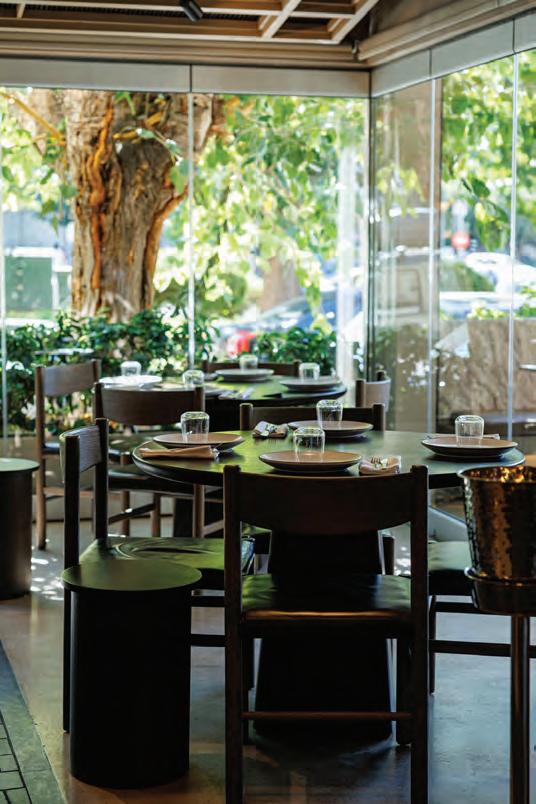




FROM HIP-HOP TO HYBRID FOLK, THESE MUSICIANS ARE RESHAPING TRADITION WITH BOLD SOUNDS AND FRESH IDENTITIES.
BY BYRON KRITZAS



She first appeared on Super Idol in 2004 and spent years performing in mainstream clubs without ever quite breaking new artistic ground. But in 2025, at 44, Tamta has reinvented herself as the pop star Greece didn’t know it needed. Drawing from queer culture, electro nostalgia and avant-pop flair, Tamta now channels a bold, techno-glam aesthetic that links FKA twigs with Athens' underground. Her transformation’s visually stunning and emotionally resonant. While some still debate her provocative style, her fearless break from conventional showbiz norms feels both radical and refreshing.

Summer 2020. As Greece slowly emerged from its first lockdown, a 17-year-old girl gave her first impromptu live performance on Dionysiou Areopagitou Street, right beneath the Acropolis. That girl was Marina Spanou, and she quickly became a viral sensation. Her music captures the tenderness of a love letter: songs about travel, longing, sunsets and bittersweet mornings. In 2024, Ταξίδι (“Journey”), which she wrote and composed herself, firmly established her as a new voice in contemporary Greek songwriting.
You could call him the king of Greek hip hop – but LEX would probably cringe at the title. Reserved and quietly uncompromising, he’s the country’s most respected and successful rapper, and he did it all on his own terms. Hailing from Thessaloniki, LEX made his way into tens of thousands of homes without major media coverage – armed only with his razor-sharp lyrics. His songs speak of social injustice, urban life, disillusionment and resilience. His 2018 album 2ΧΧΧ is already considered a classic, and last June he pulled in 60,000 fans for one of the country’s biggest concerts of all time.



Marina Satti
It’s been nearly a decade since Marina Satti casually uploaded a playful take on the folk classic Tha Spaso Koupes (“I’ll Smash Cups”), a video that went viral without much expectation. Today, she’s perhaps the most exciting voice in Greek mainstream music. Think of her as the queen of kitsch revenge: catchy pop tunes that flirt with bad taste and spin it into gold, served with unapologetic color, swagger and aesthetic verve. Over the years, Satti brushed off the critics, built devoted Gen Z and queer fanbases, represented Greece at Eurovision and challenged stereotypes about age, femininity and fashion. Can you wear long blue nails and dress like a teenager at 40? Her answer is a resounding yes.

Pan Pan creates indie pop for those who go dancing and to therapy, care about inclusion and thrive in queer-friendly spaces. A veteran of the underground, he spent over a decade with a loyal but niche following until everything changed in 2021 with the breakout hits
(“Hit Me Like a Jolt on the Dance Floor”) and
(“Uneven Disco”). The songs swept through clubs, weddings, playlists and even Greek TV series. Pan Pan gave introspective young people a voice and encouraged a wave of emerging artists to keep going as he modeled patience, vulnerability and joy.
Two sisters, two actresses turned singers, two feminists who took a DIY spirit and turned it into a national phenomenon: Skiadareses is what happens when wit, frustration and female friendship meet a beat. They sing, without filters or formulas, about everyday messiness, bad dates and chaotic summer nights. What started as a YouTube project exploded into festival appearances and cult-favorite anthems. They’re the band that you and your best friend dreamed of starting, but never actually did.



A Modern Meze Shop Comes to Life in the Heart of Athens
At Mezze Athens, flavour takes centre stage — from early morning until late at night. Your day begins with the rich aroma of freshly brewed coffee and a lovingly prepared breakfast, offering a warm and satisfying start. From midday onwards, the table is set with an array of tempting appetisers, succulent meats, and fresh seafood, all crafted with pure,
locally sourced ingredients. This contemporary take on the traditional meze shop blends time-honoured recipes with modern flair. Our chef draws daily inspiration from the local market to create a menu filled with stand-out dishes.
Mezze Athens is more than just a restaurant — it’s a culinary experience filled with authenticity, warm hospitality, and the true spirit of Athens.
12-14 Mitropoleos Street, Athens +3021 0331 2300 mezzeathens mezze_athens mezzeathens.gr
Branch: Dimarchou Angelou Metaxa Avenue, Glyfada +3021 0898 0480

4 Filellinon Street, Athens +3021 0322 6087 zoubourlou zoubourlou_ zoubourlou.gr
Branch: 4 Aischylou Street, Athens +3021 0331 4854


The Flavour of Constantinople’s Tradition in the Heart of Athens
Zoubourlou opens its doors at 4 Filellinon Street in Syntagma, bringing the sweet, authentic essence of Constantinople to the heart of the city.
Indulge in traditional, syrup-drenched sweets — from the rich and aromatic künefe with its golden, crispy layers and molten cheese, to exquisite chocolate creations that promise a full-bodied taste experience.
Our menu also features a unique selection of authentic gözleme pies, crafted with handpicked ingredients and a distinct aroma that evokes the flavours of a bygone era.
From early morning, Zoubourlou offers a refined breakfast menu, with a focus on quality and tradition. Fluffy omelettes, hearty sandwiches, handmade pancakes, and other delicious options ensure a dynamic and satisfying start to your day.
No matter where you are in Athens, Zoubourlou invites you to discover the flavours, aromas, and warmth of Constantinople — in its own unique and unforgettable way.

A leading voice of modern Greek music, Natassa Bofiliou has spent 15 years delivering powerhouse vocals and emotionally rich performances. Her songs explore love, politics, and personal awakening with the dramatic flair of Marinella and the vocal strength of Anna Vissi. While her designer wardrobe has sparked some controversy regarding the depth of her political commitment, she remains a commanding and sincere artist, and besides, in Greece, debating your favorite singer’s lifestyle is half the fun.

As the frontman of the beloved Greek pop band Melisses, Christos Mastoras has long been a household name. He’s sung duets with legends such as Giorgos Dalaras and Haris Alexiou, served as the soft-spoken judge on TV talent shows, and shown his social conscience – most notably in 2021, when he met with the Greek Prime Minister to advocate for the insurance rights of thousands of Greek expatriates from Northern Epirus. He also earned serious acclaim as an actor when he portrayed the legendary Greek singer Stelios Kazantzidis in the 2024 biopic Υπάρχω (“I Exist’). With uncanny vocal mimicry and emotionally layered performances that spanned every stage of Kazantzidis’ life, Mastoras delivered what many called the performance of his career, earning praise even from the most skeptical viewers. Humble, kind and consistently sincere, Mastoras continues to be Greek showbiz’s “good guy,” with a rare combination of talent, decency and staying power.
Located just steps away from the Acropolis Museum and the Acropolis Metro Station, Liondi offers a warm Greek welcome and a truly traditional culinary experience. Our restaurant is a favorite among locals and visitors alike, known for its hospitality, heartwarming dishes, and unbeatable location.
At Liondi, we proudly serve authentic Greek cuisine, crafted with fresh ingredients and inspired by family recipes passed down through generations.
Try our famous moussaka, or indulge in our slow-cooked oven-baked lamb, served with rice and aromatic local herbs. For seafood lovers, our grilled fish selections are always fresh and perfectly prepared.
Pair your meal with a glass of fine Nemean wine, straight from the vineyards of the Peloponnese, and enjoy the vibrant flavors of Greece in every sip.
Whether you’re visiting Athens for the first time or returning to your favorite city, Liondi invites you to taste the soul of Greek gastronomy—right next to one of the most iconic monuments in the world.
Come as a guest, leave as a friend.
Kalos orisate!
Makrigianni 19-21, Athina 117 42 Tel: 21 0921 9994 liondi.com




Bloody Hawk’s world is one of raw emotion, internal struggle, loyalty, heartbreak and hope. It’s a world that many young Greeks can really identify with. While the Greek trap scene has its own stars (Trannos, Light, Snik and Toquel), Bloody Hawk stands apart with his uncompromising dedication to pure, old-school hip hop, earning both wide popularity and critical respect. This year’s biographical documentary Εμείς (“We”) traces his story from childhood in Xanthi to sold-out shows around the country. Much like LEX, Bloody Hawk rarely gives interviews, letting his lyrics do the talking.


At just 24, Marseaux is already a pop powerhouse. With TikTok reach, major brand deals and headline performances across Greece, her energetic, dancefloor-ready sound fuses pop with hip hop and attitude. Back in 2021, she was chosen as Greece’s ambassador for Spotify’s global EQUAL campaign, landing her face on a billboard in Times Square. Today, she continues to dominate charts and social media with bold lyrics, big collaborations (especially with rapper Snik), and addictive charisma. As she proclaims in her latest hit Τρέλανέ μας (“Drive Us Wild”): “All of Greece prefers Marseaux.”
Billie Kark proves that loving tradition doesn’t make you oldfashioned. At just 24, she blends folk melodies with ambient electronica, smooth vocals and minimalist beats, bridging past and future with striking originality. While her 2024 single Πάρτι (“Party”) brought her mainstream attention, her real strength lies in songs that evoke village fairs, rrural spirits and ancestral stories, all wrapped in a soundscape that make you want to dance or daydream.


From the city’s neoclassical treasures and its many churches containing visible material from earlier structures to the everyday role of religion in ancient times and the magic of Mt Parnitha.
commissioned in 1959 by the Greek National Tourism Organisation.


As Greece’s landscape and antiquities became more familiar to Westerners, strong rivalry developed between ancient Greek and Roman enthusiasts. The poet John Milton extolled Athens in 1671 as “the eye of Greece, mother of Arts wand Eloquence.”
BY JOHN LEONARD
PHOTOS: PERIKLES MERAKOS

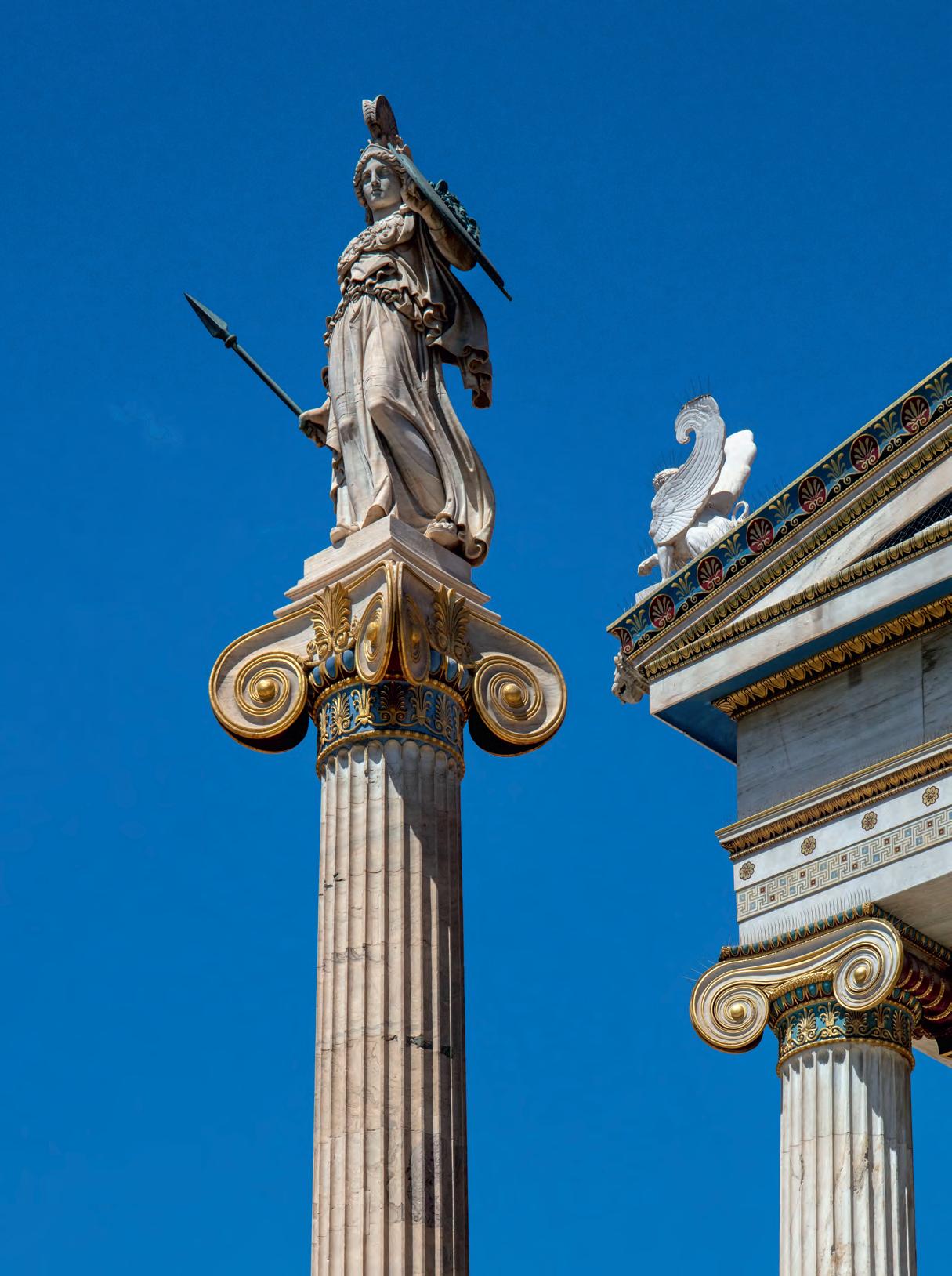
IIN ATHENS, WE ARE clearly at the epicenter of ancient Greek history and its cultural legacy. While many people today are familiar with Pericles’ great 5th-century BC Doric Parthenon temple on the Acropolis, what about the countless neoclassical-style public buildings and residences seemingly sewn everywhere into the fabric of contemporary Athens’ cityscape? Where did this architectural style come from? Directly through local appreciation for the Parthenon and similar ancient relics? No, ancient Greek art and architecture had to find its way abroad first, before later returning to its birthplace in a neoclassical movement that has made a meaningful, aesthetically charming contribution to modern-day Greek identity and the Athens experience.
Ancient literature has been an important thread through the historical eras since antiquity, including not only the works of Homer, Plato and Aristotle, but also those of Virgil and Vitruvius, too. By definition, the classical world constitutes both ancient Greece and Rome. The material remains of these two civilizations may have been covered by the dust of time, but many writings of ancient authors persevered. Ancient Rome, being more recent and relatively accessible, left more traces – both literary and architectural. This fact played a role in the rise of the Renaissance (14th-early 16th centuries), when classical culture first reemerged from the “darkness” of the Middle Ages.
Renaissance humanists and architects in Italy were naturally influenced by ancient Rome’s ubiquitous ruins. De Architectura, the Augustan architect Vitruvius’ seminal work in Latin, was revived in the early 1400s. Architecture in the Renaissance era, as envisioned by such great figures as Leon Battista Alberti, Donato Bramante, Michelangelo and Andrea Palladio, thus evoked more of the building methods and styles of the ancient Romans than of the Greeks.
Palladio, working in the Veneto region and particularly in Vicenza, employed various architectural orders in his designs of “classical” churches, palaces, urban villas and country houses. In their own buildings, the ancient Roman architects who inspired him had adopted, and adapted, the three Greek orders (Doric, Ionic, Corinthian) while also employing a native Tuscan order and a fifth style later identified in the Renaissance as “Composite” – a more elaborate form of Corinthian. Hallmark features of Renaissance classical buildings include the Tuscan style’s simplicity, frequent arcades (arch-enclosed walkways), arched windows, loggias (colonnaded walkways set into a building’s facade), decorative dentils and intricately adorned Corinthian entablatures. Palladio’s designs were especially influential, later contributing to the architecture of country houses in England.
Following the Renaissance, a fashion arose among well-to-do western Europeans with a love for history and the arts to travel on grand tours across Europe to Italy. In the early 18th century, young British aristocrats and intellectuals of the Society of Dilettanti began adding Ottoman-ruled Greece to their itinerary, as it offered fresh, challenging adventures to their grand
tour. The Parthenon in Athens was, as it is today, a star attraction, often sketched and painted with varying degrees of precision by travelers that included Richard Pococke (1745), Richard Dalton (1751) and Julien-David Le Roy (1758).
As Greece’s landscape and antiquities became more familiar to westerners, a strong rivalry developed between ancient Greek and Roman enthusiasts. The poet John Milton extolled Athens in 1671 as “the eye of Greece, mother of Arts and Eloquence.” Nevertheless, Greek antiquities were still viewed as curiosities, relates architectural historian Lena Lambrinou (NTUA), with the English clergyman and travel writer George Wheler writing in 1678 that he preferred them “almost” as much as Roman antiquities.
Ancient literary appreciation for Greek nature, beauty and, in particular, the mythical land of Arcadia, as expressed par excellence in Virgil’s 4th and 10th Eclogues, was picked up by Renaissance and subsequent authors and painters. During the Enlightenment, this newfound admiration and romantic vision of Arcadia contributed significantly to the development of the neoclassical Greek Revival in architecture and the Romantic movement of artists and intellectuals in the 18th and 19th centuries. The picturesque sketches and paintings of Greek antiquities by early travelers stirred artists, antiquarians and architects to produce a diverse array of Greece-inspired works, to collect Greek artifacts and to design fanciful gardens adorned with pseudo-classical “follies” (small ornamental buildings). As the Scottish history painter Gavin Hamilton stated in 1779, “the most valuable acquisition a man of refined taste can make is a piece of fine Greek sculpture.” British builders at this time, however, generally viewed Grecian architecture as a decorative style only suitable for garden adornment, not for mainstream projects.
The elegant Stathatos Mansion (1895), now the Museum of Cycladic Art.

The visit to Athens by British architects James Stuart and Nicholas Revett in 1751-1753 proved a defining moment for the advance of neoclassical architecture. Never before had such fine drawings been made and so impressively published (4 vols., 1762-1816). These highly precise drawings continue to be important today, according to Lambrinou, as some of them remain the only proper architectural documentation we have for certain Athenian antiquities – such as the Doric Gate of Athena Archegetis at the entrance to the Roman Agora.
Following the publication of Stuart and Revett’s second volume
-INSPIRED WORKS.
in 1789, the Parthenon and other Athenian antiquities became closely studied models, whose Doric, Ionic and Corinthian features would be incorporated into a wide range of neoclassical designs. No longer did architects need to travel to Greece themselves to gain familiarity with the relics of ancient Greece. The Parthenon, perhaps due to its imposing proportions, continued for a time to be considered an inappropriate archetype for residences, although now more-true-to-life classical elements from the facades of smaller Athenian structures and temples (e.g., Propylaia, Hephaisteion) were incorporated into British garden temples beginning in the late 1750s.
The mid-18th century also marked a pivotal point in neoclassicism thanks to Johann Joachim Winckelmann, a pioneering German art historian and expert on Roman sculpture. As he famously opined in 1755, “the only way for us to become great or … inimitable … is to imitate the ancients … especially the Greeks. One must become as familiar with them as with a friend.” Winckelmann’s views on the works of ancient Greek sculptors, which exhibited “a noble simplicity and quiet grandeur, both in posture and expression,” kindled greater popular appreciation for classical styles in both art and architecture. His writings, furthermore, gave wide exposure to recent archaeological discoveries at newly unearthed Herculaneum (1738) and neighboring Pompeii.
The arrival of the Parthenon sculptures in London in 1803 served as a further catalyst for the public’s growing taste for Greek antiquities. Purchased from Lord Elgin by the British Museum in 1816, one year after the Battle of Waterloo, the collection from Classical Greece now took on great meaning, according to the museum’s late curator Ian Jenkins: “Just as the Parthenon had once commemorated Athens’ victory over the Persians at the Battle of Marathon, so now its sculptures would commemorate England’s triumph.”
As international conflicts came to a head and great political changes occurred in the dynamic late 18th and early 19th centuries, neoclassicism in France likewise evolved through a series of successive styles (Louis XIV, XV, XVI; Directory; Consulate), culminating in the Empire style during the lead-up to the Napoleonic Wars
(1803-1815). Envisioning himself as a new Caesar, Napoleon embraced this strongly Rome-evoking neoclassical architecture, which for him operated as visual propaganda. After Waterloo, however, European tastes turned away from imperial France, while the Greek Revival movement, combining Greek and Roman elements, reached new heights.
Beauty and the picturesque were no longer enough; now a neoclassical style reflecting grandeur and dignity was called for amid a new age of republicanism and national struggle. Periclean Athens and the Parthenon were equated with democracy and national unity. In Bavaria, Ludwig I, father of Greece’s future king Otto, commissioned the Walhalla, a national monument inspired by rising nationalist feeling and the Germans’ recent triumph over Napoleon at Leipzig (1813), which would be designed by architect Leo von Klenze and modeled on the Parthenon.
Before the Walhalla was completed (1842), the Parthenon, a timeless symbol of democratic independence over an invading imperialistic force, also came to be viewed as a national icon by the Greeks fighting to free themselves from the Ottoman Empire during the Greek Revolution (1821-1829). As the philhellenic movement intensified, the Periclean temple became a focus for the budding Greek nation’s historical identity, according to Lambrinou.
In Scotland, as well, the city of Edinburgh, the self-styled “Athens of the North,” decided to erect a Parthenon-inspired monument commemorating the fallen heroes of the Napoleonic Wars. Designed by Charles Robert Cockerell and William Henry Playfair, it was left uncompleted in 1829, its twelve Doric columns still standing today.
Spreading through Western Europe, neoclassicism eventually crossed the Atlantic with the Hellenophile architect Benjamin Henry Latrobe in 1796. Known for redesigning and completing the US Capitol Building (1811), Latrobe also helped to restore the building (1815) after it burned during the War of 1812. The Parthenon’s symbolism inspired many American designers, as did other Athenian structures (e.g., Thrasyllos Monument) and the Pantheon in Rome. By the 1840s, the Greek Revival style had become a common choice for banks, state capitols and other government buildings around the country, including the Second Bank of the United States (Philadelphia, 1824) and Federal Hall on Wall Street (New York, 1842). Grecian architecture was also popular among affluent mansion owners in the South.
Intriguingly, in Washington DC, one can find an original orthostate block from the Parthenon, donated by the Greek government in 1856, set into a wall inside the Washington Monument. In addition, an exact,

full-scale replica of the Parthenon stands in Nashville, Tennessee, completed in concrete in 1925 in consultation with architectural historian William Dinsmoor. Another replica, this one of the chryselephantine cult statue of Athena herself, was installed in the Nashville temple in the 1990s.
On the other side of the globe, Australia’s neoclassical Shrine of Remembrance, built in Melbourne in 1928-1934, combines inspiration from the Parthenon, the Lysicrates Monument and the Mausoleum of Halicarnassus. Like the original Parthenon, its Doric columns exhibit swelling (entasis) and lean inward, while all its vertical lines incline to a theoretical point of convergence high above the building.
IN NASHVILLE, TENNESSEE, COMPLETED IN CONCRETE IN 1925 IN CONSULTATION WITH ARCHITECTURAL HISTORIAN WILLIAM DINSMOOR.
As neoclassical styles blossomed in Europe, Athens itself became a center of Greek Revival architecture over the course of the 19th century. A multinational array of architects, including the Danish brothers Christian and Theophil Hansen and numerous Germans, especially the prolific Ernst Ziller, were drawn to the city from as early as the 1830s. Many of their buildings are Athenian neoclassical monuments that can still be seen today. Visitors exploring central Athens around Syntagma Square, Omonia Square and the Acropolis will find amazing neoclassical buildings at almost every turn. A good starting point for
an architectural walking tour might be the Old Palace (1833-1834), now the City of Athens Museum (5-7 Ioanni Paparrigopoulou, Klafthmonos Square), where King Otto and Queen Amalia first resided (1836-1843). Directly overlooking Syntagma Square is the Hellenic Parliament. This imposing building with its Doric porches was originally constructed (1836-1842) as a palace for the royal couple. On Vasilissis Sofias Avenue across from the Parliament stands the neoclassical Syngrou Mansion (after 1872), now the Foreign Ministry, while the nearby Harokopos/ Benaki Mansion (1860s, first expanded 1911), now the Benaki Museum, and the Stathatos Mansion (1895), now the Museum of Cycladic Art, can be seen further along the same avenue.
Neoclassical buildings equally reflective of the affluence of Athenian society in the era of King George I (reigned 1863-1913) include the Presidential Mansion (1897) and the Zappeion (begun 1874-1888), located respectively east and south of the National Gardens. On Panepistimiou Street, Heinrich Schliemann established his private residence, the Iliou Melathron (1880), now the Numismatic Museum. Today, this must-see monument allows you to walk in the footsteps of the “father of Greek archaeology,” marvel at the home’s luxurious interiors and trace Greek history through fascinating gold, silver and bronze coins.
Greatest among the city’s neoclassical treasures is perhaps the “trilogy” of Athens, also on Panepistimiou Street, comprising Athens University (center, 1839), the Academy of Athens (right, 1859) and the National Library (left, 1888). Here neoclassicism and ancient Greek antiquity are on full display, with the academy’s temple-like pediment showcasing a sculptural scene depicting the Birth of Athena (echoing the Parthenon’s east pediment). Seated beside the entrance are the philosophers Plato and Socrates, while standing majestically above on tall Ionic columns are Athena, the warrior goddess and Athens’ divine
DIRECTLY
OVERLOOKING SYNTAGMA SQUARE IS THE HELLENIC PARLIAMENT. THIS IMPOSING BUILDING WITH ITS DORIC PORCHES WAS ORIGINALLY CONSTRUCTED AS A PALACE FOR THE ROYAL COUPLE.
patroness, and Apollo, protector of the arts and leader of the Muses.
Beyond, near Omonia Square, one finds the National Theater (18951901) on Aghiou Konstantinou Street. Designed by Ziller, it was inspired in part by Vienna’s Burgtheater. Adjacent to the Acropolis, the National Observatory (1846) stretches skyward beside Pnyx Hill, where the ancient astronomer Meton (5th cent. BC) reportedly determined the dates of equinoxes and solstices for his eponymous lunisolar calendar by observing sunrise.
These are only the most prominent of Athens’ neoclassical gems; many more, great and small, can be sleuthed out, not only in the capital city but across Greece. Ziller himself contributed to over 500 public and private neoclassical buildings from 1870 to 1914. Sometimes his most humble but elegant designs lie in plain sight, including the diminutive train station at Ancient Olympia. Caryatids evoking the Athenian ladies of the Erechtheion have long been popular neoclassical elements, and today’s eagleeyed explorer in Athens’ Psyrri district will find the “House with the Caryatids” (45-47 Aghion Asomaton) – an example of the city’s early 20th-century folk architecture. Now the heritage-listed headquarters of the Association of Greek Olympic Winners, its former owner, sculptor Ioannis Karakatsanis (18571906), is said to have employed his wife and her sister as models for his decorative sculptures.
One of the most recent Athenian neoclassical monuments to be restored and revitalized is the Athinogenis Mansion (1875-1880, 50 Stadiou). Its opulent, sophisticated facade reveals both neoclassical and then-up-and-coming French Baroque Revival styles. Left in a state of ruin and severely damaged by fire in 2004, the mansion is now part of a newly constructed, multi-use complex expected to open in 2026.
Athens’ neoclassical buildings are truly cultural treasures that deserve to be explored, preserved and cherished. For the curious, let the hunt begin!•
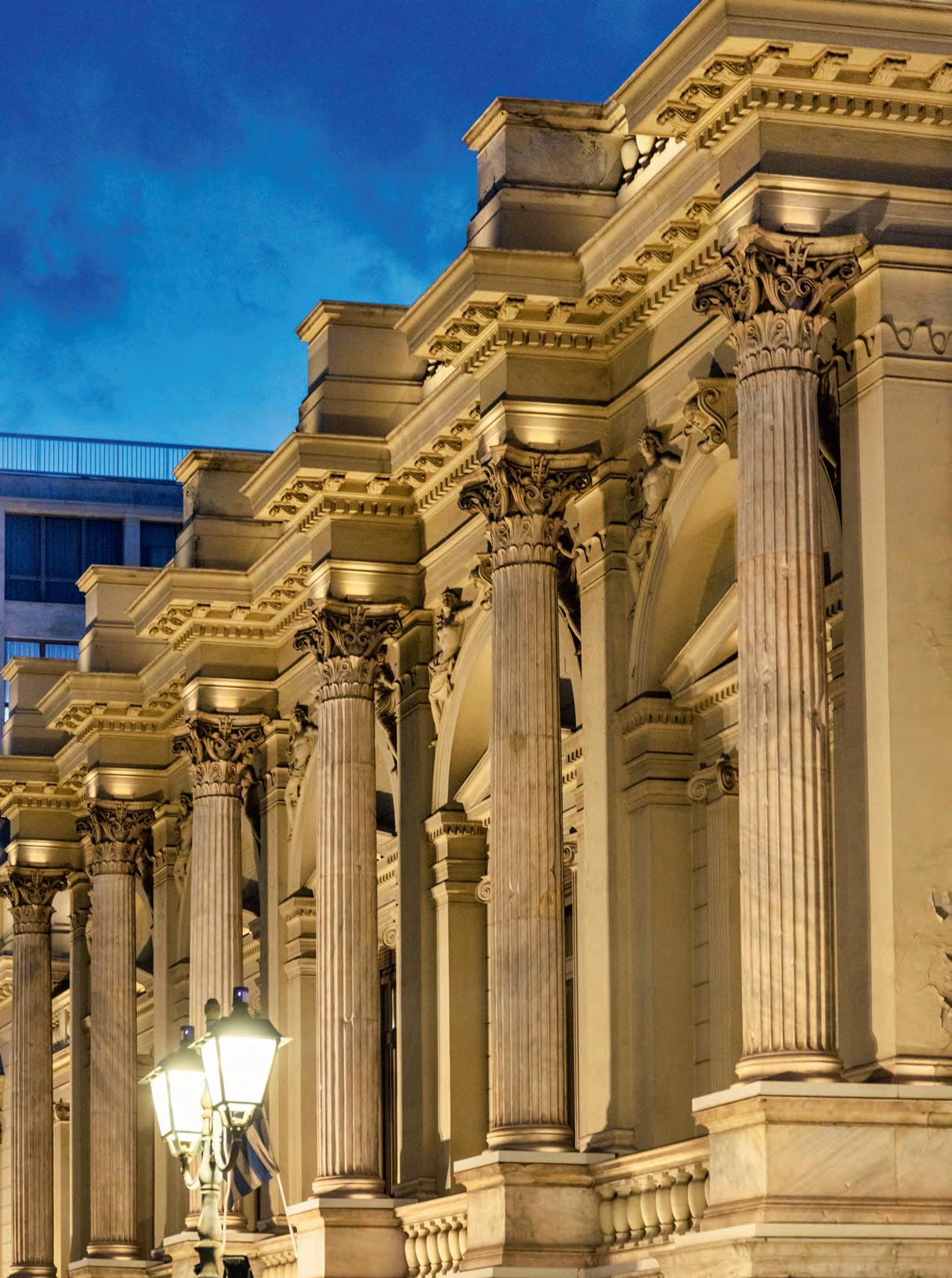

RECYCLING IS AN AGE-OLD TRADITION IN RELIGIOUS CONSTRUCTION; MANY OF THE CITY’S MOST BEAUTIFUL HOUSES OF WORSHIP WERE BUILT IN PART WITH MATERIAL FROM EARLIER STRUCTURES.
BY DEMETRIOS IOANNOU PHOTOS: PERIKLES
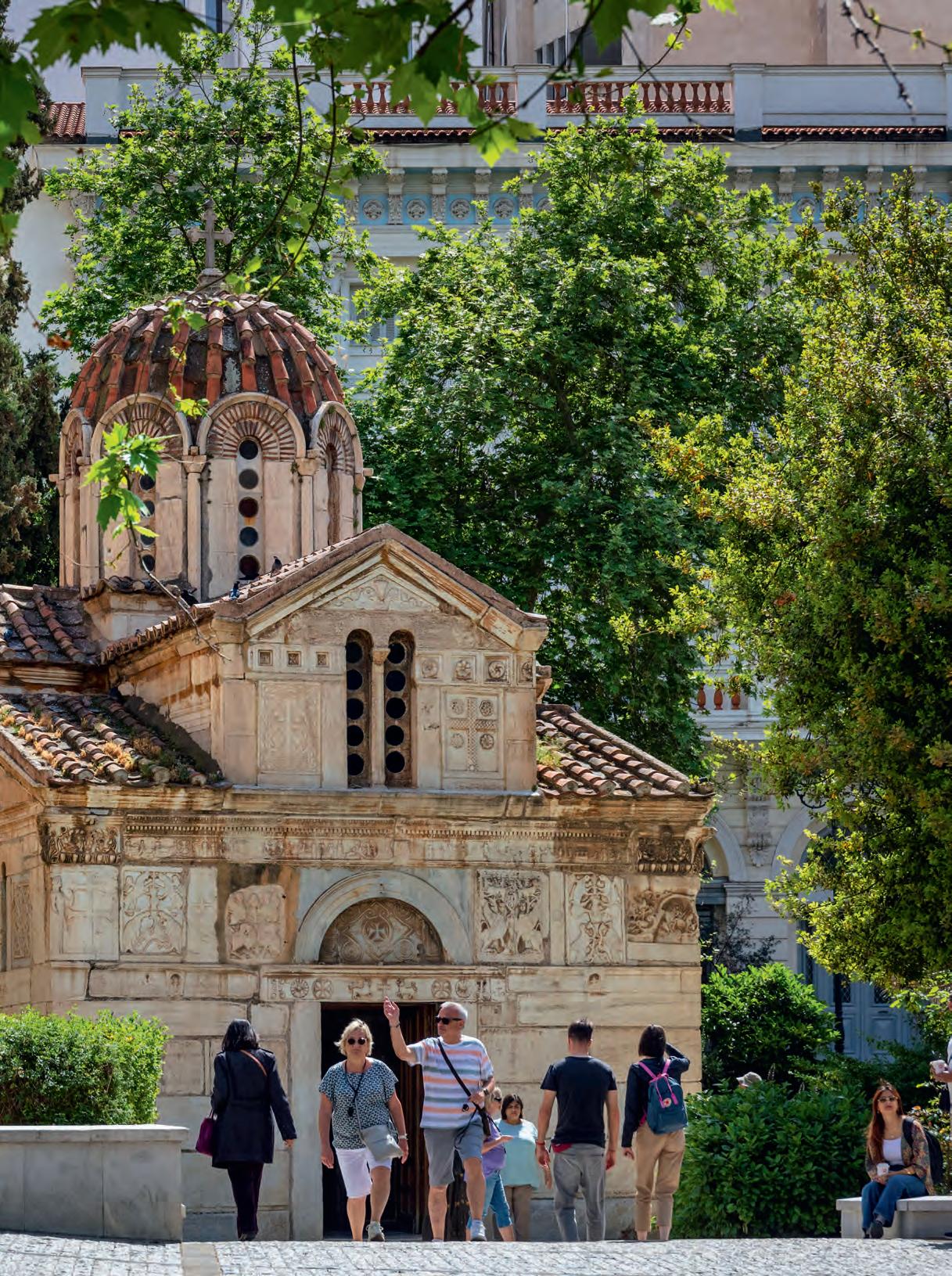
The Church of Panagia Gorgoepikoos and Aghios Eleftherios, also known as “The Little Metropolis.”
WWHETHER YOU’RE A BELIEVER OR NOT, it’s impossible to stroll down the streets of Athens without noticing the beautiful little churches on nearly every street corner. Made of stone, bricks and marble, most are masterpieces of ecclesiastical architecture. But many of them have something else to show that can easily go unnoticed. They also incorporate pieces of ancient ruins in their structure or the immediate surrounding area.
Following a period of glory that made it the envy of its neighbors, Athens was ravaged by multiple invasions. First came the Romans, who stayed in Athens for over 180 years. Next were the Heruli, in AD 267, and then the Visigoths in 395. By the start of the Byzantine era, Athens was far from the glorious city that it had once been during the Golden Age of Pericles.
The city needed to be rebuilt. As was common practice at the time, Athens was reconstructed with spolia, materials salvaged from the ruins of destroyed buildings. This practice extended to the first churches constructed in the service of the new religion, Christianity, which was spreading rapidly. “There was a recycling process, and those building materials were reused indiscriminately without any problem. It could be a piece of a stone inscription, a piece of a statue, a chapiter, anything. Of course, not only were churches built with this material, but city walls, houses, public buildings – everything was,” says Georgios Pallis, associate professor of Byzantine and Post-Byzantine archaeology and art at the National and Kapodistrian University of Athens.
The first churches in Athens began to appear in the 5th century, but numbers really took off as the city flourished from the 10th century onward. At that time, a new era in architecture emerged in Byzantium, characterized by domes, cross-shaped roofs and the purely decorative combination of stone and brick on exteriors that gives these structures their distinct color. “Athens had quite a few of these new churches, at least 40 or 50, that were built from the 10th century and afterwards,” says Pallis. Due to their architectural design, they needed columns, capitals and marble. Athens had been a city full of marble since antiquity. “There were places in the city where one could obtain abundant amounts of marble: the Panathenaic stadium, for example, as all its seats, the benches, were made of marble. All of these disappeared. They were either made into lime, or the marble was reused to construct mainly new places of worship and decorative reliefs.”
The greater metropolitan area of the Greek capital is dotted with hundreds, if not thousands, of churches, around 20 of which date from the Byzantine era and remain in use to this day.
(“Ragavas”)
Not far from the Cathedral of Athens, in the heart of Plaka, one of the oldest neighborhoods in the world, sits one of the city’s most beautiful Byzantine churches. The Church of Aghios Nikolaos Ragavas, is one of many houses of worship constructed during the 11th century in an area which, in Byzantine times, was considered the most aristocratic part of the city.
Some churches around Athens bear a nickname; in this case, it is “Ragavas.” These names are believed to refer to the families that built these churches, or sometimes to the wealthy commoners or aristocrats who were buried in them. In 1979, during conservation work, architects and archaeologists discovered an inscription in Byzantine-era letters in the dome; it was a supplication to God signed by Leon Ragavas, who’s believed to have commissioned the church. It’s also believed that the Byzantine empresses Irene of Athens and Theophano of Athens resided in the parish of Aghios Nikolaos before they went to Constantinople.
The original church, which today makes up half of the current one, was a simple, four-column cruciform structure. Its construction used architectural pieces taken from ancient buildings, including an inverted chapiter on the northeast side, a column at the entrance to the courtyard, and an inverted marble chapiter in Corinthian style which supports the sanctuary.


Like the Church of Ragavas, the Church of the Transfiguration of the Savior, also known as Sotira Kottaki, on Kydathineon Street that connects Monastiraki with Plaka, may have taken its nickname from its founder, possibly named Kottakis.
The church, constructed in the first half of the 11th century, was extended at least three times over the years in order to accommodate a burgeoning flock. “What we see of the original church is the eastern side and the dome,” says Pallis. “As Athens’ population grew and grew, these small Byzantine churches could not accommodate enough people, so they were gradually expanded. Walls were demolished and additions built; Sotira Kottaki has almost tripled its size, at the cost, of course, of the loss of three sides of the original building from its Byzantine phase.”
In its original form, the structure was a simple four-column cruciform Byzantine church with a dome; the dome is supported by the four columns. Those ancient columns stand out the moment you enter the building. In addition, in the western courtyard – today used for parking – also lie several ancient architectural fragments of unknown age. As Pallis points out, columns that do not have a relief or a design on them are hard to date, and therefore attract little attention these days. However, in the past, columns were considered valuable objects. “We have a record from the time of Venetian rule indicating that a wealthy man gave his daughter a dowry of five marble columns, which she could have either sold to raise a lot of money or used to build her own house,” he explains.


“WE HAVE A RECORD FROM THE TIME OF VENETIAN RULE INDICATING THAT A WEALTHY MAN GAVE HIS DAUGHTER A DOWRY OF FIVE MARBLE COLUMNS.”
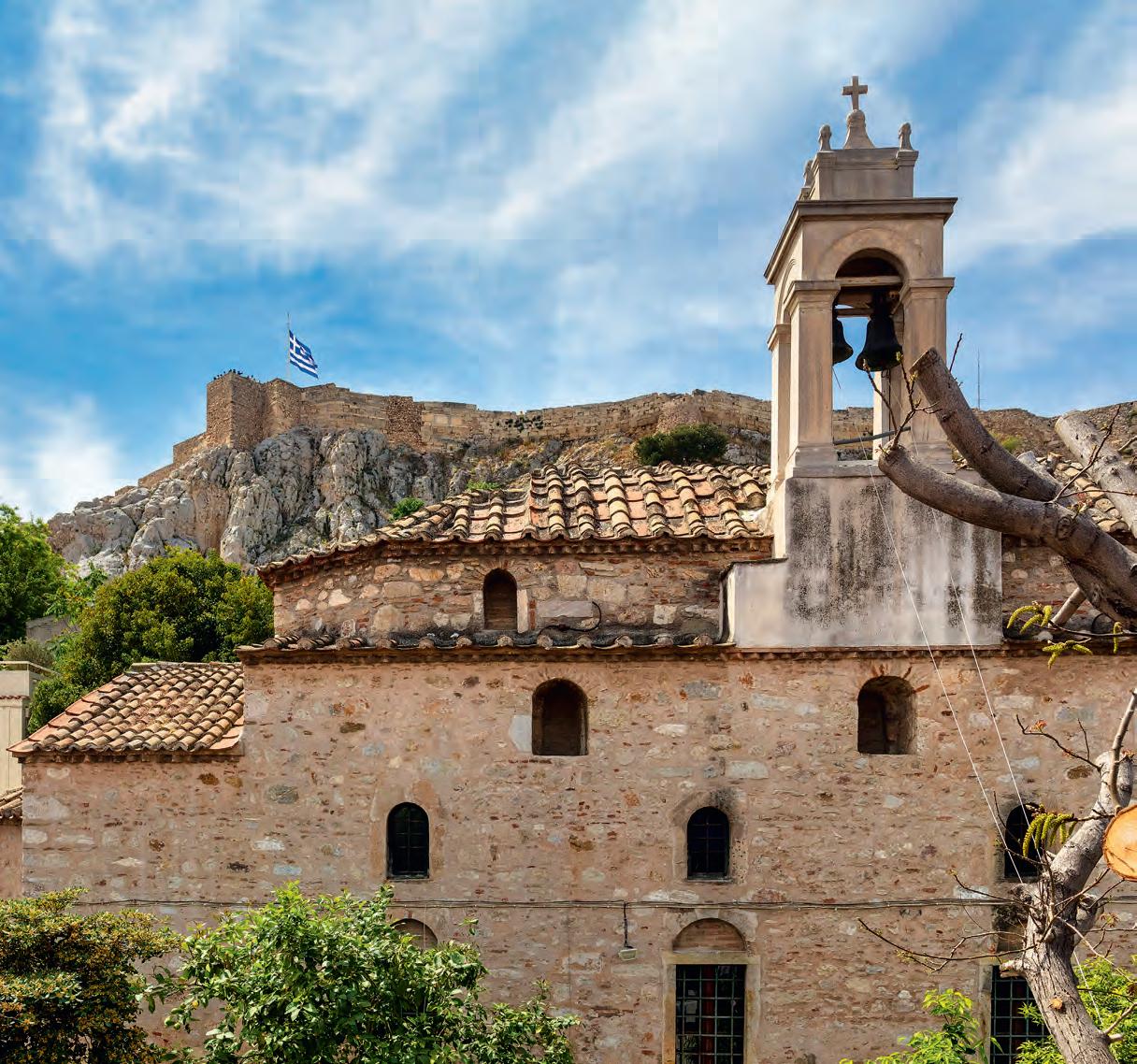
(“The Metochi of the Holy Sepulchre”)
A ten-minute walk from the Acropolis in the direction of Plaka will bring you to one of the most important churches in modern Athens, the Metochi of the Holy Sepulcher, also dedicated to the Anargyroi (Saints Cosmas and Damian). This post-Byzantine church, constructed in the 16th or 17th century on the site of an ancient temple of Aphrodite,
combines some characteristics of the architecture of mosques in the construction of the roof, something not uncommon in Athens at that time.
Inside the church and around the yard are several ancient pieces, including columns and capitals. “It’s hard to know where any of these objects came from,” says Pallis, as, basically, they could be
found anywhere in Athens and might have been reused many times. This practice continued until the 19th century, when pieces with inscriptions and sculptures began to be protected. In its early years, the church also served as a convent, and members of a wealthy Athenian family were buried on the grounds as well.
At the foot of the northern slope of the Acropolis, right next to the Canellopoulos Museum, sits another church dedicated to the Transfiguration of the Savior. Built between 1050 and 1150, this little church is believed to have once belonged to a family, as inside there are grave plots. “This church has quite a few and very interesting spolia,” says Pallis. “These architectural members are second-hand, of course, and the four columns and the capitals are all reused material. All of them are probably from Roman buildings.” This church was expanded on its east and west sides, so only the central parts of the north and south sides remain unchanged.
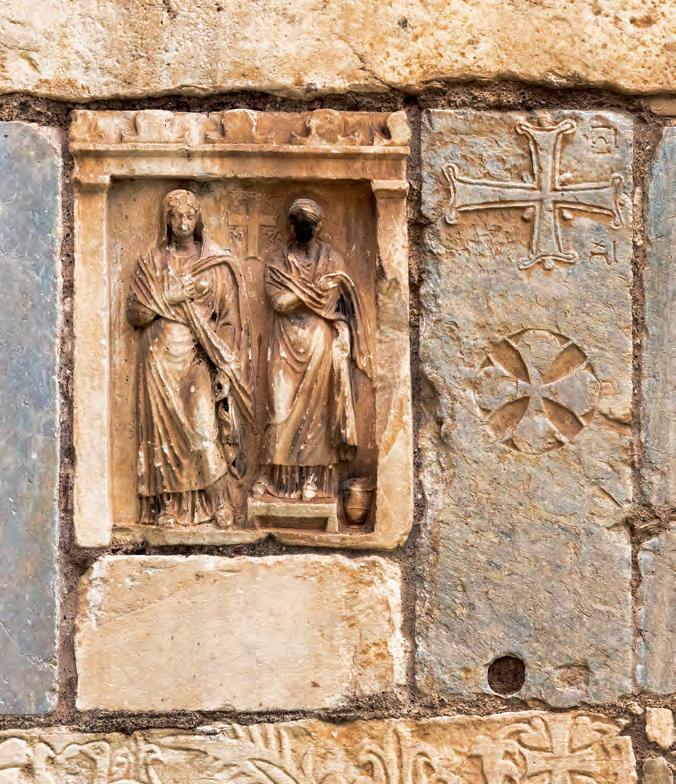


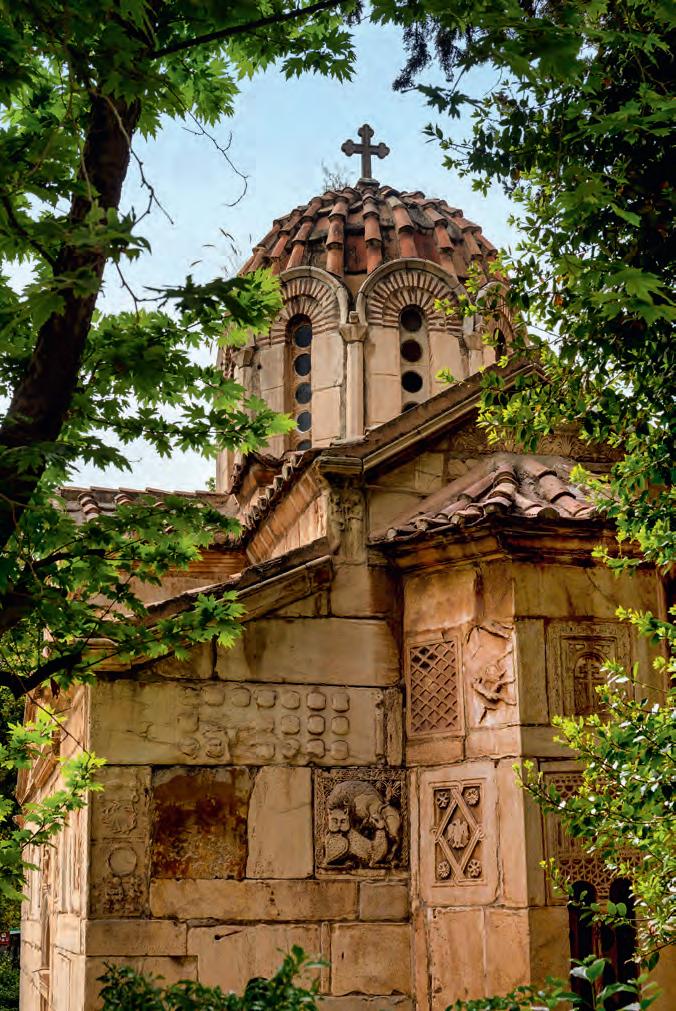
The Church of Panagia Gorgoepikoos and Aghios Eleftherios (“The Little Metropolis”)
One of the greatest examples of the use of spolia can be found in the Church of Panagia Gorgoepikoos and Aghios Eleftherios, also referred to as “the Little Metropolis,” next to the Metropolitan Cathedral of Athens. “This is a building made entirely of marble,” says Pallis. Constructed in the 11th or 12th century, the church was built on top of the ancient temple of the goddess of childbirth, Eileithyia. As described by the Archdiocese of Athens, the walls are built with “isodomic marble
blocks, which come from ancient monuments, while in the upper parts of the building 90 ancient Greek, Roman, early Christian and Byzantine reliefs were used.
The breastplates with the relief representations … were built into the wall in such a way as to form an impressive frieze, which runs around all sides of the building.”
The relief on the western facade of the temple shows the Attic calendar, which is basically the seasons of the year depicted with human figures and their occupations.
According to Pallis, this could be
a collection someone had already formed or one compiled from pieces from elsewhere for this express purpose. Either way, this little church resembles an ancient temple, which would have been very familiar to the people of the time, who used them to perform Christian services. The Parthenon, the Temple of Hephaestus, the Temple of Artemis Agrotera and other ancient Greek temples were all transformed into churches, and some of them remained as such until the era of Ottoman rule in Athens.

One of the most impressive churches in downtown Athens is one that usually goes unnoticed. The Church of St John of the Column, in Psyrri, which was constructed during Ottoman times, took its name from the ancient column with a Corinthian chapiter that stands in the sanctuary and protrudes from the roof.
The old Athenians believed
that John the Baptist could cure anyone from sickness. According to the Greek historian and academic Dimitrios Kampouroglou, Saint John “in his last days erected a column, and at its foundation he tied all the illnesses with silks of various colors, and he buried them deep there and on top of them he placed a column and said: ‘When I am about to die, whoever falls ill
should come and tie three knots of silk on the column, in whatever color his illness is, and say three times: “My Saint John, I bind my illness and may your grace untie it,” and they will immediately be cured.’ This is connected to beliefs that probably developed in the Middle Ages, which attributed to columns some supernatural powers, Pallis explains.
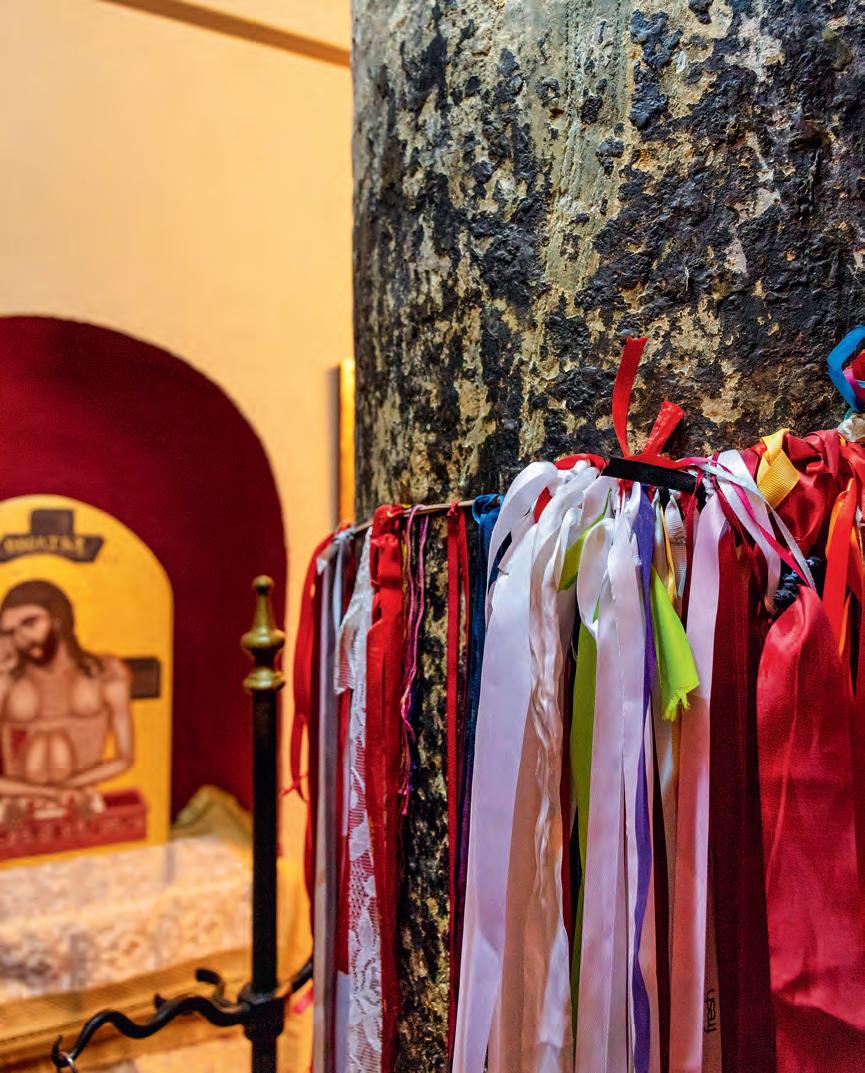

FROM TEMPLES AND FESTIVALS TO FRONT DOORS AND DINNER TABLES, THE GODS WERE PART OF EVERYDAY LIFE IN ANCIENT GREECE.
BY JOHN LEONARD ILLUSTRATIONS: ANNA TZORTZI

TTHE ANCIENT GREEKS’ complex pantheon and rich repertoire of myths and heroes remains a timeless, beloved subject. One of the favorite exhibits in the Acropolis Museum is a humble pair of modern reconstructions of the Parthenon’s east and west triangular pediments with their myth-related sculpture groups, located in the vestibule of the top-floor Parthenon Hall. Visitors can regularly be seen flocking around these small-scale models, trying to distinguish who the diminutive sculpted characters are and to make out the story they are telling. Clearly recognizable are Greek gods, goddesses and other mythical beings, here portraying the Birth of Athena and the Contest between Athena and Poseidon. But what did these divine figures actually mean to the ancient Greeks? And what was the cultural or societal importance of their collective narratives? The nature of such questions goes to the very heart of archaeology, history and art history. In present-day studies of ancient Greece, impressive architectural remains and archaeological artifacts on their own are not enough. What we really want to understand is how ancient people lived, what they were thinking, and how they felt about and reacted to their world. Anthropomorphic sculptures in particular, such as those of the Parthenon’s pediments and frieze, seem to stir our curiosity, as ancient Greeks and their gods look so much like us, so identifiable, often dealing with many of the same life issues and problems that we do. Their world was markedly
different, however, separated from ours by two millennia, with distinct cultural values, ideas and beliefs, all operating in a natural environment far more pristine and integral to daily life than our own. In the realm of religion, virtually everything in an ancient Greek’s surroundings was perceived through the lens of the gods: divine spirits who dwelt and freely roamed among their mortal dependents, governing, protecting, influencing and enriching the human experience.
Although today we recognize that the central pillars of the ancient Greek pantheon were the Olympian gods –Zeus, Hera, Poseidon, Athena, Demeter, Aphrodite, Ares, Apollo, Artemis, Hephaistos, Hermes, Dionysus, and possibly Hestia – these familiar deities were universal in Greek culture primarily in the sense of their being Greek, as opposed to foreign, non-Greek gods. That is, from the outside looking in, the Olympians appeared to be general figures worshiped commonly by Greeks. However, inside the Greek cultural sphere, the gods were mainly characterized throughout the Greek world’s disparate regions not by commonality or uniformity, but by specificity and diversity. Just as ancient Greece was a geographical area of distinct, varied terrain, so too were its peoples, within their respective regions and city-states, diverse in their self-determined ethnic and political identities. Thus, within each community, the citizens had their own gods, goddesses and heroes that were considered distinct from those of their neighbors and belonged to that community.
Gods were “shared” figures only at specific places and under specific circumstances – particularly in Panhellenic sanctuaries, such as Olympia and Delphi, where Greeks from far and wide gathered, worshiped together, and sacrificed to each other’s gods on the same altars.
On a civic or state level, every city had their own divine patron that protected the city-state and encouraged its people. In 5th-century BC Athens, for example, Athena was the great patroness. In Sparta, it was Artemis and Apollo; in Thebes, Dionysus and Apollo; in Argos and Samos, Hera. For the Athenians, Athena supported and represented (through her own attributes) their various interests, ambitions and industries. As the warrior goddess, she emboldened the city-state’s military and imperial aspirations. As the goddess of wisdom, she inspired the city’s sage philosophers and other thinkers. Through her vital gift of the olive tree, meanwhile, she promoted Attic agriculture by encouraging farmers to cultivate a remarkably versatile crop. The olive tree provided not only nourishing fruit and calorie-rich oil but also fuel for lamps and wood for winter fires. Olive oil, in particular, was indispensable: athletes and others used it for personal hygiene; physicians for healing remedies; and early pharmacists and perfumers for cosmetics, unguents, and aromatic scents. It was also a key commodity for trade, and it played an important role in religious rituals: in the anointment of kings, of gods in mythology, and of the dead before burial.
No wonder the olive tree, with all its practical benefits for Athenians, featured prominently in the mythical contest between Athena and Poseidon over who would become Athens’ patron deity. The sea god’s gift of brackish spring water could not measure up to Athena’s arboreal offering. As ancient visitors ascending the Acropolis emerged from the Propylaia, Pericles’ sculpturally adorned Parthenon rose before them, crowned with its triangular western pediment showcasing Athena’s victory. Directly ahead also towered Pheidias’ 9m-tall bronze statue of the warrior Athena (“Promachos”), who had recently aided the Athenians in suppressing the Persians. The 2nd-century AD traveler

... ANCIENT GREEKS AND THEIR GODS LOOK SO MUCH LIKE US, SO IDENTIFIABLE, OFTEN DEALING WITH MANY OF THE SAME LIFE ISSUES AND PROBLEMS THAT WE DO.
Pausanias reports: “The point of the spear of this Athena and the crest of her helmet are visible to those sailing to Athens, as soon as Sunium is passed.”
Poseidon, however, held pride of place not only beside Athena in the Parthenon’s pediment, but also in the adjacent Erechtheion, the singular Periclean temple that gathered the Acropolis’ main traditional cults under one roof. Pausanias again relates: “Before the entrance is an altar of Zeus the Most High … Inside the entrance are altars, one to Poseidon, on which … they sacrifice also to Erechtheus, the second to the hero Boutes, and the third to Hephaistos.” Poseidon was revered in Athens – as at Corinth and Isthmia, coastal locations – due to the sea playing a major role in daily Athenian life, political and naval outreach, and economic activity. His most prominent temple stands in southern Attica, high on Cape Sounion. Erechtheus was the legendary king and founder of Athens, whose divine father was Hephaistos. Boutes’ recognition stemmed from his being the heroic eponymous ancestor of the Boutadai and Eteoboutadai, noble Athenian families that provided the priestesses for the cult of Athena Polias (of the City). Adjoining the west side of the Erechtheion was a shrine to Pandrosos, a daughter of Athens’
mythical king Kekrops, who had been entrusted by Athena with safeguarding the infant Erechtheus.
State cults on the Acropolis also included the worship of Artemis Brauronia, from Brauron in east Attica, who was given her own small sanctuary just south of the Propylaia. Artemis was revered in Athens as the goddess of good counsel; sacrifices were offered to her before every meeting of the Ekklesia (“People’s Assembly”). Athena Nike (“Victory”) similarly had a small temple above the Acropolis entrance. She represented, and her temple’s sculpted decoration commemorated, Athens’ military might and great triumphs.
Around the Acropolis, numerous other deities were worshiped by ordinary Athenians in small open-air sanctuaries and caves. The people of Athens, Pausanias observed, “are far more devoted to religion than other men.” Shrines on the South Slope included those of Aphrodite Pandemos (“Of All the People”), Nymphe (a local protectress of marriage and wedding ceremonies), Asclepius (god of healing), and Dionysus (god of wine, religious ecstasy and theater). The sanctuary of Asclepius with its sacred spring also marked a spot, as indicated by an

inscription (1st century BC), where honors were given to Hermes, Pan (god of the wilderness and of pastoral music), Aphrodite (goddess of erotic love), the Nymphs (representing nature), and Isis, a Hellenized Egyptian goddess of mourning and magical healing. The Dionysus Theater was only one part of the god’s sanctuary, which included a small temple and altar. On the North Slope were caves sacred to the Furies (deities of vengeance), Pan, Zeus Olympios, Apollo Hypoakraios (“Under the High Rocks”), Aphrodite Ourania (“Heavenly”) and Eros (god of love). On the east side, in the largest of the Acropolis caves, was the shrine of Aglauros, another of Kekrops’ daughters, who’d sacrificed herself for the city.

AROUND THE ACROPOLIS, NUMEROUS OTHER DEITIES WERE WORSHIPED BY ORDINARY ATHENIANS IN SMALL OPEN-AIR SANCTUARIES AND CAVES. THE PEOPLE OF ATHENS, PAUSANIAS OBSERVED, “ARE FAR MORE DEVOTED TO RELIGION THAN OTHER MEN.”
In the Athenian Agora, the city’s central square and marketplace, archaeological excavations have unearthed about 300 figurines of Aphrodite, as well as jewelry adorned with depictions of ever-popular Eros. A wide range of other objects and structures also illuminate the importance of the gods and their regular role in ancient daily life. Temples and stoas were dedicated to Apollo Patroos (“Fatherly Protector of the People”), Zeus Eleftherios (“Liberator,” “He Who Gives Bountifully”), Ares (god of war), and Demeter (goddess of the harvest and fertility).
On the Acropolis and in the Agora, statuary, reliefs carved on steles, painted vases and wall paintings depicting gods were common signs of devotion. Large statues of Apollo and Themis (“Justice”) have been found in the marketplace, while Hermes (god of trade, commerce, thieves and travelers) was a particularly favorite subject on painted containers. Numerous herms (steles featuring Hermes’ head and male genitalia) marked the area of the crossroads (“The Herms”) at the Agora’s NW corner.
Hestia (goddess of the hearth) was worshiped with Zeus in the Bouleuterion (Council House). The adjacent Old Bouleuterion became the Metroon (late 5th century BC) – a shrine to Rhea, mother of the gods, who was the protector of Athens’ Boule (Council of 500) and its city archives. In the nearby Stoa of Zeus Eleftherios, Pausanias saw a mural depicting divine Demokratia (“Democracy”) and Demos (“People of Athens”), as well as a statue of Eirene (“Peace”) holding the infant Ploutos (“Wealth”) near the monument to the Eponymous Heroes, symbolic representatives of the ten Attic tribes.
Demokratia also appeared in a relief-carved scene at the top of a stele inscribed with a decree against tyranny passed in Athens following the Macedonians’ victory at Chaeronea (338 BC). Discovered beneath the Stoa of Attalos, the relief shows the goddess placing a crown on the head of Demos.
It was probably knocked down in 322 BC when the Macedonians eventually seized Athens.
In public, Hestia was worshiped in the Prytaneion in particular, a multi-purpose building that served as the Archons’ official residence and provided VIPs with meals at state expense. It also held the city’s symbolic central hearth and ever-burning sacred fire. Statues of Eirene and Hestia were placed there, according to Pausanias. Despite archaeologists’ past uncertainty, the Prytaneion is believed today, based on convincing new evidence, to have stood east of the Theater of Dionysus and Cave of Aglauros, beside the Street of the Tripods, near Athens’ original pre-Classical agora.
Altars for offerings and sacrifices were another common feature in Athenian public spaces, located primarily outside temples. The Altar of the Twelve Gods, near the Agora’s northwestern Zeus stoa, stood inside a small walled area so respected by authorities and the public that it served as a place of asylum for supplicants and refugees. In the later Roman Agora, Pausanias informs us, were four altars of Eleos (“Mercy”), Aidos (“Shame/ Modesty”), Pheme (“Rumor”), and Horme (“Impulse/Effort”).
The Temple of Hephaistos, on the western hill overlooking the Bouleuterion, marks a district once inhabited by Athens’ metalworkers, whose divine protectors were Athena Ergane (patroness of artisans) and Hephaistos (god of the forge). Both deities were worshiped in the Hephaisteion, each with their own cult statue in the cella; the heroes Herakles and Theseus were prominently displayed on the temple’s eastern metopes. Theseus also appeared in wall paintings in the Painted Stoa and the Stoa of Zeus Eleftherios, and had his own sanctuary east of the Acropolis somewhere near the Prytaneion.
More than one hundred days were designated as sacred or festival days in ancient Athens. The first eight days of each month were dedicated to particular deities or heroes, including the Agathos Daemon (“Good Spirit”), Athena, Herakles, Hermes, Aphrodite and Eros, Artemis, Apollo, Poseidon and Theseus.
THE ALTAR OF THE TWELVE GODS ... STOOD INSIDE A SMALL WALLED AREA SO RESPECTED BY AUTHORITIES AND THE PUBLIC THAT IT SERVED AS A PLACE OF ASYLUM FOR SUPPLICANTS AND REFUGEES.
Among Athens’ major and minor festivals were the Plynteria and Lesser and Greater Panathenaia (for Athena); Boedromia (for Apollo); Adonia (for Aphrodite and Adonis); the Lesser and Greater Eleusinian Mysteries; Thesmophoria (for Demeter and Persephone); and Epidauria (for Asclepius). There were also the Rural and City Dionysia, Lenaia, Anthesteria (for Dionysus); Diasia and Olympieia (for Zeus Meilichios and Zeus Olympos); Elaphebolia (Artemis); Thargelia (Apollo, Artemis); and Diisoteria, an end-of-year celebration for Zeus Soter (“Savior”) and Athena, with a final thanksgiving sacrifice to Zeus and a welcoming of the new year on the last day. Each festival had its own meaning and special rites. Activities included processions, ritual purification and sacrifices, wine-drinking, wreath-making, preparing special cakes and other foods, athletic games, theatrical contests, horseback-riding contests and regattas off Piraeus.
When not erecting votive statues or making other offerings in sacred or public spaces, Athenians and other ancient Greeks followed their beliefs privately within their households. Diversity ruled here as well, since each family worshiped their respective ancestors and had their own preferred family cults. The father was essentially the family priest, while women might serve as priestesses and cult attendants outside the home. Domestic devotion centered on the family hearth and fire, although revered images and shrines were customarily placed at various key points in or around the house and family property. Prayers, votive offerings and sacrifices were made at small altars, using figurines and other representations of those being honored. These acts sought divine favor regarding the family’s health, births, deaths, marriages and continued well-being.
Besides Hestia, household gods included Zeus Ktesios, Zeus Meilichios, and the Agathos Daemon – deities associated with protecting family prosperity and often chthonically symbolized by a snake – a not-uncommon sight around ancient homes. Zeus Ktesios might also be invoked via a “kadiskos,” a small two-handled sacrificial jar filled with household foodstuffs. The Agathos Daemon occasionally appeared in art as a young man carrying a cornucopia or other items symbolic of fertility. Before and/or after meals, libations were made to Hestia, Zeus Soter, the Agathos Daemon, or Dionysus.
Outdoors, tutelary images of Zeus Herkeios (“Protector of the Courtyard”) were placed between the house and its enclosing wall, while Hermes (protector of doorways), Hekate (protector of crossroads), and Apollo Agyieus (“Protector of the Streets”) had small apotropaic shrines at the gate or in front of the house.•


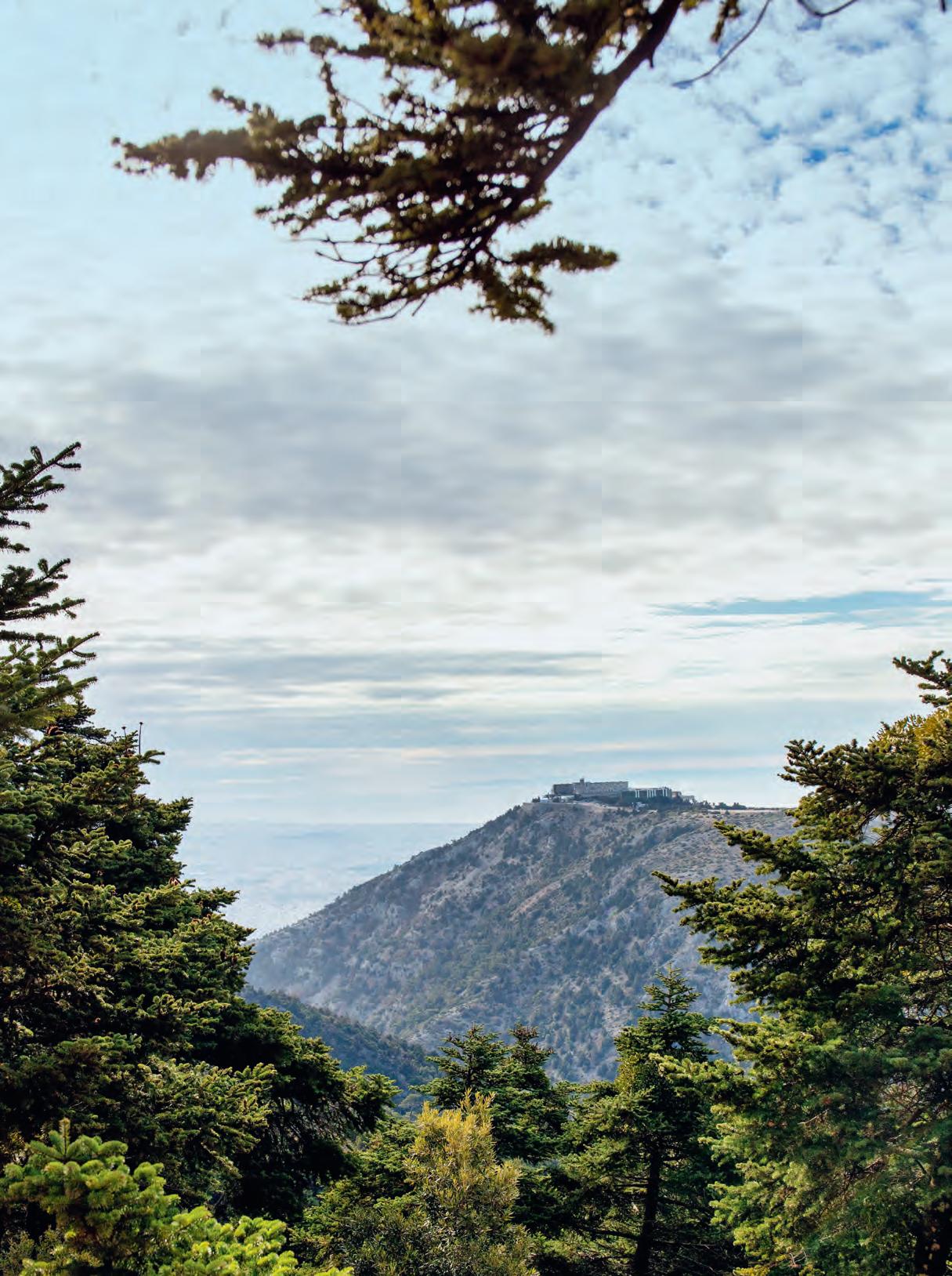
Parnitha Casino, as seen from one of the many spots that offer breathtaking views.
permanent residents of the region.
Just 40 minutes from the heart of Athens lies the city’s beloved mountain, offering visitors an unexpected and enchanting aspect of Attic summer.
BY GIORGOS PSOMIADIS
PHOTOS: PERIKLES MERAKOS


Those who choose to explore Parnitha by bike can follow a 16-kilometer circular route.
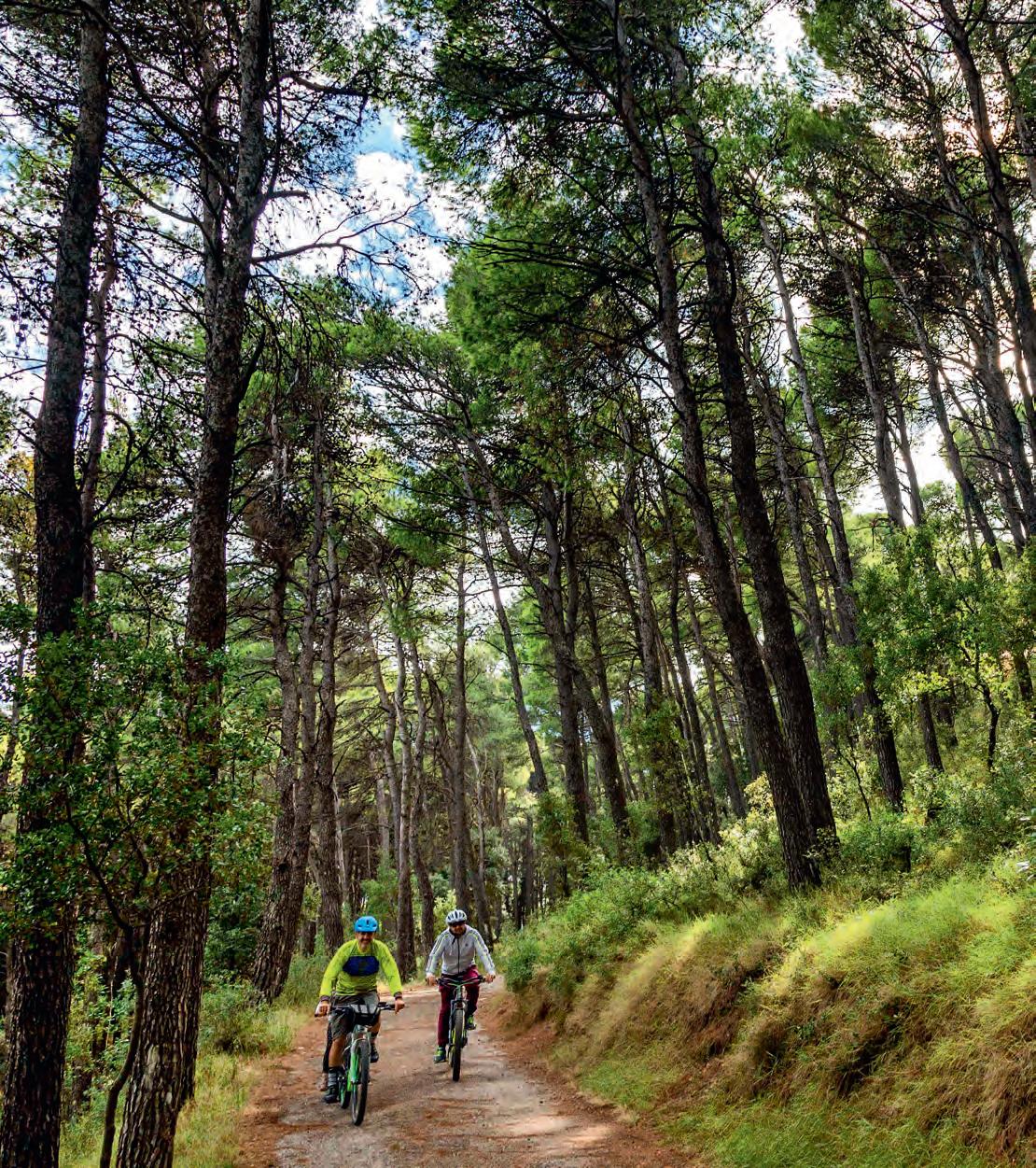

CCLASSICAL MONUMENTS, culinary surprises, vibrant neighborhoods that never sleep – these are just some of the elements that make a visit to the Greek capital unique. But there’s another, lesser-known side to the Athenian summer that few think to explore. In case you didn’t know, just 40 minutes from Syntagma Square lies Mt Parnitha.
At over 1,000 meters above sea level, far from the traffic and buzz of the city center, a different kind of Greek summer awaits. Here, the air is crisp and pinescented, the forest paths wind through lush greenery and sun-dappled clearings, and tiny chapels and freshwater springs seem to appear as if by magic. From the mountain’s many vantage points, you’ll take in sweeping views of the Attica basin and, if you’re lucky, you might even catch a glimpse of the mountain’s most famous resident, the majestic red deer, as it pauses just long enough to meet your gaze before disappearing into the woods, leaving behind the most unexpected memory of your trip.
According to myth, the goat-legged god Pan often came to Parnitha to play his flute and dance through the forest. You can almost picture him hiding behind the trees or prancing playfully along the trails. Now part of the EU’s Natura 2000 network, this landscape has suffered greatly in recent times. Three major wildfires (in 2007, 2021 and 2023) have each left their mark, still visible from the lower slopes.
In winter, a shroud of mist often covers the mountain slopes; rain runs
into clear forest ponds and mushrooms pop up between rocks. But from spring onwards, the scene changes. The fresh green tips of fir branches glow in the sunlight, wildflowers and cyclamens blanket the ground, and the trails fill with sweet, earthy scents. In many shaded spots, where the firs form natural canopies, temperatures can be up to 10°C cooler than in the city.
Above 800 meters, the slopes are covered with Cephalonian fir trees (Abies cephalonica), a species native to Greece. You'll also find pines lining the ravines, along with junipers, strawberry trees and more than 1,100 other plant species and subspecies out of the 6,000 found nationwide. Three of these are exclusively found on Mt Parnitha.
At elevations of 1,161 and 1,158 meters respectively, two mountain refuges – Bafi and Flabouri – welcome visitors year-round with home-cooked meals and overnight accommodation. Giannis Chelis, who runs both lodges and lives on the mountain with his family, also leads guided hikes and cycling tours with Trekking Hellas. A perfect guide, he might just know the secrets of the mountain better than anyone, its scars and wonders alike.
Mt Parnitha offers a wide network of safe and well-marked trails, suitable for all levels of hikers and physical conditions. During the summer months, it’s important to check the website civilprotection.gov.gr a day before your excursion; when high winds and extreme heat increase the risk of wildfires, the mountain may be temporarily closed to visitors – a fairly common occurrence in July and August.
To reach the Bafi Refuge, where Giannis Chelis and his team await, you’ll first pass through the municipality of Acharnes. Here, traditional tavernas and modest buildings set a more rural tone for your adventure. Given the summer heat, early morning or late afternoon are the best times to head out.
IN MANY SHADED SPOTS, WHERE THE FIRS FORM NATURAL CANOPIES, TEMPERATURES CAN BE UP TO 10°C COOLER THAN IN THE CITY.
There are two ways to ascend the mountain. One is the cable car that transports visitors to the Mont Parnes Casino; it’s free to use and operates regularly with only rare exceptions (which you can confirm by calling ahead). The ride offers spectacular views, but there’s an additional 40-minute hike from the upper station to the refuge. The other option is to drive a bit further and make a detour at the haunting Park of Souls, located opposite the abandoned Xenia Hotel. Built in the 1910s, this eerie structure originally served as a sanatorium for tuberculosis patients before becoming a hotel and a school for tourism professionals. After it closed in 1985, it remained empty, its crumbling frame reflecting the passage of time.
Across from the derelict building there once stood a collection of wooden sculptures, inspired by the stories of former patients and carved in 2012 from scorched tree trunks by the artist Spyridon Dasiotis; only one such sculpture remains today, along with a striking metal angel added later. It’s still an impressive scene, and serves as a ghostly yet poetic welcome to the mountain.
If you’re lucky, you might spot a deer descending to drink from a lower spring. In recent years, wolves have reappeared in Parnitha, pushing many deer to migrate elsewhere, but signs of their presence remain. Keep your eyes peeled for a “rubbing tree,” a trunk where male deer have scraped their antlers when shedding velvet to make way for new growth. (In the end, it may be the wolves that end up leaving. An official tasked with animal protection has called for their relocation.)
Some of the most accessible hiking routes on Mt Parnitha connect the Bafi and Flabouri refuges, which are just 3.5 kilometers apart. Right next to the Flabouri refuge, where you can enjoy a hearty homemade meal at a wooden picnic table, you’ll find Flambouraki
Peak. Here, a Greek flag flutters in the wind above the Attica basin. The neighborhoods of Athens glimmer in the light, the sea shimmers in the distance and, if the sky is clear, you might even spot Marathon Lake and the island of Evia far beyond. You might also run into Gela, a stray dog who has become something of a local mascot.
Enjoy the crisp oxygen-rich air as you continue to your next stop: Mola, one of the few patches of forest to have survived recent fires wholly untouched. The small chapel of Aghios Petros –one of many in the area once built by shepherds – marks your arrival.
Carry on walking and you’ll find an idyllic setting: tall trees, sunlit clearings perfect for picnics and play, and wooden benches where you can rest. Mola is also a key junction for many
trails. One of them takes you around the mountain to the Skipiza fire lookout, built in 1990, and its nearby spring. Note, however, that Skiriza and nearby Chouni are demanding destinations, suitable for more seasoned hikers.
If you do choose to come here from Bafi, you’ll be able to witness fir trees sprouting again in previously scorched areas. As you move deeper into the forest, you’ll note the richness of the flora and sweeping views that stretch all the way to the peaks of Mt Parnassus in Central Greece.
For cyclists, there’s a 16-kilometer circular route that begins at the Bafi refuge as well. It’s an easy ride that takes you through ever-changing scenery and showcases the mountain’s natural beauty from a different perspective. Regular or electric bikes and related equipment can
be rented from Giannis Chelis.
Whichever route you choose, you’re sure to leave Parnitha with vivid memories of this wild and wildly beautiful place, scenes that will stay with you long after your return. From the morning sun streaming through the fir branches to the sight of Athens gleaming beneath you at dusk, these summer memories will be unlike any others. And as you make your way back down, you might even figure out what the god Pan was looking for on these ancient forest paths.•

EXPLO R E MO R E:
SELECTED A R TICLES F R OM OU R WEBSITE

THE PANATHENAIC WAY: ATHENS’ HISTORIC PATHWAY COMES ALIVE AGAIN
A major restoration project is bringing new life to the historic route that once led Athenians from the heart of the city to the Acropolis.
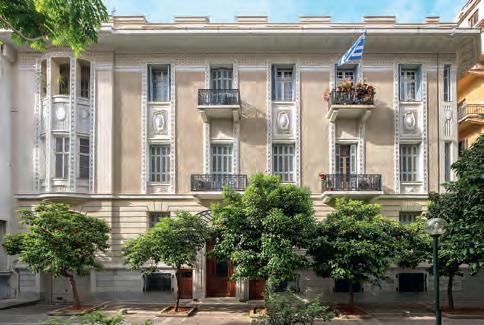
INTERWAR ATHENS: A JOURNEY THROUGH ARCHITECTURAL TRANSFORMATION
We join archaeologist and MONUMENTA coordinator Eirini Gratsia on an inspiring journey through Athens, as she reveals the fascinating stories behind the city’s iconic interwar buildings.

7 FREE BEACHES FOR SUMMER SWIMS NEAR ATHENS
As temperatures rise, we’ve compiled a list of the best free beaches near Athens for a refreshing break from the heat.

EXPLORING ATHENS’ TIMELESS TREASURES AT MONASTIRAKI
Antiques expert and collector Dimitris Xanthoulis takes us on an Athenian treasure hunt, sharing insights into hidden gems and age-old rituals.
Οrder back issues now at: subscription.kathimerini.gr/greece-is
Pay only shipping & handling.
FOLLOW US

